How to Spot a Bargain

to maximising income?


How to Spot a Bargain

to maximising income?

At My Home Move Conveyancing, we know how stressful moving home can be, and we know how confusing it can appear. That’s why we’re here to guide you through your home-moving journey and make your move as simple as possible.
Combining the ease of a digital service with the personal touch of a dedicated Move Specialist, we’ll take the time to understand what’s unique about your move, so we can give you a personalised conveyancing quote. Once you’re happy with that, our tailored approach means we’ll place you with a dedicated conveyancer from one of our CLC or SRA regulated partner firms that fit your specific requirements. We can also help arrange a RICS survey, sorting insurance for your new home, and even with removal van hire and change of address services. And if things don’t work out as planned, we offer a no-move, no-legal-fee guarantee.
We know how important it is for you to have complete transparency and have control over your move. That’s why all of our partners have online conveyancing journeys, so you can track the progress of your case whenever you like. And you’ll have 24/7 support from us via phone, email and messaging services.
Thousands of movers have trusted us to help them move, and with transparency, care, and innovation at the heart of everything we do, we’ll ensure that your home move journey starts with ease and ends with confidence.


Hi, it’s Martin Roberts - him off the telly! - welcoming you to Property & Home, your unmissable guide to buying, renovating, improving and selling property.
There’s nothing more certain than uncertainty, what with new governments in the UK and US, a budget which raised lots of questions about businesses and inheritance, and bizarre weather conditions threatening properties all over the world!
The good thing about the property market is that people will always need somewhere to live - in my work on Homes Under the Hammer, a programme I have been privileged to be associated with for over 20 years, I still see opportunities everywhere. Many first-time investors are finding that with hard work and some expert knowledge, they can make the property market work for them.
So, whether you need advice on property law, how to cope with changes in the energy market, how to refurbish your property or where to find finance, you’ll find useful advice in this fact-packed
issue of Property & Home with Martin Roberts!
Since the increase in energy costs I have been inundated with people wanting to find ways of reducing their bills by making their property more energy efficient, so in this issue we are taking a special look at important money-saving measures such as insulation and double glazing, as well as all the choices available in heating technology.
Read my end column for the latest news on my property ventures, and how getting involved in the business can benefit both yourself and the people around you – it’s just another way of showing that the property business is one I still love, through all the ups and downs!
Cheers, Martin




























12 Interview
Martin Roberts tells Chris Jenkins about his latest projects, how you should think about heating your property, and what are the best renovations for adding value
PROPERTY
18 Property Trends
All the news about new products, services and issues a ecting the property market
22 Fruits of Your Labour
With Labour now in government, change is certainly in the air for the UK property market. But what will the new policies mean for property investors
26 Managing the Split
Charles Knapper LLB answers our questions about the legal complexities of property transactions – this time, title splitting
29 The Second Charge
What is a second charge mortgage, why would you need one, and how do you go about getting one?
32 Conveying the Facts
Choose your conveyancer carefully, as a poor job could result in you losing out on a property purchase
35 Lie of the Land
Are your land and property in good shape? A site investigation could reveal all sorts of nasties
38 That Sinking Feeling
So, you’ve had your site survey, and identified subsidence – what can you do about it without major disruption?
41 Building Bridges
Sometimes you need a quick solution to raising finance for a property purchase –could a bridging loan be the solution?
43 Stake Your Claim
The steps we take a er making an insurance claim for property damage can be tricky. Why not have an expert do the job for you?
45 Split to Succeed
Title splitting is the process of dividing the title deeds of one building into two or more. It can be a smart property strategybut how does it work?
46 Baguettes and Bureaucracy
The allure of buying property in France is o set by the prospect of confusing bureaucracy. We take a taste of la vie en































48 Home Trends
All the news about new products, services and issues a ecting the home market
54 The Future of Heating
As gas heating is phased out, we will all have to look at more modern heating technologies, such as the heat pump
58 Get Ahead With a ZEB
What is a Zero Emission Boiler and what can it do for your home? We look at the latest heating technology
61 Finding Thermal Comfort
Heating your home comfortably isn’t just about whacking the thermostat up to maximum. Find out how the idea of ‘thermal comfort’ works
64 Subscribing to the Sun
There are many advantages to solar energy systems, but all come with an initial installation cost. Is there a good way to spread the expense?
67 Cooking With Style
There are many styles of kitchens to choose from, reflecting your personal taste and way of living. We look at some of the most popular
71 Lightbulb Moment
How smart technology can put you in control of your home’s systems without having to install complicated systems









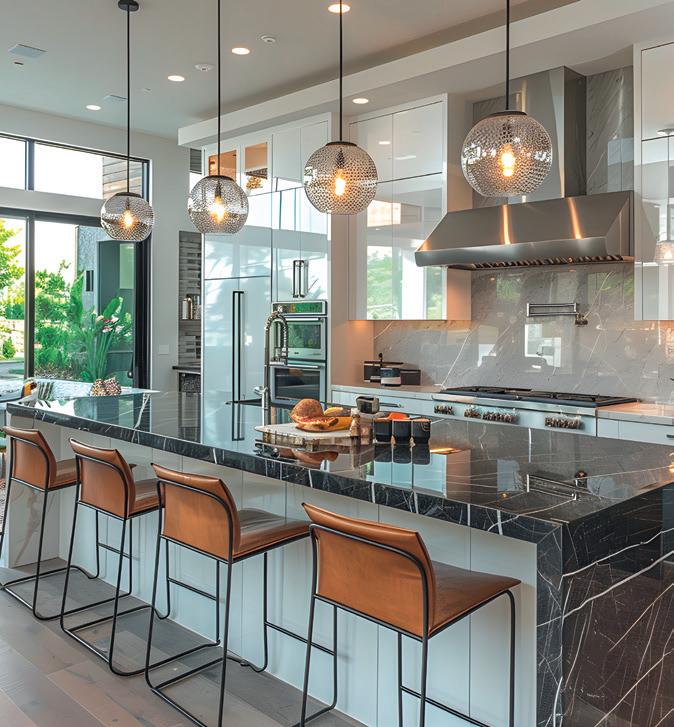
74 Monitoring Mould





Mould, damp and other environmental problems can beset a landlord’s business. What are the risks and how can they be controlled?
79 Vinyl’s Back in Fashion
In fact, vinyl was never out, if you’re talking about flooring. Impressive for its durability and style, it’s the go-to solution for all sorts of flooring challenges
83 Seizing Power
It’s one thing installing solar panels, but another handling the power they produce. We look at some of the associated technology
86 Just Push to Fit
Push-fit plumbing fittings are becoming popular with professionals and DIYers –what’s the appeal?
91 Stay Calm and Insulate
Getting insulated is crucial for both energy e iciency and indoor air quality in buildings. So what do you look for and how do you fund it?
95 Conserve and Protect
Is your conservatory an asset or a worry?
An upgrade to a solid roof might make all the di erence
97 Locked and Loaded
How secure is your house? Insurers, the police and technology companies are all there to help you keep it safe and sound
102 Who’s Watching Your Home?
Security systems are getting more sophisticated, yet easier to install. We look at the latest in CCTV technology
107 Seeing the Light
How can you change the mood of your home using modern lighting? There are all sorts of options to set the scene
109 Getting in a Flap
Fitting a pet flap should be possible even in the most challenging situations. We solve some pussy problems and doggie dilemmas
110 All the World’s a Stage
If you are trying to sell or rent a property, looks are everything. Now a trend known as ‘staging’ makes it easier for you to present your property in a good light
112 Five Top Interior Trends for 2025
Looking for a way to zhuzh up your home and give it an up-to-the-minute interior design style? Here are five suggestions from top interior experts to perk up your parlour and brighten your bathroom
115 Drying Out
Leaks and flooding can be destructive to both property and health. What are the best ways to stave o damp, mould and water damage?


118 What is Your Home’s Interior Design ‘Superpower’?
Every home has an interior design ‘superpower’ – so what’s yours? Some superpowers are obvious, others don’t jump out at you and need to be encouraged.
122 We Are the Robots
They’re not exactly the clunky mechanical men of science fiction, but domestic robots are making their way into many households
126 The Heart of the Home
The kitchen is more than just a place to cook—it’s the heart of family life. How could you make better use of your kitchen?









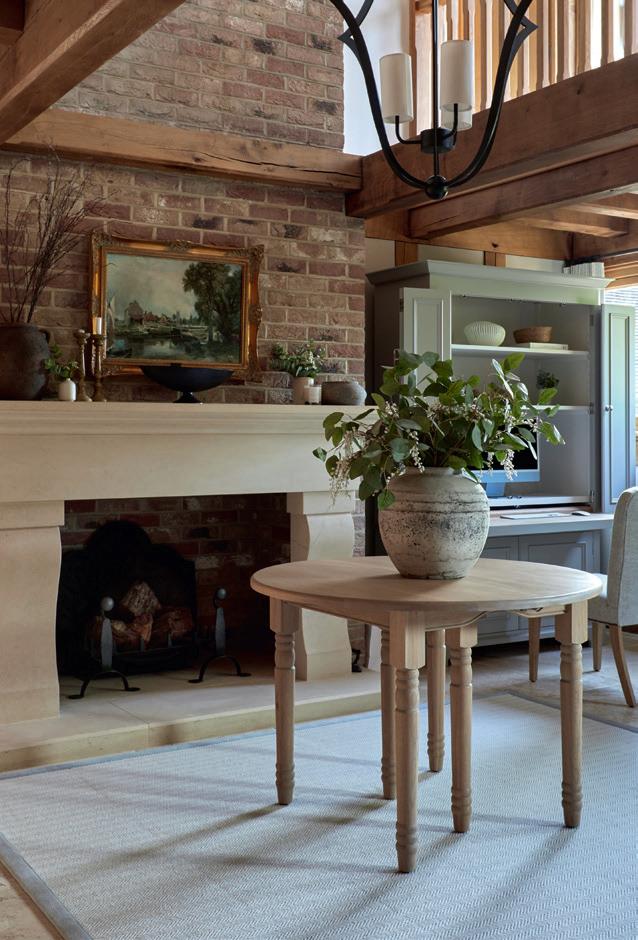

130 Garden Trends












140 Unwanted Guests
All the news about new products, services and issues a ecting the garden market
132 The Winter’s Harvest Gardening in the winter is no easy feat. Look into why this is and how best you can take on the challenge
134 Gi s for Gardeners
Looking for a gi for the gardener in your life? This assortment of goodies would be welcome for Christmas, birthdays or anniversaries – or just to show you care
You can’t always choose who you have to visit you in the holiday season, but the last thing you want is an invasion of pests
142 Greener Living
A garden room can add value and utility to your property. How are they constructed and how could you use them?
144 Firm Foundations
This time, Martin’s plans to rope in his son on some building work turn into a practical idea for starting up a business

PUBLISHER & CEO
Kevin Harrington
EDITOR
Chris Jenkins
SUB EDITOR
Emmanuel Berhanu
CONTRIBUTORS
Grace Bower
Margo Lane
Richard Benson
DESIGN
Joanna Harrington
PRODUCTION
Ray Walsh
PUBLISHED BY
COPYRIGHT © 2024, CELEBRITY ANGELS ALL RIGHTS RESERVED
COVER IMAGE
Martin Roberts
Property & Home with Martin Roberts
Celebrity Angels 143 Caledonian Road
London N1 0SL Tel: 020 7871 1000
For sales enquiries call: 020 7871 1000
All material in Property & Home with Martin Roberts is wholly copyright and reproduction without the written permission of the publisher is strictly forbidden. Products and services included in this publication do not imply endorsement by Martin Roberts. The views expressed in this publication are entirely those of the writers and do not necessarily represent those of Celebrity Angels. The information in this publication is carefully researched and produced in good faith, however, neither the Publisher nor the Editors accept responsibility for any errors. The Celebrity Angels Series is published in the UK under licence by Damson Media Limited. Damson Media Limited is registered in England and Wales under registration no. 07869300.

We are thrilled to announce that Contact Solar has officially joined the EDF Energy family! This acquisition marks an exciting new chapter in our journey, enhancing our ability to provide innovative solar solutions and sustainable energy options to our valued customers.
Founded on the principles of sustainability and innovation, Contact Solar has been a pioneer in the renewable energy sector for 10 years. Our mission is to empower individuals and businesses to harness the power of solar energy, reducing their carbon footprint and achieving energy independence. We pride ourselves on delivering tailored solutions that meet the unique needs of our customers, ensuring they enjoy the benefits of clean, renewable energy.
Our dedicated team of experts works closely with customers to design and install solar systems that maximise efficiency and savings. From domestic homes to small commercial installations, we have successfully completed a wide range of projects, earning a reputation for quality and reliability in the industry.
As the demand for renewable energy continues to grow, solar power remains at the forefront
of this revolution. Solar energy not only reduces electricity bills but also lowers carbon footprints, contributing to a more sustainable future. With the addition of battery storage systems, we can maximise energy efficiency by storing excess energy generated during the day for use during peak hours or when the sun isn’t shining. This combination ensures that our customers enjoy reliable energy, even when grid power is unavailable.
As we integrate our operations with EDF Energy, we are excited about the opportunities that lie ahead. Our goal is to continue delivering exceptional service and innovative solutions that empower our customers to embrace renewable energy.
We look forward to embarking on this journey together and appreciate your continued support as we expand our offerings and capabilities.
www.contact-solar.co.uk www.edfenergy.com www.sunsynk.com









At Contact Solar, we are committed to providing our customers with the best products on the market. That’s why we’ve chosen to work with Sunsynk, a leading manufacturer known for their high-quality inverters and battery storage systems. Sunsynk’s innovative technology ensures optimal performance, durability, and efficiency, allowing us to tailor solutions that meet the specific needs of our customers.


We are proud to offer a range of Sunsynk inverters and battery storage systems designed to enhance energy management and provide peace of mind. With features such as real-time monitoring with push notifications and MPPT (Maximum Power Point Tracking), which allows the inverter to handle a solar array up to twice its size, these products deliver not only energy savings but also a seamless user experience.


Martin Roberts, celebrity guest editor of Property & Home, talks to Chris Jenkins about the best ways to heat your property, how to tackle mould and damp, and the importance of understanding a renovation job – before you start knocking down walls!
From Homes Under the Hammer to I’m A Celebrity – Get Me Out of Here!, Martin Roberts is a familiar presence on TV, radio and online, with his property advice heeded by millions. So what’s his advice for renovating and maintaining a property, and how are his own projects going? Chris Jenkins asks the questions…
WHAT’S THE BEST WAY TO HEAT A NEW PROPERTY OR AN OLDER PROPERTY? IS IT TRUE THAT IT CAN BE HARD TO RELY ON THE CLAIMED HEAT OUTPUT OF SOME RADIATOR SYSTEMS?
If you can start from scratch, there are lots of options available to you, and building regulations mean that insulation will have been installed to the very latest standards,
which will reduce the amount of energy you’re going to have to put into keeping a place warm at the outset.
Obviously, sustainable, renewable and self-generated energy must be a preferred choice and thankfully the cost of those technologies has reduced in recent years. Coupled with an increase in efficiencies they are now a very viable alternative to traditional heating methods. Solar panels can now be linked with battery back-up to give power even when the sun isn’t shining. Air source heat pumps coupled with underfloor heating can provide a sustainable background warmth. If it’s an older property, then your priority should be trying to upgrade the insulation wherever possible and getting rid of sources of heat loss such as draughty windows, large gaps under doors
etc. However, bear in mind that older properties were designed to ‘breathe’ and if you seal these kinds of properties up completely, you may well create other problems such as condensation and damp - so there’s a balance.
Obviously solar power is always an option but replacing older existing boilers for the very latest energy efficient ones can have a dramatic effect on energy consumption. Flushing out radiator systems to make sure that they are free flowing is good practice but be aware that this can also unclog self-sealed leaks, so watch out and check for water loss immediately following any system flushing.
When it comes to heat output, I would always rely on the calculations of a good heating engineer who will take everything into consideration. »




ARE SMART HOMES A GOOD ENERGY SAVING IDEA? DO SMART HOME SYSTEMS ADD VALUE TO A PROPERTY?
The energy performance of a property forms part of the sales particulars and with increasing energy prices, the prospective costs of heating is a big consideration for many buyers so that the higher up the F to A scale your property can be, the better. Smart control systems give the ability to control the heating and therefore the cost of a home in a much more targeted way. They can learn which rooms you spend most time in, be linked to your actual time in the house - switching systems on just
before you come home and switching them o when you leave - in an automated and easily controllable way that can either happen automatically or via an app on your phone.
Clearly, the more control you have the more likely it is that you’ll only be heating the house or part of the house when it’s needed, and the cost savings should o set the costs of installation very quickly.
WITH MOULD AND DAMP IN A PROPERTY?
The first thing is recognising the di erent types of mould and damp that exist because this should be your starting point on the journey to eradicating it. The most serious damp and mould will be caused by significant maintenance or structural issues. That’s not to say that it’s necessarily something complicated.
A huge proportion of these issues are caused by a simple lack of regular maintenance of rainwater goods - such as gutters and downpipes that are blocked, or drains that are clogged with soil and leaves. The basic premise to follow is that the quicker and more e iciently you can get water away from a property, the less
likely it is to cause any serious damage. Such structural damp generally comes either down, across or up. Leaking roofs, failing flashing - especially around chimneys - and the rainwater goods generally result in the downward damp.
Inward or ‘penetrating’ damp can happen on any level of the house and is o en the result of the failure of the exterior coating such as rendering that might have a crack in it, facias that might have cracked or flat roofs where they adjoin the house and where the flashing has failed.
Damp that comes up (o en called Rising Damp for obvious reasons) is the result of the natural wetness of the soil and ground not being blocked from rising upwards. Houses are generally built with a damp proof course which is literally a layer of impermeable material which stops the water rising any further. If this layer of protection fails or isn’t in existence, you need to look at replacing it, which can be done retrospectively with the likes of injection damp proofing.
The above said, a large percentage of damp problems are caused by condensation, and this can be the case in homes of any age, but ironically a serious issue in very modern houses. Inhabitants,


be they human or animal, naturally create moisture either from breathing or bathing, showering or putting on the kettle. This moisture will settle on walls, ceilings and especially anywhere that is slightly cooler than the room temperature. After time this will lead to damp.
The simplest answer is to create a natural air flow which is why building regulations now insist on Trickle Vents in double glazing, having realised that a perfectly sealed house is only storing up trouble. So, in effect, you need to find ways to replace the naturally damp air with fresh, dryer air. Dehumidifiers can help but just letting in some warm outside air can often be a simple solution.
The need for title splitting can occur for various reasons. If you have a large house, say that you want to convert into flats, then each of those subsequent flats will need its own unique reference with the land registry i.e. its own title if the flats are going to be sold or mortgaged individually. Another example could be building or renovating an outbuilding or barn in the
grounds of an existing building. Again, if this new property is to be sold separately or remortgaged it will need its own title.
There are specific rules and regulations regarding title splitting that a good solicitor will be able to guide you through. It’s not necessarily complicated but it does have to be done correctly otherwise you’ll be storing up legal issues for the future.
(See Charles Knepper’s expert column in this issue for more information)
WHAT’S THE MOST POPULAR FORM OF FLOORING FOR VARIOUS TYPES OF PROPERTY? WHAT ARE THE MISTAKES TO AVOID IN CHOOSING FLOORING?
The most important thing to consider when choosing flooring is fitness for purpose. Consider your lifestyle and the inhabitants of your home and think what parts of your property need a floor that is the most resilient and what parts warrant the maximum comfort. I’m a huge fan of, as a first step, finding out what is already in existence once you’ve peeled back the various layers.
To me, with my three dogs and two children, easy maintenance and
durability is a priority, so I’m a fan of stripped floorboards wherever they are of a condition where that’s feasible. The great thing about stripping floorboards is that hopefully they’re there already, so it’s just the time and effort that’s required to renovate them to a usable condition. Obviously stripped floorboards in a modern house may not be an option or desirable from a design point of view.
Floor tiles come in all shapes, sizes and materials but one overriding consideration is whatever you choose must be that whatever they’re being fitted to cannot move or vibrate. You should consider backer boards or specialist matting which you lay underneath the tile to absorb any movement or vibration. Try to pick colours and materials that will not quickly go out of fashion because replacing a tiled floor is never going to be an easy job.
Vinyl floors now come in a wide variety of styles and if laid properly, can look incredible and almost indistinguishable from their natural alternatives. It’s worth getting in the professionals to lay certainly the more sophisticated vinyl flooring, as it can be quite a structured process to ensure longevity. »
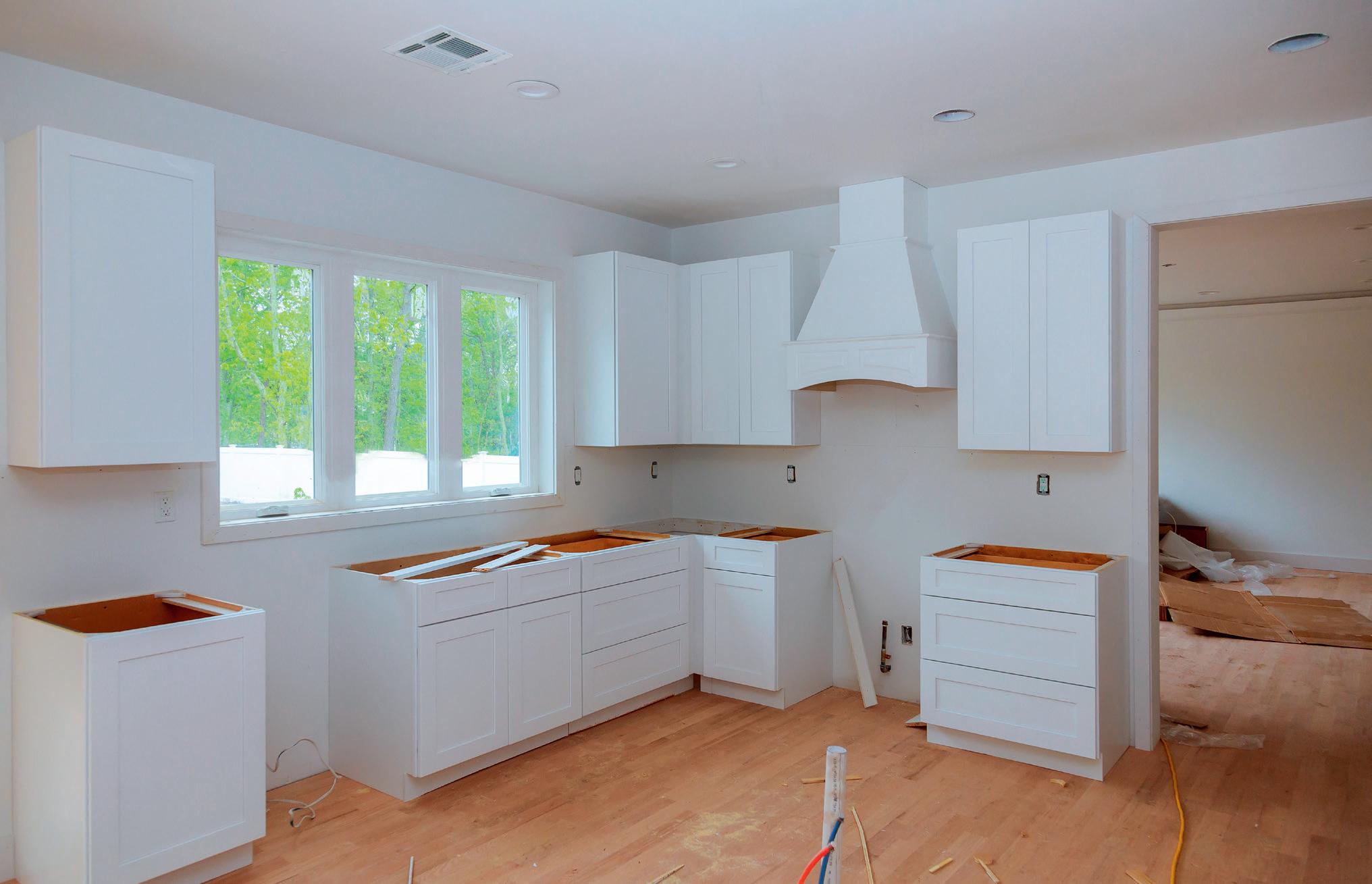
Finally, there are certain rooms where you still can’t beat a carpet - most obviously bedrooms. It’s also worth remembering that carpet so ens the noise of walking in any upstairs rooms.
WHY IS IT IMPORTANT TO GET AN INDEPENDENT SITE SURVEY FOR NEW DEVELOPMENTS OR IN CASES OF SUBSIDENCE?
The more professional advice you can get before you make a purchase or in the process of resolving any issues, the better. The independent view of somebody who does this all the time and will have remedies and words of warning at their fingertips is invaluable. A structural surveyor should be able to o er solutions to even the most severe building issues and will set out a clear process of remedial works that are required.
Even though you might think that a new build property doesn’t require any kind of viewing by an independent observer, sadly that’s not necessarily the case and even with the guarantees that the builder of the
new property should provide, I’d rather walk away from a property where potential future issues have already been highlighted.
DO SECURITY SYSTEMS ADD TO THE VALUE OF A PROPERTY?
I don’t think a valuer would consider the existence or otherwise of a security system. However, it’s something that will potentially save you costs further down the line. A lot of insurance companies will insist on a certain quality of alarm system being installed even if that alarm system isn’t utilised on a regular basis. It’s a ‘nice to have’ and certainly something that would provide peace of mind.
IS IT WORTH INSTALLING A NEW KITCHEN BEFORE SELLING A PROPERTY?
The old adage is that kitchens and bathrooms are the two parts of a property above all others that will influence its saleability, so they should be your priority if you’re looking to maximise sales value. It wouldn’t be unreasonable to suggest that
a kitchen that costs you £7000 to supply and install could add £15-20,000 onto the sales value. It’s also a very quick way to modernise a property and give the feeling that it is up to date.
There’s a huge choice of kitchens available these days obviously from display models that you might find at hugely discounted prices on the internet to professionally designed kitchens that are o ered by the big kitchen supply companies.
Fitting a kitchen is not a particularly easy job and shoddy workmanship will stand out like a sore thumb and could actually be detrimental to the first impression of the property, so if you’re not up to doing it yourself, employing the services of a respected kitchen fitter is money. Clearly somebody like that will also be able to do the job in a fraction of the time it might take you, and bear in mind that since during the refurbishment process you will be without an important part of your home, the quicker it can be done, the better.
HOW MUCH VALUE CAN A GARDEN STUDIO ADD TO A PROPERTY?
WHAT ARE THE CONSIDERATIONS IN SPECIFYING ONE?
Any extra live/work space in a property is highly desirable and if your options for extensions or enhancements to the main building of the property are limited, then a garden construction can be a viable option.
This can range from something that you throw together with a few bits of old timber and a corrugated iron roof to a fully insulated, purpose-built building which is as warm, cosy and liveable as any other part of your property.
O icial valuations may not take into account the full cost of a particularly
elaborate garden studio but there’s no doubt that such a space would add hugely to the saleability and potential sales price of your property.
HOW ARE YOUR VARIOUS PROPERTY PROJECTS GOING AND WHAT PROBLEMS HAVE YOU HAD TO OVERCOME?
My main project currently is renovating an old pub and hotel in the Rhondda Valley in South Wales. It turns out the Hendrewen Hotel had not really been maintained properly for about 150 years, which I didn’t fully understand until I started taking the plaster o the walls to discover all the rotting woodwork and lintels underneath. I also didn’t seem to notice some of the


walls at the back being a bit wonky if you were finickity about vertical angles, but no matter - it all adds to the characterunfortunately also the budget!
However, we are ploughing on and with the help of my trusty team we have completely ripped out and partly refurbished the interior and are soon to commence building the kitchen and toilet extensions.
My biggest problem at the moment is a huge retaining wall at the rear of the property which isn’t doing what the name would hopefully suggest and requires rebuilding, probably at massive expense. So, if you happen to know any Incas or Aztecs that can help (I think they were good at building walls) please get in touch! ■


From modular housing to the state of sales, the latest news and services from the property sector
In 2023, 104,510 people in England were in temporary accommodation, and an estimated 3,898 people slept rough. This is a 27% increase in rough sleeping from the previous year, and the sharpest rise since 2015. With housebuilding failing to keep up with the demand for new properties, what is the solution to the homelessness problem?
In Chelmsford, a project from The Hill Group is suggesting one answer. A new collection of 24 modular DuoHaus homes that will provide accommodation for homeless people is being installed near Chelmsford. DuoHaus homes are innovative, low-cost modular homes designed specifically to support and protect vulnerable residents. The concept was developed by award-winning housebuilder, The Hill Group, as a follow-on housing solution to help address the homeless crisis. Hill is installing the DuoHaus homes to replace an obsolete motel in West Hanningfield near Chelmsford, which CHESS Homeless has been running as a homeless hostel since the start of the COVID-19 pandemic. The project was made possible through support from the government’s Single Homelessness Accommodation Programme (SHAP), Chelmsford City Council, various trusts, grant-makers, individuals, and pro bono
contributions from the teams involved.
Designed with a 60-year lifespan, each DuoHaus home is designed for up to two residents and is built to meet Future Homes Standards, exceeding building regulations for energy-e ciency and sound insulation. They come fully furnished and equipped including a fitted kitchen and white goods, providing a safe, comfortable environment for residents before they find somewhere more permanent.
The 24 DuoHaus homes will be stacked on two levels and each home arrives ready for installation as they are prefabricated by Hill’s manufacturing partner, Volumetric Modular Ltd. The homes are set to be complete and ready for new residents to move in by late spring 2025, just 18 months since this project was first initiated. The development gained planning permission recently and demolition of the former motel building and site groundworks are already underway.
To date, Hill has delivered over 200 SoloHaus and DuoHaus homes to local authorities and charities across the UK, from Su olk to Cornwall. This initiative not only addresses immediate housing needs but also sets a sustainable and replicable model for tackling homelessness nationwide.


More than one in four property sales fell through in England and Wales between July and September 2024, according to new figures. Property company Quick Move Now suggests that 29 percent of property sales fell through before completion in the third quarter of this year. With each failed sale costing an estimated £3,370, the company estimates that failed sales could cost the public as much as £900 million each year. Apparently, the main cause of unsuccessful property sales has been the buyer having di culty securing a mortgage. This accounted for 40% of collapsed sales. A further 27% of failed property sales were caused by the buyer changing their mind or unsuccessfully attempting to renegotiate the agreed sale price. The remaining lost sales were attributed to chain break (14 percent), gazumping (12 percent) and survey issues (seven percent).
Quick Move Now’s managing director, Danny Luke, commented: “People may be surprised by the high number of property sales impacted by di culty securing a mortgage, but there is good reason for it. When sales volumes were lower, only those in a very strong financial position were moving. Higher mortgage interest rates meant much of the market was being driven by cash purchases. Now mortgage interest rates have started to fall, and sales volume is beginning to increase, a greater number of sales are reliant on mortgages…lenders are vigilant to several external factors that have the potential to impact future inflation and buyer a ordability, such as current foreign political uncertainty and global conflicts.”

Looking to make home improvements, consolidate some debt or complete a project? Interbridge Mortgages is a lender that o ers a range of second charge mortgage options, via a network of broker partners, that could help you achieve your ambitions.
www.interbridgemortgages.com/ propertyandhome

GetGround is the all-in-one property investment platform for landlords seeking higher buy-to-let returns with minimal e ort. Access limited company services, accounting and tax, vetted properties, financing solutions, lettings, management, and personalised analytics – all in one place.
www.getground.co.uk

Indomie is one of the world’s most popular brands of instant noodles and has become a leading household name in many countries around the world since its launch in 1984. Products are made from high quality flour, spices and herbs and are fortified with essential vitamins and minerals. chadhaorientalfoods.co.uk/brands/indomie


With Labour now in government, change is certainly in the air for the UK property market. But what will the new policies mean for property investors?

In July 2024, the Labour Party won a general election for the first time in 14 years, promising a change in policies with the end of a long period of Conservative rule. But with the world economic situation making it difficult to forge new pathways, what can the property market really expect in the way of change? Whether it’s to do with housebuilding, inheritance tax, rental laws or building safety, there’s much to anticipate for all property buyers, renters, landlords, sellers and investors.
One of the new government’s more ambitious but top-priority promises is to address the current UK housing crisis by building a total of 1.5 million new homes over the next five years. This sets a target of 300,000 each year. The proposed focus will be on affordable and social housing, particularly addressing the imbalance between supply and demand as the UK’s population continues to grow - currently sitting at just over 69 million people. But property developer Ritchie Clapson says:
“The target of 300,000 new homes per year looks light. The complexity of the issue requires a nuanced approach to meet targets, address public sentiment, and leverage alternative solutions, such as brownfield redevelopment.”
For first-time property buyers, an increase in availability of affordable homes would certainly be a key opportunity to enter the market. In contrast, with more variety and an increase in choices for buyers, it may take sellers longer to sell their properties. The
The need to save up for a deposit is only one hurdle: prospective buyers also need to have a sufficiently high income to take out a (bigger) mortgage and afford the repayments.
private property rental market could also face potential loss when buying a home instead is made a lot more affordable. With refined infrastructure and amenities however, more opportunities to invest in the newly improved areas could arise.
Labour further intends to more strictly enforce and regulate the protection of renters’ rights. Their proposed Renter’s Charter will end Section 21 evictions, which enables landlords to evict tenants without a specific reason. It also aims to extend tenancy agreements, cap rent increases and encourage more transparency within the residential property market. To do so, more severe penalties against agencies and developers not meeting the new standards may be put in place. As a result, landlords may be required to invest more into property maintenance. At the same time, their returns could also potentially be lowered due to the new rent caps. Nonetheless, better-maintained properties are likely to prove beneficial to all parties in the long run.
Existing homes are set to be upgraded to become more energy-efficient and ecofriendly. In line with Labour’s commitment to environmental sustainability, it’s proposed that landlords and homeowners
Labour Prime Minister Keir Starmer; “The dream of home ownership is out of reach for too many hardworking people”






will be given grants and incentives to make the changes. The idea of these proposals is not only that energy bills drop, but that property value will rise, and doors will open to more buyers prioritising eco-friendly homes. With increased demand for sellers of these upgraded properties, higher selling prices could be commanded,and for investors, sustainabillity is a growing influence on property valuation.
There are proposed changes to taxes concerning first and second home buyers,
as well as non-UK residents. As of October 31st, 2024, Stamp Duty tax rate for second homes increased from three percent to five percent. The rate for non-UK residents to purchase residential property is also set to increase by one percent. Set to come into effect in March 2025, the stamp duty exemption threshold for firsttime buyers will drop from £450,000 to £300,000. With higher tax rates on second homes and the investments of non-UK residents, a more stable market seems slightly closer on the horizon. First-time buyers are sure to appreciate the benefits of potential tax reliefs. »
Labour also proposed a key ‘Freedom to Buy’ scheme, which UK Prime Minister Keir Starmer described as being able to “clear the way for the opportunity to own a home.” The scheme aims to encourage more young people onto the housing ladder, with a target of 80,000 within the next five years. To do so, the government will incentivise lenders to offer high loan-to-value (LTV) mortgages. This way, they intend to increase the affordability of deposits, which many young people struggle to come up with, whilst also lowering mortgage costs.
‘Freedom to Buy’ will be the Labour Party’s permanent version of the Conservatives’ ‘mortgage guarantee scheme’, set to expire in June 2025.
When discussing the Labour manifesto and prior to winning, Kier Starmer said: “After 14 years of Conservative government, the dream of home ownership is out of reach for too many hard-working people. Despite doing everything right, they can’t move on and up. A generation face [sic] becoming renters for life.
“My parents’ home gave them security and was a foundation for our family. As prime minister, I will turn the dream of owning a home into a reality.”
The non-partisan Institute for Fiscal Studies (IFS) - the UK’s leading independent economic research institute, believes the scheme has “potential” to prove beneficial to first-time buyers. However, it isn’t clear whether this potential extends to solving the current case of too few young people being homeowners.
David Sturrock, the senior research economist has said: “The need to save up for a deposit is only one hurdle: prospective buyers also need to have a sufficiently high income to take out a (bigger) mortgage and afford the repayments.
“As a result, potential buyers who are in their 30s and from better-off backgrounds, and who are looking to buy outside of London and the southeast, are more likely to be able to take advantage of this scheme.”

Other key players in the property market, however, have viewed this scheme in a positive light. On the matter, Zoopla executive director Richard Donnell said: “Policies to support people to buy their first home are always welcome. One of the greatest challenges facing first-time buyers is the deposit needed to fund a purchase.”
CEO at Barratt Developments - one of the UK’s largest residential property development companies - David Thomas had a similar perspective: “We welcome proposals that could help more people buy their first home in a challenging market.
“In order to support more people to buy their first home, it is also important that we improve the current planning system, which includes setting housing targets in local plans and recruiting more
Labour’s Chancellor, Rachel Reeves: “Only six percent of estates will pay inheritance tax this year.”
skilled planners, so local authorities and housebuilders can build the muchneeded, high-quality and energy-efficient homes the country needs.”
On the subject of inheritance tax, which the first Labour budget was expected to increase, the surprise was that those most affected were farmers; Chancellor Rachel Reeves announced that 20 percent inheritance tax would apply to farms worth more than £1m from April 2026, where they had previously been exempt.
It’s still early days for the Labour government, but it has set out its stall and made clear some of its intentions for the property market. Whether its plans can be carried through is another matter; international developments may well cause economic disruptions which are currently impossible to predict. ■















































































































































Charles Knapper LLB answers our questions about the legal complexities of property transactions – this time, title splitting






eople o en want to split the legal title for their property so that separate parts are on di erent legal titles. There are many reasons to do this - you may want to develop a section of a large garden by building another house, or you have a large building converted into flats and want to create the leases for the flats so that you can raise money on the individual
Charles Knapper has 24 years of legal experience in property, disputes, family and children’s law, wills and probate, and is a Consultant Partner of Curtis Whiteford Crocker Solicitors, 247 Dean Cross Road, Plymouth, Devon, PL9 7AZ. See the website at https://cwcsolicitors.co.uk
units. These two examples are really quite di erent even though they may appear similar.
Let’s look at the first scenario, and how this form of title splitting can be achieved. The first thing you must do, if there is a mortgage over the whole of the property, is to get the consent of the lender to remove the charge over the part you want to split o . This sounds straightforward, but many
lenders will simply refuse to allow the charge to be removed from part of the land. Even if you convince them that you would be happy with retaining the charge over both of the new titles, many lenders will consider that the splitting of the title makes it more of a commercial venture. Be prepared to have to refinance the property with a new lender if you want two separate charges over the two new titles.
As to the actual splitting of the title, once you have sorted the finance, there are two ways to go about it. One way is to transfer one of the parcels out of the original land, using something called a transfer of part. The other way is to make an application to the Registrar for permission to split the title and to give the piece being hived o a new title number.
When making this type of application, a detailed explanation as to why the split is required must accompany the application and remember that it is possible that the Registrar can refuse. The reason for adopting the second procedure is because both titles can be in the same name. There is a problem with executing a transfer of part, if it is to the same landowner, as you cannot transfer a property to yourself as a matter of law. If the land is owned by two or more people, then a transfer of part
could be transferred to one or more but not all of the landowners.
In either instance, something called a Land Registry Compliant Plan needs to be drawn up, and for this you are likely to need the services of a surveyor.
Now, let’s look at the building in terms of converted flats. The problem here is similar to the transfer of part, except you will need to grant leases, and again you cannot grant a lease to yourself. If just one person owns the building with the flats, it may be necessary to create a temporary trust so that the building is owned by more than one person, and they can then create a lease just in the name of the original owner. A er the lease has been created, the trust can be brought to an end, and the freehold property transferred back to the original owner.

Splitting a title of a parcel of land can be greatly advantageous if you want to raise finance, and you have a large garden with planning permission for another house that you want to sell o , or just refinance so that you can build it yourself.
Creating leases on the developed flats in a building you own can enable you to raise money on each individual lease, whereas raising money on the freehold converted into the flats, but without the leases having been granted, will be very limited.
The simple thing to remember is that you can’t transfer a part of the land to the same landowner, and you cannot create a lease to the same landowner. There are ways of overcoming these problems by creating a trust and transferring the land from the trust to the original owner, or making the application to split the title to the registrar. In the case of granting leases, again you can create a trust, or simply grant the lease to just one of the landowners as opposed to all of the original owners. ■

We’re sorry to report that our regular contributor Philip Gambrill FCCA, senior partner at PG Lemon LLP Chartered Certified Accountants in London and Kent, passed away in June. His contributions to Property & Home were always appreciated, and we would like to o er our condolences to his family, friends and colleagues.



What is a second charge mortgage, why would you need one, and how do you go about getting one?
While the majority of mortgage applications are for a straightforward purpose – buying a residential property, or sometimes a commercial property – other types of mortgages are available for different types of property transactions.
In the case of a ‘second-charge’ mortgage, for instance, a secured loan is made using the equity you hold in an existing property as security. The loan is made based on the value of your property, minus what you still owe on your first mortgage, but is carried out completely separately from the initial mortgage. For that reason, it is sometimes known as a ‘homeowner loan’.
So why might you want a second charge mortgage? You may want to consolidate a debt, paying it off at a lower rate; you may
want it to make improvements on your existing property, or perhaps you want to put money into another renovation project, with the aim of eventually selling at a profit. You could even use it to finance something entirely unrelated to property, such as paying for a holiday or a wedding.
The best way to approach getting a second charge mortgage is to talk to a specialist broker who can assess your needs and suggest the best options for your circumstances.
There are a lot of factors to consider –generally you can borrow anything from around £15,000 to £500,000, pay it back over a period from 5 to 30 years, and select various fixed or variable repayment rates.
Of course, there are obvious issues to consider with a second charge mortgage,
the main one being that you will have to repay it while still repaying your initial mortgage. Your second charge mortgage specialist will help you to work out if this is practical considering your income and prospects.
Other factors to consider are the advice fee, an amount charged by your broker or introducer for the mortgage advice given to you during the application process; the APRC, or Annual Percentage Rate of Charge, the total yearly cost of the second charge mortgage considering all the charges included in the mortgage; and the requirement for a valuation survey to determine whether your property is suitable for a second charge mortgage.
A specialist advisor will guide you through all the options and help you to decide whether a second charge mortgage is right for you. ■
John E Jones, Head of Residential Property at Jackson Lees
Someone once described to me that conveyancing is a “tortuous process, deliberately created to inflict maximum harm on one’s mental well-being”.
It is true that anyone today reading the press, LinkedIn posts, or watching the news on television, will think that the housing market and the role conveyancers play in it, is unnecessarily complex and overly bureaucratic, and not fit for purpose in the 21st century. Why is it not easier, quicker, and slicker, is often the cry.
Conveyancing is evolutionary. It has moved from a paper-heavy process to a more online, digital approach, however, the basic tenets of land law, contract law, regulation and legislation still sit there (and increase year on year), meaning that the conveyancer must traverse miles of regulatory jungle to get to the end.
That is why it is crucial when finding that property you wish to buy that you

appoint a conveyancer who understands the jungle, has experienced it over time, and knows how best to traverse it.

If you are renting your property, it is also helpful to find a firm that can support you past your purchase. At Jackson Lees, we provide the following services for landlords:
Service of notices
Possession actions
Defending cases brought by tenants
Nuisance and anti-social behaviour
Disputes with neighbours
Professional negligence of advisers
So, when looking for the right conveyancer for your sale or purchase you should follow the rule used by a 17th century Samurai warrior, being his four-point key to successful living – and swordsmanship! That rule being ‘No Doubt, No Fear, No Surprise, No Hesitation’.



Ensure the conveyancer you choose meets the following criteria:
Membership of the Conveyancing Quality Scheme (‘CQS’) or a Licensed Conveyancer.
The firm has Lexcel, ISO9001, or some other reputable quality mark. That they are on the panel of every major mortgage lender.
That they have full professional indemnity insurance. Ask them to prove this by showing you the policy. They will be happy to do so.
That your research into them demonstrates that they really do specialise in conveyancing. Check their website, speak to other referrers of work to them, read their vetted feedback comments and check their disciplinary record.
The conveyancer understands you and you understand them.
Make sure they are willing to communicate with you as you prefer. Check that you will receive regular updates or be given access to the case history of your file. You will want to see how your transaction is progressing. Ask to see their ‘client engagement letter’ and ‘terms of business’. You will want to keep them to any service levels stated. Ensure that any reports, letters, or literature you receive from them is concise, to the point and easily understandable.
Check that you can meet with the conveyancer as suits you best, or that you can visit their office.
They have relevant experience, and knowledge, of both national and local conveyancing procedures. They can deal with all forms of conveyancing work wherever the specific property is situated.
They have a common-sense, pragmatic, and commercially minded approach. They have personal responsibility and accountability for your sale or purchase. They are willing to discuss your transaction before and after completing it.
You have full transparency over the fees and disbursements to be charged. Obtain quotes from two or three firms, compare if you must, but remember that a great, effective, and specialist conveyancer will cost you more, however, the trip through the jungle will be quicker and more efficient.
The firm itself has other specialists within it that can help you with your transaction especially if a hiccup occurs eg, if you need to evict a defaulting tenant if selling an investment property then the firm should have a Landlord & Tenant specialist on hand.
Whilst recommendations from family, friends or your estate agent are all worthwhile, you must make your own checks. Selecting the wrong conveyancer will delay your transaction or worse still, completion may never happen! If the conveyancer you are looking at meets your criteria, weigh up the odds and get on with it. That’s the secret. You will have picked the right conveyancer.







f you are buying or selling a property, you will certainly come across the term ‘conveyancing’. In theory, you could do your own conveyancing, which is the process of legally transferring ownership of property from one person to another. But because there are so many legal complexities involved, and professional conveyancers have decades of experience in anticipating possible pitfalls, it would be very foolish not to have the work done by a professional.


“Conveyancing is o en seen as a ‘tortuous process’, inflicting mental strain. Despite evolving from a paperheavy to digital process, the basic tenets
of land and contract law, regulation and legislation still make it complex. Thus, choosing a conveyancer who knows the regulatory jungle is crucial. Follow the Samurai’s rule: ‘No Fear, No Surprise, No Hesitation, No Doubt’ for successful conveyancing” says John E Jones of conveyancing solicitors Jackson Lees (www.jacksonlees.co.uk/services/ residential-property).

Choose your conveyancer carefully, as a poor job could result in you losing out on a property purchase
out on anything essential, and you could lose that property purchase you had your heart set on.

At the end of the conveyancing procedure, all legal requirements will have been taken care of, and importantly, both parties will be protected against possible legal action in the future, so it’s essential to choose a conveyancer who can guide you through the process – miss





So what does conveyancing involve and why is it essential to have it done by a professional?
The conveyancing process can take anything from 6 to 14 weeks, depending on whether the property is freehold, leasehold, or a new build. During the process, the buyer’s solicitor will raise enquiries on subjects such as the legal title to the property, documents supplied by the seller, or issues raised by legal searches submitted on the property.











These issues are dealt with between the buyer’s and sellers’ solicitors and aid in the decision-making process.


The most common terms you will hear in connection with a conveyancing transaction are Exchange and Completion. ‘Exchange’ is the exchange of contracts that makes the transaction legally binding between the parties, and ‘Completion’ is the agreed upon date when the parties physically move.



As part of the conveyancing process, a survey reporting on the physical condition of the property is usually carried out by the mortgage provider. Other reports, sought by your conveyancer, will include local authority permissions, water and drainage, environmental, and chancel repair liability (a requirement to contribute towards the costs of local church repairs. Yes, despite Henry VIII’s best e orts, this still exists in some parishes).

without a mortgage to manage exchange and completion within seven days, though there is usually an additional charge for this from the conveyancing solicitor because of the large amount of work that needs to be done in a short time.
The conveyancing process is somewhat di erent in Scotland, where a solicitor will be the first point of contact for someone planning to sell, and many solicitors’ firms are also estate agents, so they play a more prominent role in selling homes.


The conveyancing solicitor is also required to carry out checks under


The survey can be carried out to various levels - a basic ‘home buyer’s’, a complete structural, or a valuation survey. A complete structural survey is only required on properties in need of significant restoration.
Another check carried out by the conveyancing solicitor is for covenants, legally binding promise attached to the land. Your case manager may also identify defects such as missing title documents with the land registry or absent planning or building regulation certificates.



Another vital part of the conveyancing process is that the conveyancing solicitor usually holds a deposit of 10 percent of the purchase price from the buyer, to compensate the seller if the buyer fails to complete financially. Following exchange but before completion, the conveyancing solicitor supplies a final statement of account showing the balance of funds required to complete. Once these are cleared the conveyancing process can proceed to completion.

It is sometimes possible if you are selling or buying a property with or


the Anti Money Laundering (AML) regulations. For instance, if any amount of money is being contributed to the cost of buying a property that is not from the buyers themselves, these “gi ” or “third party” funds have to be checked for AML purposes, and this too could involve a charge.
In most cases, original documents such as bank statements and identity documents have to be supplied to support this process - photocopies and scans are o en not accepted. Again, it is the job of the conveyancing solicitor to obtain and verify these documents, so it’s best to disclose if this is to be the case early in the transaction to avoid lastminute delays. ■













Are your land and property in good shape? A site investigation could reveal all sorts of nasties
Any new build project or renovation may need a site investigation, mainly to check for the possibility of subsidence, which could cause expensive problems. A site survey using technology such as soil testing, hydraulic testing of pipes and measurement of crack movement can head off a lot of issues in the future.
Subsidence is a very common problem; it can have a number of causes including shrinkage of clay soil when dry (and expansion when wet), undermining of buildings by tree roots, and water leaks causing softening of the ground. Even the weight of buildings themselves can cause settling, as can mining activity.
A site survey can detect many of these problems. Usually taking a few hours to complete, a site survey often involves
drilling bore holes, either externally or internally, collecting samples, and using cameras to investigate pipework. Hydraulic testing can be done by blocking off a drain run with an inflatable bag or bung and filling it with water, so any leakage and the rate that the water is seeping into the ground can be seen and recorded.
Before building work is done, soil testing can determine the properties and bearing capacities of the soil such as water content and compressibility so foundations can be designed correctly, including for instance the best class of concrete to use.
In existing buildings, measuring equipment can be fitted to check levelling and crack expansion. Often a year of data will deliver seasonal variation data which will suggest how remedial work could be carried out.
It’s often a good idea to carry out this
sort of work after flooding to check that the ground has stabilised.
A geotechnical survey carried out before building work can reveal the presence of any ground contamination which may require remedial work before building commences. Investigating the history of the site will often suggest the possibility of contamination, but a second phase of intrusive investigation is often needed to confirm any contamination, and suggest methods of remediation and monitoring.
A site investigation can include various levels of reporting from the strictly factual to the interpretive, and can include plans, logs, testing results and assessment. Your surveyor can work with loss adjusters, insurers and developers, as well as individual homeowners, structural engineers and architects to deliver the facts about the land and property you really need to know! ■









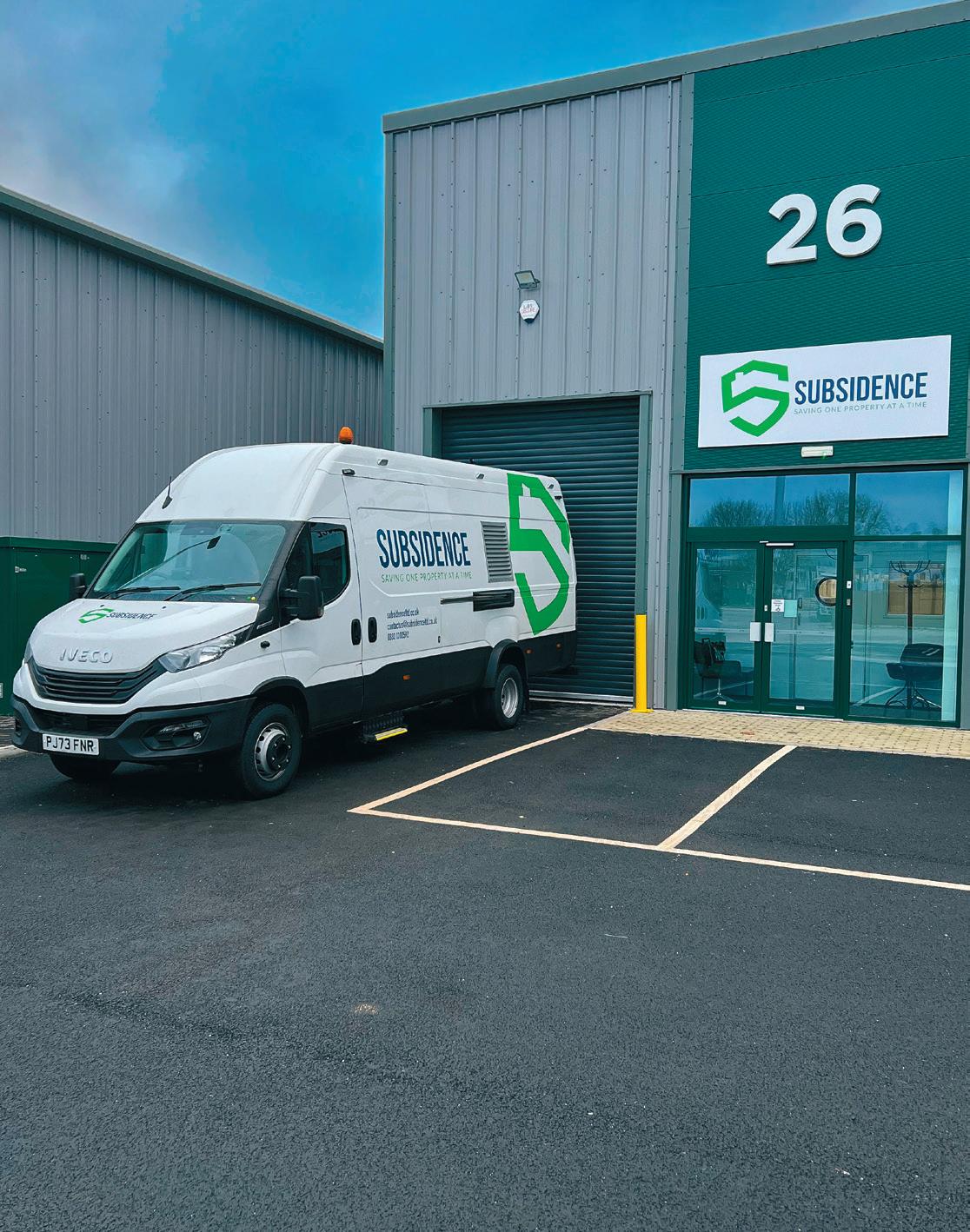















So, you’ve had your site survey, and identified subsidence –what can you do about it without major disruption?

Subsidence is a problem caused by ground sinking under your property, due to ground conditions such as clay shrinkage, damage from tree roots or problems with foundations. As the walls and floors of the property move from their original groundwork, cracks open up in walls and ceilings, often around doors and windows. At worst, this can make a property uninhabitable, and at least, subsidence can affect the value of your property.
Some areas are particularly prone to subsidence as there is a lot of clay in the ground. If your doors and windows are loose or sticking, use a postcode checker to find out if you are I a subsidence area.
In general, narrow cracks, while still important to monitor, are little to worry
about, but if you observe several cracks clustered in the same area or along the same wall, or the cracks are wider than 3mm, this is a strong indicator that these could be subsidence cracks and should be a concern.
If you are concerned about subsidence, you should call in a specialist company. Initially, monitoring any cracks should show whether the problem is increasing, or whether it is historical and may be addressed by simply filling the cracks. If it proves to be a worsening problem, it may be necessary to address the root of the problem.
Neglecting subsidence-related signs can jeopardise the structural integrity
of your home and potentially lead to costly repairs.
So what do you do if subsidence is confirmed in your property and the situation is likely to get worse? The problem is that repairs to the underpinnings of a building involving excavating beneath the foundation and installing new support structures like concrete piles are highly effective, but an expensive and disruptive undertaking. The modern solution is a resin injection system which stabilises foundations so that repairs to cracks can be made without worries about any further subsidence.
The resin injection process is usually complete in one day, makes little or no mess, and comes with a warranty for a number of years. It begins by drilling
small holes in the affected area. The resin compound is injected directly into the affected areas through the holes, and hardens quickly, providing a firm and reliable support similar to concrete. As well as stabilising foundations immediately, the resin injection method can even lift the property. By bonding with existing concrete, the resin reestablishes the integrity of the foundations, makes it easier to make cosmetic repairs to cracks, and helps to realign doors, windows and sinking floors.
Laser levelling equipment can be used to monitor progress as the work is carried out, and drains can be checked both to make sure that they are not the cause of subsidence, and that they are not affected by the injection of resin.
A clean, simple and mess-free solution, the resin system can often be applied from outside the property, without excavation work needed for traditional solutions. Sometimes flagstones may have to be lifted to expose service pipes for checking.
It’s important to note that a qualified surveyor or structural engineer should assess the situation and recommend the most suitable repair method, considering the cause and extent of damage, and your property’s specific needs. It’s worth checking whether your house insurance policy covers subsidence - many do, and may even go as far as covering alternative accommodation while remedial work is being carried out – but there is often an excess to pay, and sometimes insurers are wary about covering properties where subsidence may return – so check for a guarantee on remedial work. ■


Subsidence can be a real problem because you don’t know until you get a structural survey how much it might cost to remediate.
I can’t tell you the number of times I have looked at promising-looking properties with suspiciously low prices, and found signs of subsidence!
A few years ago on Homes Under the Hammer I looked at a former registry office in Ilkeston, Derbyshire. With the property up for auction with a fairly low guide price of £70,000 to £85,000, alarm bells were already ringing!
It didn’t take long to find the problems, including a massive crack in the ceiling on the stairway – you could get your fingers into it! Worst case I thought it’s subsidence, best case it’s historical - the building’s been moving in the past but has now settled. The only way to really know that would be to do some tests.
A good structural survey would definitely be required before you go too far on this - that maybe explained the low guide price. The property was snapped up by first-time property developers, but they agreed they were going to get a structural survey. They talked to the neighbours and were told that all the houses in the street had historic issues - apparently, the whole street was slowly moving downhill. The good news is that they were at the top of the hill!







ASometimes you need a quick solution to raising finance for a property purchase – could a bridging loan be the solution?



bridging loan is one which tides you over for a short period, as opposed to a long-term loan like a mortgage. The common circumstance in which a bridging loan is needed is when you are buying a property, but haven’t yet sold another property or asset on which you are relying for funds. So the bridging loan may be for a large amount, but for a short term. Once you have realised the value of your other assets, you repay the bridging loan.
A bridging loan should be capable of being put in place much faster than a mortgage, and so can o en remove problems caused by property ‘chains’.
The bridging loan specialists at Roma Finance say “We absolutely love to lend… but we are more than just a lender. We are dedicated to providing the ‘borrower first’




experience, we build long term relationships with property investors, developers in order to help them create wealth through property. If you want to work with a lender focused on your property goals, contact us on 0161 817 7480 or email rm@romafinance.co.uk.
There are two main types of bridging loans, regulated and unregulated. The regulated type is monitored by the FCA (Financial Conduct Authority) and is usually extended to homeowners. The unregulated type is normally used by intermediaries, property investors and property developers to secure an investment or buy-to-let property or commercial real estate, and as such is not covered by the FCA, so you will need to consult an experienced specialist to find a suitable lender for this sort of bridging loan.




A specialist bridging lender will be used to the idea of having to work quickly, and will normally be able to complete an arrangement within a few days. As well as speed, cost is of course also a factor: make sure that the lender is transparent about repayment structure, costs and the time involved.

Bridging loans are normally priced monthly rather than annually, and of course are relatively expensive, typically from around 0.5 percent to 2 percent per month, or 5 to 24 percent APR, much more than a conventional mortgage. There will also be a setup fee to consider, usually around two percent of the loan, and possibly an exit fee if you repay early, so it’s essential that you know before you go into a bridging loan arrangement, when and how you will be able to pay it o . ■



























The steps we take after making an insurance claim for property damage can be tricky. Why not have an expert do the job for you?

After suffering property damage, making an insurance claim is definitely the first step in the right direction. These claims are simple enough to make, and depending on your insurer, possible for a broad variety of cases, from damages caused by fire, flooding and storms to vandalism, impact and theft.
But it’s the steps that follow this that will often leave a claimant uncertain, questioning their own capability of seeing their claim through to its end. Experienced loss assessors and claims negotiators exist to fill this role, all on your behalf.
A claims negotiator will work to ensure the best possible outcome for you as their client. Once given the permission to represent your case, they will first ascertain the validity of your insurance claim, determining its extent and the
exact reparations that can be made, in accordance with their expertise. They will then liaise with your insurer, do the additional chasing, and come to an agreed settlement that is made with the benefit of their client in the foreground.
In the UK, insurance claims negotiators are required to be authorised and regulated by the Financial Conduct Authority (FCA). This ensures that the standards and ethical practices of the FCA are upheld, and their work is to a satisfactory and worthwhile calibre. When set against an insurance company, with experts and strict standards of their own, having an experienced claims negotiator and their level of expertise is a simple enough means to level the playing field. Their
experience can be determined with a look through their client reviews, as well as their transparency about said past client satisfaction. A good claims negotiator will be honest with you, first and foremost, striving to prioritise their client and a high satisfactory end result.
An added benefit of some claims negotiators is their protocol to see clients through to the completion of a claim and the necessary property repairs. This will often minimise, or avoid overall, the long-windedness of insurance company repair works many are familiar with. In some cases, claims negotiators may take up a certain extent of the reparations themselves. To that end, they are nothing if not proactive, and their specialised skill sets will prove most beneficial to clients through to the timely conclusion of a claim. ■

Our whole of market mortgage brokers can advise you on bridging finance, limited company buy to let and residential mortgages.
How can our one-stop shop help you?
A successful title split relies on the co-ordination of your mortgage application, your tax strategy and the creation of your leases. Without this integration, there will be an imbalance between these essential components causing costly delays and mistakes.
Are you interested in splitting the legal title of a property but do not know where to start? Are you put off by upfront costs or concerned about legal requirements or finance options? We can help! Call 020 8037 4027 for a free consultation






We have a successful track record in helping freeholders split their titles. Working under the same roof as Starck Uberoi Solicitors allows us to provide a streamlined and regulated ‘One Stop Shop’ service.
We offer:
✔ No upfront fees
✔ No training Course Jargon
✔ SRA Qualified & Regulated Solicitors
✔ FCA Regulated Mortgage Advisors
✔ Property Tax Advice























Title splitting is the process of dividing the deeds of one building into two or more. It can be a smart investment strategy - so how does it work?
The most common scenario in enhancing the value of your property portfolio by title splitting is to buy a large property, o en one in need of refurbishment, and to split it into several properties. The most suitable subjects for this strategy are usually tenements, or former nursing homes, hostels or guest houses.
Of course, in this sort of project, the cost of the refurbishment work has to be added onto the purchase price in order to work out whether you can make a profit. Perhaps the easiest option is to purchase a property which has already been split, such as an HMO (House in Multiple Occupation). Here some of the renovation work would have been done for you, and you might be able to continue
renting the property out partially while you get on with redevelopment work. But title splitting need not necessarily be done with an existing building - you can also do it by purchasing a plot of land and building not just one, but more houses on it. Each house is then recorded separately with the Land Registry.
Another potential scenario is that you could buy a house with a large gardeno en a corner house - and split it to build a second house on the garden.
Of course, there are complications to property splitting, whichever route you take. For instance, if you sell individual flats as leasehold, you may still want to hold on to the freehold for the property.
Other considerations when title splitting
are that you will have to get an extensive survey done, as well as obtaining planning permission, which can be time-consuming.
A successful title split relies on the co-ordination of your finance, your tax strategy and the creation of your leases, which is why a specialist advisor o ering collaboration with wealth and tax experts as a ‘one-stop’ title split solution is worth seeking out.
Raminder Singh Uberoi of solicitors Starck Uberoi (www.starckuberoi.co.uk), says; “Our experienced solicitors and financial advisors work collaboratively to provide comprehensive legal, financial, and tax solutions. By combining expertise under one roof, we ensure that every aspect of your title split is approached with precision, e iciency, and a focus on delivering meaningful financial outcomes.” ■
The allure of buying property in France is offset by the prospect of confusing bureaucracy. We take a taste of la vie en rose
For many in the UK, buying property in France is an appealing prospect, either as a holiday or retirement option or as a business investment such as managing a gîte or small family hotel. But there are pros and cons involved in buying French property.
Property prices in many parts of France are still comparatively lower than in the UK, especially in rural and smaller cities. Areas
like Normandy, Brittany, and even parts of the south offer substantial properties for a fraction of the cost of homes in the UK. This affordability is a significant factor for those looking for a holiday home or a retirement retreat.
Many UK residents are drawn to France’s lifestyle, which emphasizes work-life balance, leisurely meals, and a slower pace. With a reputation for excellent
healthcare, well-developed infrastructure, and a focus on fresh local produce, France offers an attractive setting for those looking to improve their quality of life.
France’s proximity to the UK means that it’s easy for families, retirees, and remote workers to stay connected. Budget airlines, ferry crossings, and high-speed trains like


the Eurostar allow for convenient travel back and forth, which is ideal for holiday homeowners or frequent travellers.
Close to the UK and featuring picturesque coastal areas, Normandy and Brittany are popular among those looking for a home within a short travel distance. The property market here is more a ordable than in other parts of France, and the local culture and cuisine make it a rich experience.
You’ll find a one-stop-shop for help and advice at the French Property Exhibition in January, the largest exhibition in the UK dedicated to French property, bringing together experts from the UK and France who can help you on your journey to buying a French property. Attendees can browse a wide range of properties, attend free seminars on essential topics, and receive a complimentary copy of French Property News. Find out more at www.frenchpropertyexhibition.com
Known for its Mediterranean climate and vibrant lifestyle, Provence is a favourite among those looking for a sunny escape. The south coast, while more expensive, o ers luxurious properties, stunning beaches, and proximity to the French Riviera.
Inland France has some of the most a ordable and idyllic countryside. The Dordogne, in particular, is renowned for its beautiful landscapes, charming villages, and historical sites, making it a favourite among retirees.
The French property market di ers from the UK’s in terms of pricing, process, and taxes. Buyers need to account for extra costs like notaire fees, which cover legal and registration services. These fees can be around 7–10% of the purchase price. Property taxes and maintenance costs should also be budgeted for.
With the UK’s exit from the EU, British citizens now have di erent rules around property ownership and residency. If staying for extended periods, UK residents may need a visa or long-stay permit. It’s essential to consult with an immigration
lawyer to understand the specific requirements for long-term residency or frequent stays.
UK residents can secure French mortgages, though lending criteria di er between the two countries. Generally, French banks o er mortgages of up to 70-80% of the property’s value, so buyers should be prepared for a substantial down payment. Mortgage brokers who specialize in overseas property purchases can provide valuable guidance through the financing process.
Currency fluctuations between the British Pound and the Euro can a ect the purchasing power and ongoing costs of owning a property in France. Many UK buyers open Euro accounts to help manage these fluctuations, especially for recurring payments like mortgage instalments or utility bills.
In practical terms, your first step would be to identify the type of property and region you are interested in - a city apartment, rural farmhouse, or coastal villa. Each type of property will come with di erent maintenance levels and seasonal benefits.
Engage a local notaire. Unlike in the UK, where solicitors act for either buyer or seller, in France, the notaire is a neutral party. They are essential for handling the legal aspects of the sale, from confirming ownership to completing the final registration.
Secure your finances early on, and don’t forget to budget for notaire fees, property taxes, and any necessary renovations. Working with both a French mortgage broker and currency exchange service can make this step easier.
A er finding the right property, you’ll need to make an o er and sign a preliminary contract known as the compromis de vente This contract binds both parties to the sale, though there is a ten-day cooling-o period for the buyer.
A er all conditions are met and final payments made, the sale is completed with the signing of the acte de vente (final sales agreement). At this stage, the property o icially transfers to the buyer, who can now enjoy their French home. ■
From decorative arts to heating and insulation to moving house, the latest products and style ideas for your home
London’s Decorative Fair has, over its 35 years, built a powerful reputation amongst the decorating trade and private buyers. Some 130 specialist dealers showcase every discipline of antiques, fine and decorative art and 20th century design, dating from the 1700s to the 1970s at a wide range of price points. Exhibitors are resourceful in finding unique and special items to create and finish an interior scheme or garden room. Many exhibitors present room-sets, providing further inspiration on how to imaginatively display items.
The Winter Fair is the perfect source for interior sparkle to brighten up your home, from modernist or period lighting and mirrors, to cheerful contemporary paintings and colourful works of art such as studio glass, crystal, and silverware. Winter is also when The London Antique Rug & Textile Art Fair (LARTA) takes place on the mezzanine, with 15 specialist dealers in rugs and carpets, tribal weavings, and a huge variety of antique textiles for decorating with, and collecting. If you are searching for a rug, or original
textiles for the wall such as embroidered panels or tapestries, you’ll find a great range to choose from.
Packing, delivery and export services are available on site. The restaurant on the Mezzanine provides allday refreshment, and there’s a courtesy coach service between Sloane Square and the Fair. The event is dog-friendly.
Venue
Evolution London Battersea Park London SW11 4NJ
Admission
Tuesday 21 January – £20 p/person
Wednesday 22 – Sunday 26 January – £10 p/person Free entry after 4pm
Find out more at www.decorativefair.com


The UK’s best-selling home batteries. A GivEnergy system puts you in control of your energy spend. Store cheap off-peak energy in the battery, then use that supply to power your home. No more peak charges, and ~85% cheaper energy bills. givenergy.co.uk

Forbo Flooring Systems’ Allura
Click Pro LVT collection features 20 beautiful tile and plank designs, from wood effect to concrete and stone. Featuring a click joint system, it can be quickly and easily installed adhesive free inside a home. www.forbo.com

My Home Move Conveyancing know moving home is stressful. They’ll guide you through your home-moving journey, from a personalised conveyancing quote, to placing you with a dedicated conveyancer, and help with surveys, insurance, even removal van hire and moving services. myhomemoveconveyancing.co.uk

Used Kitchen Hub is the UK’s leading luxury kitchen re-seller. Since 2015, the team has specialised in the buying and selling of ex-display and privately owned used kitchens at discounted rates, whilst providing a friendly, hand-held service.
usedkitchenhub.com

GreenFox offers a unique Vixen Care Plan, designed to keep your solar power system in tip-top shape. The 5-star Vixen Care Plan for solar panel owners keeps your solar panels clean and your inverter and battery running smoothly and efficiently, to maximise the power of the sun. www.greenfoxenergy.co.uk


Meet the ZEB – a new breed of boiler that’s redefining home heating, powered by electricity without the cost. It’s easy to install, use, and maintain, reducing both emissions and energy costs so you can heat your home and not the planet.
www.tepeo.com

The Guardian Warm Roof by NECS Group offers superior insulation and energy efficiency, transforming conservatories into comfortable, yearround living spaces. Its lightweight, tiled design ensures a seamless fit, enhancing both the aesthetic and functionality of your home.
www.necsgroup.co.uk
Switch to solar with the UK’s first solar subscription, Sunsave Plus. There’s no upfront cost – instead, you’ll pay a fixed monthly fee. Your solar and battery system will instantly cut your energy bills and let you sell your excess electricity. www.sunsave.energy
Pro Breeze are experts in creating clean, comfortable homes. Their OmniDry dehumidifier tackles damp and prevents mould, keeping your property fresh. With low-cost efficiency, ultra-quiet operation, and a laundry mode for faster drying, OmniDry makes home maintenance effortless. probreeze.com


From practical tips to inspiring advice and the latest products, it’s all under one roof at the Homebuilding & Renovating Show, the go-to exhibition for you as a self builder or renovator.
No matter what stage your project is at, the Homebuilding and Renovating Show can help you to bring it to life! Come along for tailored, one-toone advice; browse 1000s of new and innovative products to improve your home; and discover the ins and outs of everything from planning regulations for extensions and managing renovation budgets, to stylish kitchen design and integrating underfloor heating.
The Home Energy Academy helps you to understand how to make the most of the energy in your home, save money on your bills and reduce your carbon footprint.
Step into outstanding seminars and learn from the professionals. Learn how to extend your home on a budget, find your way through the planning maze or even build an energy e cient home from scratch.
The event is on 18th-19th January 2025 at Farnborough International Exhibition & Conference Centre. See farnborough.homebuildingshow.co.uk

Family-run wallpaper retailer Beautiful Walls is honouring symbolist painter Gustav Klimt in a new collection inspired by his work.
Named Academy, the eight-strong range is based on Klimt’s research during the ‘Golden Period’, when the Austrian artist discovered Byzantine mosaics.
Packed with texture and character, it features elegant lines, free brushstrokes and plenty of pattern. The centrepiece is the striking Adele Mural. Available in four colourways, it is bursting with graphics and touches which are synonymous with Klimt’s iconic work.
Tim Dixon, who is the fifth generation of his family to run Beautiful Walls, said: “We’re thrilled to unveil Academy, a new collection paying homage to the visionary Gustav Klimt. Klimt’s art was a whirlwind of colour, texture, and emotion, and this collection captures that essence perfectly. These stunning wallcoverings aren’t just decorations, they’re immersive experiences.
The Academy Collection is available now from beautifulwalls.co.uk, with prices starting at £160 per roll.

Garolla electric roller garage doors have transformed the look, feel and function of more than 100,000 homes across the UK. Revitalise the look of your home and unlock 25% more space with our modern roller garage doors, engineered to withstand everyday challenges, opportunist criminals and tough weather. We’re the UK’s number one. All doors are fitted by expert local engineers and come with a free 5-year warranty. www.garolla.co.uk

Sunsynk’s revolutionary W-series batteries are an industry game changer, designed to withstand extreme winter temperatures. Key to any solar installation, batteries allow homeowners to charge during the day via solar panels, and at night at an o -peak rate tari . www.sunsynk.com










Ensure your door is locked with the autoLock AV4 multi-point locking solutions from Winkhaus UK. It locks automatically when you pull the door closed, without the need to lift a handle or use a key, meets the requirements of the PAS24 standard and is approved by the Police ‘Secured by Design’ security initiative. www.winkhaus.co.uk

Foco canned beverages are made with premium quality Asian fruits, herbs and nutritious vegetables. Exotic and refreshing, this range of Thai soft drinks are exported around the world and are rapidly gaining popularity in the UK. chadhaorientalfoods.co.uk/ brands/foco

Domna is the “one-stop-shop” to upgrade EPC ratings and meet MEES standards — adding to property value and slashing energy bills. Domna o er straightforward home energy advice, seamless project management, and support on eligible grants. Get cozy this winter — get in touch. www.warmfrontteam.co.uk
The Rointe Belize Electric Radiator o ers significant cost reduction through its Fuzzy Logic Energy Control, delivering up to 62% energy savings by optimizing power usage. Its real-time consumption tracking and smart heating schedules further lower energy costs, maximizing e ciency and comfort. rointe.com

Did you know that you can sell your kitchen? Make money and help the environment at the same time – what’s not to love? Please contact Love My Kitchen today, they will take care of the rest for you. lovemykitchen.uk

Design your own Hallmark front door, the UK’s No.1 composite door, superimpose it on your house, and receive a quote from a trusted local installer. Transform your home with toprated quality and style. qrco.de/bfUbyz

Say goodbye to mould and mildew, and hello to fresher air and lasting protection for your home and contents. Also an e cient method to dry clothes year-round, with Smart control to monitor from a distance when needed. www.princesshome.eu


















Intelligent, beautiful, efficient. The Aira Heat Pump is everything your boiler isn’t.
And, because it runs on free, fresh air, not filthy fossil fuels, it has the power to slash your heating CO₂ emissions to zero and your annual heating bills by up to £560*.
No more gas guilt. No more bill fear. It’s how heating should be.


Call 0330 822 6144 for a free, no-strings home energy assessment.
*When your switch from a gas boiler to an Aira Heat Pump and sign up for the Aira Zero tariff.

As gas heating is phased out, we will all have to look at more modern heating technologies, such as the heat pump
The news recently has been dominated by the price of energy, particularly gas, and with the climate crisis dictating a move away from fossil fuels, it seems that the days of gas as a domestic energy source are numbered. The previous government planned to phase out the installation of gas boilers in new builds by 2025 and in existing properties by 2035. We don’t know how this may change under the new government.
One thing certain is that gas heating technology is on its way out, and the heat pump is a likely option to replace it.
In order to achieve Carbon Net Zero by 2050, the UK government aims to install 19 million heat pumps in new-build properties. By using support grants, the aim is to make heat pumps the preferred domestic energy source, and at some stage, gas boilers will be phased out. No new gas boilers should be sold after 2025.
One incentive to install a heat pump is that there is currently a £7,500 grant available to install one. Together with the likely savings on energy bills – estimated at around £500 a year for the average home previously heated by gas – there are good reasons to look at heat pump
technology. But how does it work and how is it fitted?
There are two main forms of heat pump, Air Source (ASHP) and Ground Source (GSHP).
Heat pumps work similarly to a refrigerator, using a refrigerant liquid to absorb heat then transferring it to another medium. The ASHP works by transferring heat absorbed from the outside air to an indoor space. An ASHP can transfer heat directly into rooms through fans, or can be connected to a ‘wet’ (ie water-filled) central heating system to heat radiators
and underfloor heating, and to provide domestic hot water.
Most heat pumps are placed outside the home - they look like air conditioning units - so they need some clearance from surrounding buildings. Some air source heat pumps can also work as a cooling system in the summer months.
Although heat pumps use electricity to enable energy conversion, they are much cheaper to run than gas, electricity or coal. Though the initial installation costs could be high, you may receive a grant through the Boiler Upgrade Scheme. This £3.9 billion initiative was launched by the government in April 2022, as part of the Heat and Buildings Strategy, and will run until April 2025.
But what about e iciency in the winter? Air source heat pumps designed for use in the UK can work at temperatures as low as -25 degrees. They can usually be used with any type of heating system, such as underfloor heating and traditional radiators.
For every one kilowatt of energy it uses, an air source heat pump can create 3 kilowatts of heat energy, making it 300 percent e icient - in comparison, oil and gas are only 90 percent e icient.
The main advantage of any kind of heat pump is that it is a low-carbon energy source which would free us from reliance on gas, so there’s no cost for delivering fuel, no storage requirement, and no danger from explosion. You may have to change the way

you use your heating timer settings, as heat pumps deliver heating more slowly than gas – the idea is known as ‘pre-heating’.
Small-scale trial installations of heat pumps suggest that it was possible to improve economy by moving electricity consumption to di erent points in the day in a way that participants found acceptable, and that using ‘pre-heating’ the majority of temperatures reported at the end of the pre-heating window were greater than normal thermostat setpoints, suggesting that pre-heating worked.
Up until now, switching to clean energy has been anything but easy. Aira changes that with an all-inclusive plan that makes switching from a boiler to a heat pump completely hassle-free. From a free home energy assessment and installation to flexible payment options and a 15-year guarantee.
It’s simple. A ordable. And all under one roof.
At the heart of Aira’s mission to get Europe o gas is the Aira Heat Pump. Intelligent, a ordable and sustainable. It’s everything a gas boiler isn’t. And it’s 4x more e icient, delivering up to 25% savings on heating bills and a 75% reduction in home heating CO2 emissions.
See more at www.airahome.com ■
The Boiler Upgrade Scheme (or ‘BUS’ for short) gives eligible homes a £7,500 grant to help replace their old gas or oil boiler with a clean energy heat pump, because heat pumps are four times more energy e cient than boilers and emit 75% less carbon dioxide.
The Boiler Upgrade Scheme is available in England and Wales, and is an installer-led scheme, which means that your installer applies for the grant on your behalf. If you live in Scotland, you may be eligible for the Home Energy Scotland Grant and Loan.






As the use of gas boilers in homes is phased out due to their unacceptable levels of carbon emission, we’re all looking for alternatives such as solar power or heat pumps. But there is a relatively new technology presenting a third heating option – the ZEB, or Zero Emission Boiler.
ZEBs use electricity, so they can be integrated with renewable energy sources like solar power or wind power, and don’t need access to the outdoors as do heat pumps. So a ZEB is suitable for use in a flat, though not normally for installation in a loft, as they are too heavy.
A ZEB works similarly to an electric storage heater, drawing electricity from the grid and converting it into heat for your home. ZEBs charge up on electricity off-peak, like a battery, and use a mixture of specially designed high-density, inert, non-toxic, low-impact materials to act as
a thermal (heat) battery. The key element is magnetite, a common iron ore that degrades slowly and is easily recyclable.
When heating or hot water is needed, air flows over the ZEB’s core and transfers heat to the heat exchanger. Water then flows through the heat exchanger and once heated then travels to the radiators or hot water taps.
A typical ZEB can store around 40 kilowatt-hours (kWh) of usable heat energy per charge – the average UK home uses around 1,000 kWh of energy per month.
One of the advantages of fitting a ZEB is that it will usually not require you to change your plumbing, radiators or to add underfloor heating to work well. To provide hot water, though, a ZEB will need to be connected to a separate hot water cylinder. Alternatively you could use a standalone
electrical hot water cylinder so the ZEB can concentrate on space heating only.
Many ZEBs are designed to fit in the same space as an existing gas or oil boiler, so fitting is normally straightforward. They are often ‘smart’ devices which can be controlled by a smartphone app, and can be programmed to use the cheapest electricity tariffs, normally taking four or five hours to charge fully.
While ZEBs can save money and emissions, they are not appropriate for every home; they are best suited for properties (no matter the size) that use between 3,000 and 12,000 kWh, and using a ‘wet’ central heating system. While they are claimed to reduce heating costs by 20-340 percent, units cost around £6,000, and there may be additional installation expenses, so calculate carefully whether a ZEB represents an economical way to heat your home. ■



Greener than gas or oil
Kinder to our planet by cutting 100% of direct home heating carbon emissions.
Cheaper than electric boilers
The ZEB is half the running cost, saving you up to £1.5k a year.
Easy to install, use & maintain
Installed in 1-2 days with the same experience as your current boiler.

















Heating your home comfortably isn’t just about whacking the thermostat up to maximum. Find out how the idea of ‘thermal comfort’ works


When designing a heating system, it’s one thing to give attention to the heat output of your system; but this is just part of the concept of ‘thermal comfort’, which takes into account elements such as air temperature, movement and humidity. While measurement of heat output can be objective, thermal comfort is partly a subjective judgement.
Elements to take into account when aiming for thermal comfort include the use the room is being put to, and the overall temperature, humidity, air movement, and radiant temperature of the room. Even the clothing worn by the user can be taken into account.
In the 1950s, two German researchers, Leusden and Freymark, developed a standard for comfortable warmth, suggesting 18-22º C for normal, healthy
adults who are appropriately dressed. Those with respiratory problems or allergies are recommended no less than 16 ºC, and for the sick, disabled, very old or very young, a minimum of 20º C. With a temperature set around 21ºC in winter, you can maintain the optimum level of thermal comfort, without increasing your energy expenditure.
Decreasing the temperature in your home by just 1º C can reduce your heating bill by up to £85 per year - most of us won’t even notice such a small di erence, so you should give it a try to ease the financial worry of heating your home. You should also keep the airspeed of your heating system below 0.1 m/s and the relative humidity of the space between 40-70%.
Falling outside of these parameters can have a negative impact on productivity and health, such as sleep quality. Studies
have shown that bedrooms with high temperatures lower your quality of sleep.
Electric radiators are sometimes said to o er the best cost/conductivity ratio on the market, with the combination of materials and design allowing the steady increase of air temperature when circulating through the radiator’s internal fins. The thermal fluid inside the radiator ensures that the temperature remains stable, while thermal resistance located at the bottom of the radiator o ers e icient and uniform heating.
Natural humidity and temperature stability are provided by the gentle rise of the air as it passes through an electric radiator, creating a gentle natural convection cycle, while energysaving functions can maintain a stable temperature with the use of nominal power once a steady working rate has been achieved. ■
Boost property value and stay compliant with EPC Upgrades.

GET STARTED WITH DOMNA’S ENERGY EFFICIENCY “ONE STOP SHOP” TODAY
Navigating new energy regulations doesn’t have to be daunting. Domna’s energy efficiency experts simplify compliance through our “one stop shop” service. Contact us today to start your journey toward a more valuable, efficient and compliant property.








1 2 3
AVOID FINES AND STAY COMPLIANT
Minimum Energy Efficiency Standards (MEES) regulations require rental properties to be at least EPC E, targeting EPC C by 2030. Fines start at £5,000, doubling to £10,000 after three months. Domna ensures compliance with current and future standards, helping you avoid penalties.
MAXIMISE YOUR GRANT FUNDING
Domna connects you to government grants for energy upgrades, including the Energy Company Obligation and Great British Insulation Scheme, which offer over £1 billion annually. We handle the funding process, reducing costs and maximising your returns.
Scan the QR code opposite and begin your “One Stop Shop” with Domna today
Energy-efficient properties not only comply with regulations but also deliver substantial financial benefits:
ENERGY EFFICIENCY
• Up to £29,000-64,000 increase in property values Properties moving from EPC E-G to EPC C see higher resale value (Knight Frank).
• Up to £500+ annual fuel bill savings EPC upgrades slash fuel bills, meaning happier tenants and higher lease renewals (Leeds Beckett University, ECD Architects).
• Up to 10% rental income boosts for properties at EPC B/C compared to those below EPC D (Cambridge University, Department for Business, Energy & Industrial Strategy). Energyefficient homes attract high-quality tenants, lowering turnover rates.
• Happier, healthier tenants65% of Britons report discomfort from cold drafts and poor insulation Domna’s services enhance energy efficiency and comfort, creating healthier living spaces – with less risk of damp and mould.
Navigating the path to energy efficiency doesn’t have to be complex. Domna provides end-to-end support for a seamless retrofit experience:
• HOME ENERGY ‘HEALTH CHECK’: Accurate estimates using billions of data points to offer 95%+ accurate estimates of potential EPC improvements, identifying impactful upgrades with minimal upfront commitment.
• ON-SITE SURVEYS & GRANTS ASSISTANCE Comprehensive assessments tailored to your property, with grant identification and support.
• PROJECT MANAGEMENT: Domna manages every stage of the retrofit, ensuring quality work, minimal tenant disruption, and cost control.
IT CAN COST LESS THAN YOU THINK WITH QUICK WINS AND PHASED UPGRADES
Begin with simple upgrades like insulation, LED lighting, and heating controls. These “quick wins” boost your EPC with minimal tenant disruption and quick returns. Our team tailors a phased plan to fit your property and budget.
There are many advantages to solar energy systems, but all come with an initial installation cost. Is there a good way to spread the expense?
Solar energy has a great number of advantages, not the least of which is that once you have installed solar panels and a storage system, you can sit back and enjoy a massive drop in your energy bills – with some setups you can even earn money by selling energy back to the grid.
But of course, solar energy systems rely on hardware which requires a considerable initial investment. Depending on the number and type of panels you have and the ancillary system such as storage batteries and invertors, you can pay anything from £4,000 to £10,000 for a starter system.
As the cost of solar power drops compared to electricity and gas, it becomes more economical to install a solar power system – it’s often said that it will pay for itself in around 10 years, and of
course another appeal is that solar power is a clean source of energy.
But what if the initial cost of a solar power system still puts you off? One new idea is the ‘solar subscription’, by which you pay for the cost of your solar energy hardware on a month-by-month basis. With no upfront costs or deposit, and a fixed monthly repayment rate, you can own your solar power system from the start, have a guarantee on the work, and in some cases even continue to sell energy back to the grid, offsetting the cost of your monthly payments.
For a typical system costing around £10,000, you might make 240 monthly payments of around £70, resulting on a cost of around £17,000; but included in this cost apart from the loan
interest would be remote performance monitoring, maintenance cover and insurance, for the typical 20 years life of the system.
Remember that solar panels work all through the year, though obviously they generate the most energy in summer. This is when you can sell the most excess electricity to the grid. In winter, your solar energy output will drop, but won’t stop completely, though you’ll probably need to top up with electricity from the grid.
It’s estimated that with a subscription model like this, a typical four-bedroom family home could save £444 every year, reducing its carbon footprint at the same time. Depending on your roof suitability and where your home is, your energy bills savings could even exceed your monthly repayments, so you’ll be saving money and saving the planet at the same time. ■







































There are many styles of kitchens to choose from, reflecting your personal taste and way of living. We look at some of the most popular
The kitchen is often the heart of the home, so it’s important to design a space that feels comfortable, functional, and reflective of your personal style. You can go for a brand-new fitting, or it’s increasingly attractive to save money by going for a quality used kitchen. In any case your first job is to choose a style. Let’s run though some of the most popular.
The farmhouse kitchen combines rustic charm with functionality, featuring natural materials, warm colours, and an open, inviting layout. Signature elements include large farmhouse sinks, wood beams, shaker cabinets, and open shelving.
Vintage touches, like wrought-iron fixtures and distressed wood finishes, give this style its authentic feel, while practical details—such as butcher-block countertops and a spacious islandmake it ideal for those who love cooking and entertaining.
Key Features:
h Butcher block or natural stone countertops
h Apron-front sinks
h Open shelving and rustic accents
h Neutral, earthy tones
Modern kitchens emphasize simplicity and functionality, often featuring
clean lines, minimalistic cabinets, and a monochromatic colour scheme. Cabinets are often handle-less or feature sleek hardware, while countertops and backsplashes tend to be made of durable, easy-to-clean materials like quartz or stainless steel. Integrated appliances, built-in storage solutions, and minimal decorative elements contribute to the streamlined look.
Key Features:
h Sleek, handle-less cabinets
h Neutral colours with black, white, or grey accents
h High-tech appliances
h Minimal decor and clutter-free surfaces »

Often mistaken for modern style, contemporary kitchens offer a more flexible, evolving aesthetic. Unlike the structured simplicity of modern design, contemporary kitchens mix current trends with elements from various styles. They may incorporate natural materials, bold accent colours, and experimental lighting. These kitchens also adapt to the homeowner’s personal taste and lifestyle, giving them a unique, dynamic feel.
Key Features:
h Bold accents and unique lighting
h A mix of materials and textures
h Smooth lines with pops of colour
h An open layout with multifunctional spaces
Cottage kitchens have a charming, cozy feel that evokes a sense of nostalgia. Characterized by soft pastel colours, vintage appliances, and decorative details, these kitchens feel warm and inviting. Details like beadboard panelling, farmhouse sinks, and quaint cabinetry bring out the charm, while open
shelving is often used to display vintage dishes and decor, creating a lived-in, whimsical atmosphere.
Key Features:
h Pastel colours and vintage accents
h Beadboard and panelling details
h Farmhouse or ceramic sinks
h Open shelving to showcase decor
European kitchens are known for their sophistication and elegance. Often influenced by French, Italian, and Scandinavian designs, these kitchens balance form and function with highquality materials like marble, granite, and walnut. Soft neutral colours are popular, paired with natural textures and minimalist cabinetry. Open shelving is common, as are seamless, integrated appliances, creating a cohesive, luxurious look.
Key Features:
h High-quality natural materials
h Neutral colour palette
h Minimalistic, handle-less cabinets
h Integrated appliances for a seamless look
A coastal kitchen is inspired by the ocean and is designed to feel airy, light, and refreshing. Common colour schemes include shades of blue, white, and sandy neutrals, creating a beach-like atmosphere. Elements like driftwood, woven textures, and soft, ocean-inspired accents are essential. Open layouts, large windows, and light, reflective surfaces are also common to capture natural light and enhance the breezy ambiance.
Key Features:
h Light colours like white, blue, and beige
h Woven textures and coastal accents
h Open shelving and large windows
h Reflective surfaces for a bright feel
Island kitchens are all about maximizing space and functionality, centred around a large, multipurpose island that acts as both a workspace and a social hub. This layout is highly versatile, as islands can be customized with built-in cooktops, sinks, or extra seating, making them ideal for multitasking. Island kitchens are suitable for large spaces and open layouts,

especially in homes where entertaining is a priority.
Key Features:
h Large island with storage, seating, and workspaces
h Open layout connecting to other living spaces
h Integrated appliances in the island
h Ideal for entertaining and family gatherings
A rustic kitchen embodies warmth and natural charm, inspired by countryside and farmhouse aesthetics. This style emphasizes rugged, organic materials and earthy tones to create a cozy, welcoming atmosphere.
Key Features:
h Natural materials such as reclaimed wood, stone, and metals for a lived-in feel
h Earthy tones, warm browns, greens, and neutrals dominate the colour palette.
h Often features wooden ceiling beams for added character.
h Open shelving showcases dishes and cookware, adding to the rustic charm
h Vintage-style fixtures, hammered metal accents, and artisanal touches enhance the authentic, rustic look.
A transitional kitchen blends traditional and contemporary design elements, creating a balanced, timeless look. This style offers flexibility in materials, colours, and textures, making it ideal for homeowners seeking elegance with modern functionality.
Key Features:
h Mix of materials combining natural wood, stone, and sleek finishes.
h Neutral palette of whites, greys, and soft earth tones for a cohesive feel
h Simple cabinetry of Shaker-style or panelled cabinets with modern hardware
h Statement pendant lights or chandeliers add warmth and interest
h Minimalist yet classic décor such as crown moulding with clean lines

An industrial kitchen style is inspired by factories and urban lofts, blending raw materials with a modern edge. It’s known for its rugged aesthetics, practical design, and open layout, making it both stylish and functional.
Key Features:
h Visible pipes, ducts, and brick walls add an unfinished yet sophisticated feel.
h Stainless steel appliances, metal shelving, and hardware are prominent
h Concrete floors or countertops paired with reclaimed wood for warmth
h Open shelving enhances functionality and maintains an airy, spacious look
h Minimalist pendant lights and Edison bulbs give a utilitarian yet chic vibe
A galley kitchen is a narrow, efficient layout ideal for small spaces, characterised by two parallel countertops with a walkway in between. Its design maximizes functionality in compact areas, often favoured in apartments and smaller homes.
Key Features:
h Parallel counters maximise workspace
within a small footprint.
h Allows easy access to cooking, cleaning, and storage areas for efficient workflow
h Compact design is ideal for narrow spaces, creating a streamlined look
h Optimized storage cabinets and shelves run to the ceiling for additional storage
h Appliances along one wall maintain clear movement within the kitchen
With so many styles to choose from, the right kitchen design ultimately depends on personal preferences, lifestyle needs, and the home’s architectural character.
Farmhouse and rustic kitchens, for instance, are ideal for those who prefer warmth and charm, while modern and curved kitchens appeal to fans of sleek minimalism. Cottage and coastal styles bring a light, airy feel, and island kitchens offer social interaction and practicality. When selecting a style, consider both form and function. Think about how you use your kitchen - whether it’s a cooking workspace, an entertaining area, or a cozy family space. From the warm tones of farmhouse kitchens to the clean lines of modern designs, each style offers its own unique blend of comfort, practicality, and aesthetic appeal, providing options to suit every taste and lifestyle. ■













We’ve been told for years that ‘smart’ technology will bring about a revolution in home control systems, with everything from lighting, heating and security to kitchen appliances, air conditioning, blinds and curtains put under the control of customisable handsets. But the actuality was very slow coming, experts say because there were so many di erent incompatible systems, that no-one could make any progress in the wider market. That pretty much came to an end with the dominance of the smartphone – now, every smart home system is made to integrate with the smartphones we already have in our homes, so smart systems can forge ahead without the customer having to make impossible compatibility decisions early on in the process.
Take, for instance, lighting control. All the lighting systems in your house can now be put under the control of a smartphone app, with the existing wiring system pressed into service to connect the entire system.




Because the smartphone can be used even when you are away from home, a smart lighting system has multiple uses.
You can control lights to switch on before you arrive home, or to switch on and o during the day to create an illusion of occupancy; you can set timers for di erent lighting zones, control overall ambience with programmable dimmer settings, and even set the range, speed and smoothness of dimming functions.
Preset scenes can be set up so you could have di erent lighting settings for reading,
relaxing, partying or watching movies, then you can have a single command to switch all lights o .
Even better, because smartphone apps can be voice controlled, all these clever lighting commands can be programmed to respond to your voice using a common virtual assistant such as Apple’s Siri.
If you aren’t keen to use voice commands, in many cases a ‘magic button’ can be added to your wall switches, so preset lighting scenes, global commands and emergency settings can be executed from anywhere convenient.
Lightwave provide smart lighting, power, and heating solutions with a completely retrofit solution that is easy to install and use. A range of smart switches, sockets, thermostats, and more, integrate seamlessly with your home, giving you full control of your home at the touch of a button, while the app allows you to easily customise your routines.
Find out more on the website at shop.lightwaverf.com ■
At My Home Move Conveyancing, we’re here to help reduce the stress that comes with moving home. And we do this by guiding you through the process, cutting the jargon to make it clearer and easier for you, and being here for you whenever you need us.
Whether you’re buying your first home, a dream holiday retreat, or a buy-to-let, or selling an investment property, we can help your transaction go as smoothly as possible. We’ll connect you with expert and dedicated conveyancers who will guide you through the entire process, making sure the legal side of things is taken care of smoothly and efficiently.
transparent
We’ll find out what’s important to you, so we can give you a tailored and personal service that works for you
Being experts means we don’t need to hide behind jargon - we make things straightforward and easy to understand

In fact, we’re better than local. Your case is available to you to see 24 hours a day, and you can get in touch with us via phone call, email and messaging services 24/7
We want you to feel confident with our service, and we know this comes from being open and transparent
We use the right combination of tech and people, at the right points in your moving journey to keep the process moving along, and keep you updated

We work with a range of conveyancing and law firms to cover most types of property transaction.
z Freehold sale and purchase
z Cash purchase
z Remortgage
z Leasehold
z Transfer of equity
z Equity release
z Lease extensions
z New build
z Buying via auction
z Building Safety Act transactions
z Buying via a company
We also offer a Home Document pack, a printed and tangible record of your move, with all your important documents collected in one indexed binder.
We work closely with a number of other home move experts, carefully vetted by us, to bring you the best possible service to help you through your moving journey.
z RICS home surveys
z Home insurance
z Removal van hire
z Home setup service
Thousands of movers have trusted us to help them move, and we’re very proud to be rated ‘Excellent’ on Trustpilot by them. We put transparency, care, and innovation at the heart of everything we do, to ensure that your home move journey starts with ease and ends with confidence.
To find out more about all the services we can offer, or to discuss a move you have in mind, get in touch with us today.
Mould, damp and other environmental problems can beset a landlord’s business. What are the risks and how can they be controlled?

It’s become obvious from recent headlines that more properties are becoming a health hazard, because inadequate protection from damp and leakage can lead to ingress of mould, which can have all sorts of health implications. The quality of social housing particularly has been in the spotlight since the tragic death of Awaab Ishak, a two-year-old who died in 2020 after exposure to mould in the rented flat where he lived in Rochdale.
Mould is a simple microscopic organism which can spread through airborne spores. Moulds need damp conditions to thrive but can find food sources practically anywhere, from wood and other organic materials to wallpaper, plasterboard, and carpets, so practically any part of a property where there is water can be affected.
Typically, of course, mould is found in kitchens and bathrooms, where the rich organic ‘biofilm’ of food waste and skin particles provides plenty of sustenance. Once it has gained a foothold, mould will spread rapidly by generating spores, so an empty property with no ventilation is particularly prone to mould infestation.
Inhaling mould, particularly some forms of black mould, can be a health hazard for anyone, but it is particularly dangerous for people with respiratory diseases or compromised immune systems.
With recent proposals to make landlords responsible for dealing with health threats to tenants such as mould, it’s particularly important that if you are renting out a property, you have a property ‘MOT’ done so that problems can be detected and eliminated.
Another significant problem in residential properties or social housing is flooding; furniture and fittings may be salvageable, or may not, but the first issue is to arrange safe accommodation while you assess the damage. Your insurer’s claims manager should be able to help with that, and will put in place a plan to make the property safe.
Advanced drying techniques such as bringing in air heaters will dry out the property and reduce the risk of secondary damage such as by mould, and in some cases, such as if a business is flooded, experts can advise on whether it is possible for the business to continue in one part of the property while drying work continues in another.
An increasingly popular way to monitor

the potential damage of mould, damp and other environmental hazards, particularly in multiple properties, is to us a sensor system such as the one designed by Switchee (https://switchee.com).
This British tech start-up aims to improve the quality of life for residents in social housing by ensuring everyone has safe, warm, healthy homes. Working with over 130 social housing providers, and installed in tens of thousands of homes, Switchee’s device is an innovative thermostat that uses smart solutions to tackle some of the most di icult in-home challenges including the cost-of-living crisis, fuel poverty, and mould and damp. Using this information can help lower heating bills and make resident properties more e icient.
Switchee uses multiple sensors to understand the property’s environment. This data is then used to produce a landlord dashboard that displays a range of maintenance and alerts about mould risk, poor insulation, fuel poverty risk, and heating system performance.
This information enables the landlord to be more proactive in the way properties
are managed, with early intervention to resolve issues such as mould or insulation deficiencies more quickly, and to save on fuel bills.




















Switchee quantitatively measures the number of households living in fuel poverty, defined by homes that haven’t reached a temperature of 18°C whilst occupied in any of the past 30 days. According to Public Health England, 18°C is the minimum indoor temperature required to prevent health risks. By providing this data, Switchee enables housing providers to measure the impact of retrofit works on fuel poverty e ectively. In cases where residents remain in fuel poverty despite retrofits,
Switchee can identify these households and o er direct-to-device energy vouchers to residents, providing immediate relief.
Switchee’s insights allow energy savings through optimised heating systems.
Receiving over 16 billion data points per year, it generates real-time insights to facilitate an e icient energy transition.
Switchee’s service allows housing providers to understand which social homes would benefit most from retrofit intervention ensuring the worst insulated homes become energy e icient.
Switchee provides two-way communication with tenants where secure messages, surveys and energy advice can be sent directly to residents via the inhome display.
With a typical response rate of 88% within 24 hours Switchee’s dashboard o ers a cost-e ective and secure platform, allowing tenants anonymity while communicating with housing providers. For example, Switchee received a survey response rate of 90% within the first 24 hours, which is significantly higher than the 11-15% experienced by providers using traditional communication methods. ■



Switchee is a smart thermostat created to support social housing providers across the UK to improve the quality of life for their residents. You might be one of the residents who has already benefited from having Switchee installed.
Switchee can help you easily control your heating, and save money on your heating bills.
How does it work?
Using remote property insights, Switchee’s efficient and unobtrusive in-home display identifies in-home hazards such as damp, mould and fuel poverty.
Switchee has a resident-first approach that uses a two-way communications platform, with an 88%* tenant response rate within 24 hours. This secure and cost-effective method of landlord-tenant engagement is why over 130 social housing providers partner with Switchee to help ensure safe, warm, and healthy homes.
Switchee improves the quality of life for people living in rented homes.
are the benefits for your home?
Switchee uses multiple sensors to understand your home environment. This data is then used to produce a landlord dashboard that displays a range of maintenance and alerts about mould risk, poor insulation, fuel poverty risk, heating system performance.
This information enables your landlord to be more proactive in the way they manage your home. This early intervention can resolve issues such as mould or insulation deficiencies more quickly, and improve living conditions.


Resident Feedback
“Switchee is very simple and easy to use. If we have any issues, we don't have to make phone calls and the response rates are just phenomenal.”
“With Switchee I am using my heating for two hours less each day and my home is one degree warmer.”


Proactive intervention can enable better targeting of resources, resolve issues such as mould or insulation deficiencies more quickly, saving landlords money and improving living conditions for residents.








































17% Switchee can help reduce heating bills for residents by up to 17%*
What are the benefits for you?
aHelping with your energy bills
aImproving your living conditions aPreventing health risks
Take positive action this winter with the Energy Voucher service
This winter Switchee has launched a free Energy Voucher service. The service uses real-time data to identify households living in fuel poverty, delivering energy voucher links directly to the resident.
Residents can link to a £49 energy voucher on their Switchee device within 48 hours of confirmation.



The tragic death of two-year-old Awaab Ishak in 2020 stunned the nation. As a direct result of prolonged mould exposure in his family’s rented social home, Awaab’s story made it clear that more needs to be done to avoid preventable death or injury from occurring again. Switchee recognises the ongoing battle against mould, and is working with landlords across social housing to ensure healthy homes for all.















































Fairhive Homes installed Switchee smart thermostats into their residents’ homes, utilising data to gain valuable insights on the performance of their housing stock. This enabled them to proactively identify and support residents at risk of damp, mould and fuel poverty.
a Proactively identified mould
a Quick resident communication and fast response times
a Driving business efficiency and lowering costs























Discover how Switchee could help improve your home this winter









In fact, vinyl was never out, if you’re talking about flooring. Impressive for its durability and style, it’s the go-to solution for all sorts of flooring challenges
Vinyl flooring has become one of the top choices for homeowners, praised for its durability, affordability, and stylish designs. Once considered mainly only for bathrooms and kitchens, vinyl has evolved into a versatile flooring option with potential for use in any part of the house.
With advances in design and technology, it is available in a variety of textures, colours, and patterns, including options
that convincingly mimic wood, tile, and stone. Though you might think of stone or concrete first when considering durability, vinyl flooring is remarkably durable and is designed to withstand heavy foot traffic, making it ideal for high-traffic areas like hallways, kitchens, and living rooms.
Vinyl is also resistant to scratches, dents, and stains, so it can handle daily wear and tear well, making it suitable for homes with pets and children.
Most vinyl flooring is water-resistant, and luxury vinyl options are often fully waterproof. This makes it a great choice for areas prone to moisture, such as kitchens, bathrooms, and basements.
Vinyl floors are softer than hardwood and stone, providing a more comfortable walking surface. Many vinyl options also have a foam or felt backing, which provides sound insulation, reducing noise in busy households. »
With basic care, vinyl flooring maintains its appearance for years. It’s resistant to spills and stains, making it a great choice for families looking for low-maintenance solutions.
Among the biggest appeals of vinyl flooring are its affordability and ease of installation.
Vinyl offers the look of premium materials at a fraction of the price, and is inexpensive to install too.
Vinyl flooring is available in sheets, tiles, or planks. Planks and tiles are often designed to lock together, making them suitable for DIY projects. Sheet vinyl may require professional installation for a seamless finish.
Vinyl flooring is famously easy to maintain. Follow these simple steps to keep it looking its best:
h Regular Sweeping or Vacuuming: Remove dirt, dust, and debris daily to prevent scratches. Use a soft-bristled broom or a vacuum cleaner with a hard-floor setting.
h Mopping with a Damp Mop: For a deeper clean, mop the floor with warm water and a mild, non-abrasive cleaner. Avoid soaking the floor, as standing water can damage the adhesive over time.
h Avoid Harsh Chemicals: Acidic or abrasive cleaners can damage vinyl
flooring. Stick to gentle, pH-neutral solutions specifically designed for vinyl or use a solution of water and mild dish soap.
h Protect Against Scratches: Place felt pads under furniture legs and avoid dragging heavy objects across the floor. Using rugs or mats in high-traffic areas can also prevent wear and tear.
h Clean Spills Immediately: Vinyl flooring is water-resistant but not entirely waterproof. Wipe up spills as soon as they occur to prevent water from seeping into seams or edges.
Vinyl flooring comes in a vast array of colours, patterns, and textures, allowing homeowners to achieve nearly any aesthetic. Popular choices include woodlook vinyl, which mimics hardwood floors with realistic textures and grains, anything from rustic oak to sleek maple; and stone and tile looks, providing the look of stone or ceramic tiles without the coldness or cost, perfect for kitchens and bathrooms. For a less traditional approach, vinyl flooring is also available in bright and bold patterns, with anything from retroinspired to modern geometric designs; or in neutral and monochromatic colours like grey, beige, and white, popular for minimalist interiors. ■


Installing vinyl flooring can be a DIY job, so long as you do the preparation properly! First, ensure that the subfloor is clean, dry, and level. Remove any old flooring and fix any bumps or cracks to prevent the vinyl from showing uneven spots.
Measure the room carefully and cut the vinyl to size, allowing for a slight overhang at the edges. For tiles or planks, start at one corner of the room and work outwards, cutting pieces as needed for a perfect fit.
You will need underlay to lay click vinyl flooring, as it forms a protective barrier between the subfloor and the vinyl floating on top of it. There are different types of underlay that each provide different benefits, so make sure you’re choosing the right one for your floor. With glue-down vinyl and sheet vinyl you will not need underlay.
For peel-and-stick tiles, simply peel the backing and press the tile down firmly. Click-lock vinyl planks snap together, while sheet vinyl can be glued down or simply laid in place for a floating floor.
Once the vinyl is in place, use a heavy roller to ensure the tiles, planks, or sheets are firmly adhered, especially around the edges. Complete the installation by adding baseboard trim to cover any gaps between the vinyl and walls.
















It’s one thing installing solar panels, but another handling the power they produce. We look at some of the associated technology
The trend towards solar power is inevitable if we wish to achieve a carbon-neutral economy and solve the crisis of global warming. There are plenty of incentives for going for solar power, including saving money and providing cleaner energy; but you have to bear in mind some of the implications of relying on the sun for energy.
The main one, of course, is that there is no sun at night, and little in the winter and on bad weather days, so in order to save the energy generated by solar panels during the bright of the day, you need some form of battery storage.
While many houses with solar power
systems are still connected to the National Grid to draw electricity when the solar panels aren’t producing enough, with a battery system you can take your solar power setup to the next level, becoming entirely independent of the National Grid for your energy supply – in fact you can store energy and sell it back to the Grid. (In fact, you don’t even need solar panels to use a battery - you can use one to store power at off-peak rates).
A battery is a relatively small investment compared to the overall cost of a solar system, costing from around £4,000. You will need somewhere to put it – a garage,
basement, loft or under the stairs would be ideal - though bear in mind that you can start with one battery and add more as you desire, so best to choose somewhere you have space for possible expansion.
Battery systems typically come with a smart controller app so you can monitor and manage your energy, and often have EPS (Emergency Power Supply) features, so if you suffer a power cut from the National Grid, your battery will automatically kick in to power vital systems.
AC-coupled battery systems are recommended as a retrofit solution for those who have solar panels installed and who are receiving FIT payments. »


There is no impact of FIT revenues for those on a high rate (owing to charge/ discharge efficiency losses) and no need to replace the existing DC inverter. They also open up the possibility of charging batteries from the grid to exploit peak/offpeak price differentials and therefore can be installed without PV.
DC-coupled battery systems (with a hybrid inverter) would be preferred for new PV installs where the priority is to store surplus solar energy. The roundtrip efficiency is greater and with no FIT implications to consider, would be a more cost-effective solution.
Most solar power systems work by turning heat from the sun into electricity which powers house systems such as the electrical mains and heating.
One of the main incentives in installing a solar power system is to save money. But the savings you will make over the years must be offset against initial costs.
You might want to take into account your current age, and how long you are likely to remain in your current property; for instance, if you are in your 80s, you will probably never make back the value of your investment in energy savings - though you may enhance the value of your house.
Other costs have to be borne in mind when installing a solar power system in a home. The cost of the rooftop panels is just part of it; you will also need systems such as a power inverter and batteries, so the time it takes to recoup your expenditure has to be calculated carefully.
Your first decision is what type of solar panels to invest in, and here you will need the help of an installer to survey your property, explain the advantages of different systems, and help you to work out your return on investment.
In most cases, solar panels mounted on a roof or wall of a private house do not require planning permission as they would normally fall under what is referred to as permitted development rights. ■

Solar panels are an affordable long-term investment in your home and the planet, with the added attraction of being able to sell back your excess to the grid.
An unshaded, south-facing roof is ideal for maximum electrical output – north-facing roofs are not recommended. East and west-facing roofs could still be considered, bearing in mind that they will yield around 15-20 per cent less energy than one facing directly south.
Your surroundings could also have a negative impact on the performance of your system if nearby buildings, trees or chimneys cast shade on your roof. Finding an unshaded spot is best, though sometimes shading is unavoidable. There’s very little disruption involved in installation, but it’s best left to the professionals because it is fairly complex.






GreenFox has a 5 Star Customer service rating - people rely on us to provide the best designs, products and installation services.
GreenFox is one of the few UK solar energy firms to offer a maintenance and support service your system performance to make sure you always get the best out of your initial investment.
GreenFox are solar experts. Our customers get up to 20% better performance from their solar energy system than non-GreenFox installations.



Push-fit plumbing fittings are becoming popular with professionals and DIYers – what’s the appeal?
ush-fit plumbing fittings have become a popular choice for DIY enthusiasts and professional plumbers alike, o ering a fast, reliable, and flexible alternative to traditional fittings that require soldering, glueing, or tightening. Known for their ease of installation and compatibility with various pipe materials, pushfit fittings are especially helpful for quick repairs, extensions, or even full plumbing installations.
Push-fit fittings are plumbing connectors
Push-fit fittings tend to be more expensive than traditional fittings on a per-piece basis. A single fitting can cost between £1 and £5, depending on its size and type. However, the cost savings on tools, adhesives, and professional labour can o set the initial expense. For DIY projects or repairs, push-fit fittings are often more cost-e ective than traditional methods, thanks to their reusability and speed of installation.
designed to join pipes together without the need for tools, glues, or heat. They work through a simple yet e ective mechanism that allows the installer to push the pipe into the fitting, where it’s held securely by an internal metal ring or collet and sealed with an O-ring. This makes them incredibly straightforward to use, saving both time and e ort compared to more complex fittings.
Push-fit fittings are compatible with a range of pipe materials, including copper, CPVC (chlorinated polyvinyl chloride), and PEX (cross-linked polyethylene), making them highly versatile in di erent plumbing setups.
The advantages of push-fit fittings include:
Ease of Use and Speed: Push-fit fittings make plumbing installations and repairs much faster and easier. There’s no need for soldering or special adhesives - just push the pipe into the fitting, and it’s ready. This eliminates complex steps, making these fittings ideal for DIY projects or urgent repairs.
Reduced Risk of Leaks: Thanks to their internal O-ring and tight metal grip, push-fit fittings form a watertight seal. This reduces the likelihood of leaks, a common
problem with improperly soldered or threaded connections.
Reusability: Push-fit fittings can be easily disconnected, either using a special tool (usually provided by the fitting manufacturer) or sometimes without. This makes them reusable, which can be helpful when planning temporary plumbing solutions or if adjustments need to be made.
No Specialized Skills Needed: Unlike soldering or crimping, push-fit fittings don’t require specialized skills or experience, allowing both novice and professional plumbers to achieve reliable connections.
Compatibility and Flexibility: Push-fit fittings are compatible with various piping materials and can be used in hot and cold water systems. This makes them suitable for diverse plumbing applications, from household repairs to more extensive installations.
Safe and Clean: The absence of adhesives, chemicals, or heat during installation makes push-fit fittings a safer, cleaner, and more environmentally friendly option. This also makes them a great choice for installations in confined spaces or areas with flammable materials.
Push-fit fittings have a wide range of applications, including domestic plumbing, where quick repairs may be needed; in heating systems, where they can be used for radiators, boilers, and other components; and in temporary repairs, where their ease of installation and reusability mean that they have many applications in renovations. Push-fit fittings are ideal for emergency repairs when time is of the essence, such as fixing a burst pipe or leak.
Although most push-fit fittings are designed for a wide range of temperatures, it’s essential to follow the manufacturer’s guidelines. Using them in temperatures outside their recommended range could lead to wear or loosening over time. Other than that, push-fit fittings are designed to be long-lasting and durable, o en lasting as long as the piping itself. ■
Here’s a step-by-step guide for installing push-fit fittings:
◆ Choose the Right Fitting: Make sure you have the correct size and type of fitting for your pipe material, whether it’s copper, PEX, or CPVC.
◆ Cut the Pipe: Use a pipe cutter to ensure a clean, square cut. Any burrs or rough edges should be smoothed out with a deburring tool or sandpaper to prevent damage to the O-ring and ensure a proper seal.
◆ Mark the Insertion Depth: Many push-fit fittings include depth markers. Mark the pipe with a pencil or marker to show how far it needs to be inserted into the fitting for a secure connection.
◆ Insert the Pipe: Push the pipe firmly into the fitting until it reaches the insertion depth mark. You should feel resistance as the pipe passes through the O-ring and into the metal gripping ring.
◆ Check the Connection: Give the pipe a gentle pull to ensure it is locked in place. Properly installed push-fit fittings will hold tightly, preventing leaks.
◆ Disconnecting (Optional): Some push-fit fittings can be removed without tools. If you need to remove or adjust the fitting use the manufacturer’s removal tool, slide it around the pipe near the fitting, compressing the release collar to allow the pipe to be easily removed.

Richard Bateman explains how plastic plumbing components are delivering quality on renovation projects.
For property owners, renovations play an important role in ensuring homes serve the needs of occupants and remain t for modern living.
This is especially important when investing in property, with renovation works helping to modernise properties, address maintenance issues and even increase property value.
Kitchens and bathrooms typically receive the greatest attention when improving homes and making them attractive and functional for occupants. As a result, plumbing plays a key role in improving and future-proo ng properties.
To achieve value for money and get longterm peace of mind through enhanced performance, reliability and e ciency, it is important to prioritise quality when undertaking renovation works –especially where plumbing is concerned. That means choosing the best and most suitable components for the job, putting plastic in the spotlight.
Unlocking potential with plastic Upgrading homes presents an opportunity to build e ciency, quality and reliability into every aspect. Material choice is critical when planning a renovation project, and plastic is a potential front-runner for several reasons. As well as supporting the e cient performance of plumbing and heating systems, plastic components can deliver reliability over the long term – with guarantees of up to 50 years from RWC’s JG Speed t brand.
Unlike traditional materials, plastic pipes and ttings streamline the installation process, making updates faster and easier to manage. Innovations like plastic push- t technology remove the complexity from installation and maximise quality, reliability and performance. By choosing plastic plumbing and heating solutions for renovation projects, it is possible to

Richard Bateman is the Product Marketing Manager for Plumbing & Heating at RWC. He has over 15 years’ experience in the industry as a commercial and domestic plumber.
create future-proof systems that prioritise e ciency and unlock a host of bene ts for occupants.
Advancing performance and e ciency We know plastic is perfectly suited to hot and cold plumbing and heating systems and can be used on the vast majority of applications, but how exactly can it support e ciency?
Primarily, plastic pipes and ttings underpin strong and reliable system performance. Leaks, for example, present a common problem in plumbing systems, but can be minimised through the use of plastic solutions. Connections are the main cause of leaks and, by strengthening individual connections and their overall volume within a system, the potential for leaks can be decreased. Plastic makes this possible, both with push- t technology delivering consistently strong connections, and through the use of polybutylene pipe – such as JG Lay at – to create long pipe runs and minimise the number of connections required.
Additionally, solutions including plastic manifolds – such as JG Speed t’s Plastic Plumbing Manifold – make it possible to easily centralise and distribute water feeds to maximise e ciency. By establishing a centralised pipework junction, systems can optimise consumption and further minimise the potential for leaks.
Elsewhere within an e ective plumbing and heating system, water control valves are essential, both to everyday operational e ciency, safety and to support future maintenance. With Thermostatic Mixing Valves (TMVs) installed to bath outlets being essential in domestic properties to blend hot and cold water and ensure safety at the point of use, compact and
easy-to-install options can bring added value on renovation projects. Making installation in tight spaces straightforward, the Easi t TMV2/3 TMV from Reliance Valves is available with JG Speed t pusht connections. In practice, this delivers the required safety, while enabling property owners to maximise the space and budget they have available as installations won’t typically require signi cant work.
Making homes t for purpose Choosing plastic solutions for property renovations can unlock the potential to create future-proof plumbing and heating systems for today’s homes.
Plastic push- t technology strengthens every connection and makes the installation of plumbing and heating systems quick and easy. JG Speed t’s push- t components allow connections to be made with a simple push, while in-built multi-seal technology secures the connection and minimises the potential for leaks and failures. With polybutylene plastic also being non-toxic and resistant to corrosion, it’s the perfect choice for creating long-lasting and watertight systems in modern homes.
With more than 70 years of experience in the plumbing and heating industry, RWC and its family of brands –including JG Speed t, JG Under oor and Reliance Valves – is supporting property owners to maximise the potential of plumbing and heating systems, futureproof their properties and meet the requirements of occupants.

Find out more at: jgspeed t.com


















We’re best known for precision-made push- t ttings. But the quality of what you’re connecting to is equally important. That’s why we also make our JG Lay at Polybutylene Pipe, here in the UK. It’s the only way to o er consistent quality and supply.
Designed to make pipe runs faster and easier, our exible non-toxic pipe is suitable for a variety of plumbing and heating jobs. It instantly and securely connects to our ttings to form the ultimate multi-seal connection.


ULTRA FLEXIBLE PIPE LAYS & STAYS FLAT MULTI-SEAL TECHNOLOGY
INSTALL & DEMOUNT WITHOUT TOOLS




TWIST & LOCK® FITTINGS
Discover more at jgspeed t.com/together









Getting insulated is crucial for energy efficiency and indoor air quality. So how do you fund it, and fit it?

The importance of insulation in homes has been brought sharply to our attention by the rising cost of heating. If your home is not properly insulated, you could be wasting money when heat leaks through the walls, windows and roof. Sealing off drafts should be your first thought – make sure that your windows are double-glazed. Equally important is your property’s roof, which is often a source of heat loss. Getting your loft insulated and your roof sealed is essential for thermal efficiency.
In the UK, insulation grants such as ECO scheme are funded by the UK’s largest utility companies, including the so-called ‘Big Six’. These companies are obliged to offer grants that can help those in need to enhance the energy efficiency
of their homes for good, without costing you anything.
The government grants available with the ECO scheme and LA Flex funding cover many different types of insulation, depending on your property age and type. This includes cavity wall insulation and loft insulation, as well as installation costs for air source heat pump and gas boiler replacements. Solar panel grants are also available in some cases.
It’s particularly important to have your property insulated if it was built with cavity walls. Cavity walls were first experimented with in the early Victorian period, and proved effective at keeping damp out of properties. They became common in the United Kingdom in the
early 1900s, and by the building booms of the 1920s, 1930s, and 1940s, they had almost completely replaced solid wall construction, so any property dating from those periods is likely to have cavity walls.
The trouble is that cavity walls are poor heat insulators, so in houses with modern central heating, they tend to let out a lot of heat. In most cases, then, you will want to fill a wall cavity with insulation, but If your home has steel or timber frames, then cavities are needed to let moisture leave the building and the property may not be suitable for cavity wall insulation.
A specialist surveyor can check your property’s energy efficiency and connect you directly to insulation and heating grants funded by the UK government’s ECO scheme, LAD Scheme and Local Authorities’ flex funding schemes. »
While insulating walls is a specialist job, you may well be able to DIY your loft insulation. The issue there is often what insulation material to choose.
With environmental awareness on the rise, natural materials such as wood fibre insulation, sheep wool, cork board, hemp, sisal, and foam glass aggregate have gained popularity, offering eco-friendly alternatives to synthetic options that may release harmful volatile organic compounds (VOCs).
Traditional insulation materials like polyurethane foam and fiberglass can be effective insulators, but they often contain harmful chemicals and VOCs, which off-gas into the indoor air and can contribute to health issues like respiratory irritation and headaches. These materials are also derived from petrochemicals, making them less sustainable. By contrast, natural insulation materials provide excellent thermal performance without compromising health or the environment, and these eco-friendly insulation materials will, in most cases, perform at
the same level or even better than more traditional materials.
Wood fibre insulation is a versatile choice, made from sustainably sourced timber and designed to trap air within its fibres, providing thermal and acoustic insulation. Wood fibre is biodegradable, recyclable, and can help regulate humidity, reducing mould growth.
Sheep wool insulation is another natural, renewable option that has excellent thermal properties and moisture control capabilities. Wool fibres absorb moisture without losing insulation capacity and are naturally fire-resistant. This option also captures VOCs, helping to improve indoor air quality.
Cork board insulation is derived from the bark of cork oak trees, which regenerates after harvesting, making it a sustainable option. Cork is a good insulator, waterresistant, and naturally fire-retardant, providing durability without the need for chemical additives.
Hemp insulation is durable, biodegradable, and grows quickly with minimal environmental impact. Like wool and wood fibre, hemp regulates humidity, helping to create a healthier indoor climate. It is also resistant to pests, making it a versatile option.
Sisal insulation is made from natural plant fibres and is both biodegradable and renewable. Although it is less common, sisal offers sound-dampening qualities and is suitable for regions where it can be grown sustainably.
Foam glass aggregate is made from recycled glass and is a durable, lightweight option with excellent insulation properties. Non-toxic and resistant to moisture, it can be used in both floors and walls.
Choosing these natural options helps reduce the environmental footprint of buildings by minimizing reliance on nonrenewable resources and reducing VOC emissions. Investing in high-quality, ecofriendly insulation contributes to energy efficiency, a healthier indoor environment, and a more sustainable future. ■



















































































































Helping you save money through energy efficiency whilst adding value to your home.








Guardian Warm Roof is the original solid roof replacement system that continues to change the lives of many homeowners across the UK.


Guardian Warm Roof is designed to replace the older glass and polycarbonate roofs with a modern, stylish and most importantly a more energy efficient roof, that allows homeowners and their families to enjoy the space they dream of. Your home is a place to live, enjoy and make memories.
Why choose NECS...
NECS is the largest Certified Fabricator of the
Warm Roof in the UK delivering and supporting installers nationwide. As the leading Certified Fabricator, we pride ourselves on our commitment to high quality and benchmark processes.

Is your conservatory an asset or a worry? An upgrade to a solid roof might make all the difference

Adding a conservatory to your home should add value, but often a glass roof conservatory can bring problems of temperature regulation and leakage. If your conservatory is freezing in the winter and boiling in the summer, perhaps it’s time for a retro-fitted solid roof.
While having a conservatory built onto your home should theoretically add to its value, with the minds of housebuyers sharply focussed on EPC values, a tired looking and thermally inefficient conservatory could actually reduce a home’s value.
While a glazed conservatory roof can be a burden, a solid roof can offer a highquality alternative which is better insulated, more robust, and provides a more stylish finishing touch to a space. A solid roof can incorporate skylight options and rooflights,
so there’s no need to lose all the light you enjoyed from your glass conservatory roof.
A solid roof with multiple layers of insulation will be much more thermally efficient than a glazed or PVC roof, achieving the aim of keeping the conservatory warmer in winter and cooler in summer without having to pay for extra heating or cooling, and saving you money every year. This enhanced performance means that the conservatory becomes a much more practical space for everyday use whatever the weather, so you could well use it as a dining room, office, home gym or playroom. A solid tiled roof also significantly reduces sun glare, preventing sun bleaching to fixtures and fittings and removing the need to fit blinds to the windows of your conservatory. In addition to enabling you to better enjoy
your home, this provides a clear saleable proposition for any potential buyers.
The typical cost of having a new conservatory fitted with a solid roof is far lower than for a full extensiondepending on your chosen design, a standard Edwardian-style conservatory of around 4x5m can be fitted with a solid roof for around £9,000. A full extension would probably cost three to four times that amount.
Fitting your existing conservatory with a solid roof rather than building a new extension will also save you the cost of planning, siteworks and labour, and the extent of foundations for a masonry extension will also be much greater than for a conservatory. Typically, work to fit a solid roof on a conservatory will not need planning permission, and can be done in days rather than weeks. ■

Why Britain’s homeowners are transforming their living spaces through garage renovations and adding 20% value to their homes.
Garages have the potential to be so much more than a space to leave clutter, old furniture and unused sports equipment. They are a ‘ready-built extension’ of your home, which can provide extra space for your choosing. Many homeowners in Britain are realising this and transforming their garage spaces into functional, more useful areas. Garolla has been inspired by the creativity of their customers who have revolutionised their garages. From indoor gyms to craft studios, your garage could be the extra space you’ve always wanted to transform your home.
Aside from garage renovations enhancing your homes’ functionality, they can also add significant value to your property. According to Checkatrade, a well-designed garage renovation can increase the value of your property by up to 20 per cent*. In addition, a sleek and modern garage door can also improve the curb appeal of your home. Match the colour scheme of your garage door to your front door or window frames to create a space that you’re proud to show inside and out.
In a world where everything is becoming automated and electric, invest in a compact, electrified garage door which can increase space in your garage by up to 20 per cent.
At the touch of a button, Garolla’s garage doors seamlessly open and close allowing you to lock out the elements, creating a versatile space for any occasion.
Made in Yorkshire and fitted by local engineers, Garolla garage doors offer a secure and modern way to revolutionise, add value to and electrify your home. Learn more at garolla.co.uk or call 0330 828 0807 to speak with a member of the team.
*https://www.checkatrade.com/blog/expert-advice/garage-conversion-add-value/
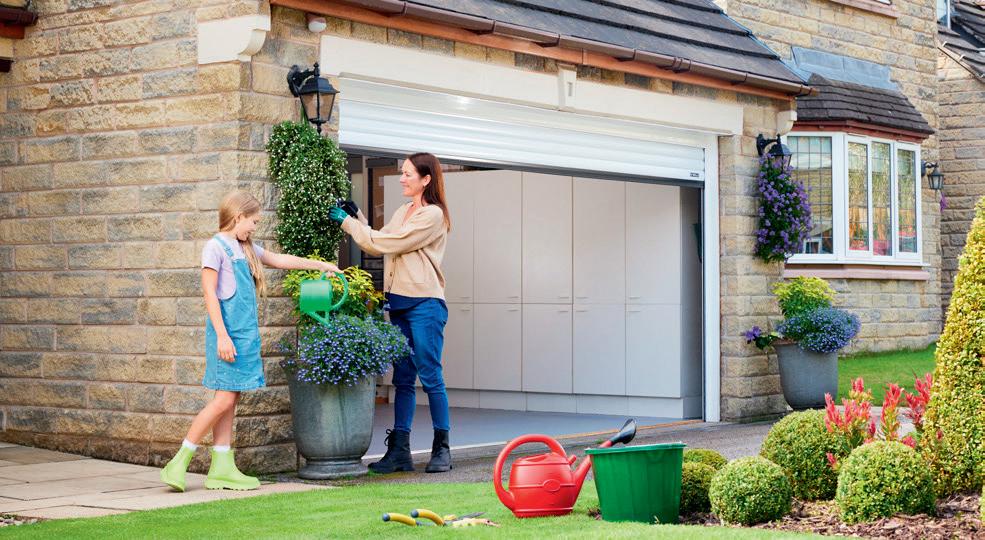

How secure is your house? Insurers, the police and technology companies are all there to help you keep it safe and sound
Home security is a perennial issue, and often when the winter months come on, we’re warned that opportunist burglaries from houses and outbuildings become more common. There are certain obvious security measures you can take, like making sure that doors and windows are locked and that lights are left on to give the impression of occupancy; but a chain is only as strong as its weakest link, so any opportunity you leave open to crime is one that may be exploited.
A common weak spot is the garage; this can often be used to store not only your car, but also valuable garden equipment (and even freezers full of food, a common target at Christmas). The trouble is that garage doors are often old and creaky, and not as secure your house door – of course the problem is compounded if the garage is attached to the house and has an access door into the main building.
A popular option for replacing outdated garage doors (or adding one to a carport) is an electrically operated roller door. Costing from around £1,000 depending on size and the materials used, roller doors provide security, insulation and space saving – since they roll up into the roof space rather than opening inwards or outwards, they give you much more space to use in your garage.
Since they can be operated by remote control, they also mean that you don’t have to stand in the rain to open them!
There are two main types of roller garage doors; face fitting, which install on the inside of your garage, with the top box and guides attached to the internal brickwork, maximising the access space; and reveal fitting, where the top box and guides are fitted within the opening of your garage. This is the only option if you have limited headroom on the inside of the garage which won’t accommodate a top box.
Replacement garage doors are available in a wide range of materials including steel, timber, GRP (glass-reinformed plastic), and aluminium. Steel garage doors are perhaps
the most common choice for homeowners seeking a balance of strength, durability, and cost-effectiveness, requiring minimal maintenance to keep them free of rust, while timber garage doors offer a timeless, natural beauty, although they’re prone to warping and rotting if not properly maintained.
GRP (Glass Reinforced Plastic) garage doors provide a lightweight yet durable option with low maintenance requirements and versatile design possibilities, while aluminium garage doors combine lightweight construction with excellent insulation properties, making them a modern and efficient choice for many homes. »

Obviously there’s no point fitting secure doors and windows unless their locks are equally secure.
Mechanical door locking systems range from automatic and key to lever mechanisms, available for single and double door solutions. Automatic multi-point locking systems can lock automatically when you pull the door closed, without the need to lift a handle or use a key, and can be tested to and compliant with the requirement of PAS24:2022 and Secured by Design codes.
Locks with multiple deadbolts as standard give high security and peace of mind, and can be used with a range of doors including composite, timber, aluminium or PVCu, while double door locking system are available for composite and timber doors.
It’s also worth checking with your insurer that all your locks are insurance compliant. If you have a break-in and you find you have sub-standard locks, you may not be able to claim.
If you want some advice on home security, the Police PCI is there to help.
The Police Crime Prevention Initiative is a police-owned organisation working on behalf of the Police Service throughout the

UK over the last 20 years, to deliver a wide range of crime prevention and demand reduction initiatives.
In 2022/23 there were 275,919 burglaries in England and Wales, a slight decline on the previous year. Since 2002/03 there has been a clear trend of falling burglary offences, with the most recent year having the fewest burglaries in this time period. Whatever other trends are at work, it would be good to think that improved security measures are in part responsible for the decline.
According to government data, over a third of domestic burglaries across England and Wales are committed during the evening. The most common time for a burglar to strike is between 6 pm and midnight, likely due to dark nights and the possibility that homeowners will be out of the house.
Statistically, corner houses with neighbours on only one side and houses that are concealed or covered by trees or architectural designs are more likely to be robbed. »


With a lower operational force than any of our autoLocks, AV4 offers user-friendly operation making it a reliable solution suitable for all users from children to grandparents
AV4 offers significant advantages for fabricators and installers, as it is able to work in situations where other locks might not perform as well due to its low force to operate. Not only does this reliable locking solution reduce the need for costly replacements over time, but it also minimises the expenses associated with frequent maintenance visits, altogether enhancing the reputation of fabricators and installers within the industry.
For landlords, housebuilders, housing associations, and councils, AV4 presents a versatile solution that caters to a wide range of tenants. This versatility translates into tangible benefits such as time and cost savings.
With AV4, there‘s no need to invest in multiple locking mechanisms to accommodate different tenant preferences or property requirements, streamlining the procurement process and reducing overall expenditure.
For tenants and property owners, the AV4 offers user-friendly operation, ensuring ease of use for individuals of all ages and abilities. Its low force to operate allows accessibility to everyone, including those with disabilities that affect their ability to grip or apply force. Additionally, the longevity and reliability of AV4 means that occupants can enjoy the convenience of a single, dependable locking solution throughout their tenure - from children to grandparents - promoting a sense of continuity and stability within the property.




Voted 3 Years In A Row By Installers










Voted UK's No.1 Composite Door
3 Years In A Row By Installers
Price Freeze Since April 2022
Rated Excellent On Trustpilot
Manufacturing 30+ Years
� Made In The UK
2000+ Colour Options
Impact Resistant Skins
Weather Tested
10-Year Warranty




Thermally Efficient
� Police Approved Security Accreditation (optional)
Potentially Save Money On Heating Bills
150+ Door Designs
2000+ Colour Options
Anti-Bowing Technology
Enhanced Soundproofing
Steel Reinforced Frame










www.qrco.de/bfSrdn



The most common points of entry for home break-ins are the front door - 34% of burglars twist the doorknob and walk right in; first-floor windows - 23% use a first-floor open window to break into your home; and the back door - 22% come in through the back door.
All you have to do is to make your home look like a difficult target, and a burglar will move on to another property.
One of the PCPI’s most valuable initiatives is SBD – Secured By Design - the official police security initiative working to improve the security of buildings and their immediate surroundings to provide safe places to live, work, shop and visit.
SBD’s product-based accreditation scheme – the Police Preferred Specification - provides a recognised standard for all security products that can deter and reduce crime.
There are currently many hundreds of companies producing thousands of attack
resistant crime prevention products, across 30 different crime categories, which have achieved Police Preferred Specification.
The Secured by Design logo and title ‘Police Preferred Specification’ indicates that a company or a product meets the high standards set by Secured by Design. Usage of the logo is restricted exclusively to those products that have successfully tested to Secured by Design requirements. The website www.securedbydesign.com has a searchable database of approved products and companies.
For further advice about security, or to find out how to buy police-recognised property marking solutions, visit www. securedbydesign.com/home-security.
As most burglaries are achieved through the front door, it’s obviously essential that you fit the most secure doors and locks available.
The good thing about a modern front
door is that it can deliver security, heating efficiency and fire resistance.
A typical modern front door might include a rigid polymer subframe, a high-density CFC-free polyurethane foam core, a high impact resistant GRP skin and high-quality multi-point locks. With the proper fittings and glazing, a door set should achieve PAS24:2016, the industry’s enhanced security standard, a prerequisite in attaining certification to Secured by Design (SBD), the police initiative to protect against unlawful intrusion.
For extra security, you might want to fit a steel-reinforced door frame as opposed to plastic.
A GRP composite door of this type can also be more thermally efficient than a 48mm solid timber core composite door, as well as providing excellent noise reduction.
Composite doors are low maintenance, requiring only cleaning with soapy water, and are often available in a wide range of RAL standard colours. ■


Security systems are getting more sophisticated, yet easier to install. We look at the latest in CCTV technology
Home CCTV (Closed Circuit TeleVision) security systems have become an integral part of modern living, providing peace of mind by safeguarding properties and loved ones. With advancements in technology such as smartphones, Wi-Fi and other smart devices, homeowners now have access to a variety of CCTV options, ranging from video doorbells to sophisticated dual-lens cameras.
CCTV systems deter potential intruders, provide evidence in case of theft or
vandalism, and allow homeowners to monitor their properties remotely. With the advent of smart technology, modern CCTV systems offer seamless integration with other home security devices for enhanced safety and convenience.
Video doorbells have become incredibly popular for their dual function of doorbell and security camera. With features such as two-way audio, motion detection, video recording, and live streaming, video doorbells are ideal for monitoring entry points and interacting with visitors
remotely. Costs are typically from £50 to £250, depending on features and brand –some require a subscription payment.
The basic unit of any CCTV system is the camera, often combining video camera functionality with powerful lighting to illuminate areas and capture clear footage. Features can include motion activation, tuned so as not to be activated by the occasional cat or fox; HD video, night vision, and connection to alarms. Camera
lights are ideal for driveways, gardens, or dark areas requiring extra visibility, and cost around £100 to £300.
Smart tracking cameras follow movement within their field of view, ensuring comprehensive monitoring. They are ideal for covering large open areas like back yards or patios, and can feature AIdriven motion tracking, app notifications, and real-time video. Typical prices are around £80 and £200. An alternative to smart tracking is the pan-and-tilt camera, which can be remotely controlled to pan (move side to side) and tilt (move up and down), offering wide coverage. Some have zoom capabilities, and two-way audio.
Unlike traditional night vision cameras, colour night vision cameras can provide full-colour footage in low light, improving clarity and detail. They are ideal for highrisk areas where detailed visuals are crucial.
Some CCTV systems use phone networks and cloud data storage instead of Wi-Fi connections, making them reliable even during internet outages. They are ideal for rural areas with poor Wi-Fi or backup during power cuts, but can cost around £200 to £500, plus subscription fees.
Dual-lens cameras provide a wider field of view and better depth perception by combining two lenses in one unit. Again, they can be more expensive than standard cameras, but are ideal for covering expansive areas like driveways or large gardens.
Integrating CCTV systems with alarm systems enhances overall security by combining visual monitoring with instant alerts. Some benefits include unified control of cameras, alarms, and sensors via a single app or control panel, and automated responses, so alarms can trigger cameras to record or floodlights to activate when movement is detected. They can also provide real-time alerts for unusual activity.
When planning to install a CCTV system, the size and type of your property is the main factor.
Small Homes or Apartments: A video doorbell and a few strategically placed cameras are usually sufficient.
Medium-Sized Homes: Add pan and tilt cameras for wider coverage and a floodlight camera for outdoor areas.
Large Properties: Combine multiple camera types, including smart trackers and dual-lens cameras, to cover extensive grounds.
Indoor: Opt for compact cameras with motion detection and audio features.
Outdoor: Choose weatherproof cameras with night vision, floodlights, and wide-angle lenses.
Wi-Fi Cameras: Convenient but may face connectivity issues.
Cellular Cameras: Ideal for locations with unreliable internet.
Costs can vary significantly based on features and brands, so set a budget and prioritize must-have features. Ensure your system offers encrypted data transmission and password-protected access to prevent hacking.
Many modern systems are designed for easy setup, saving on professional fees, but professional installation is recommended
for large or complex systems to ensure optimal placement and functionality.
Maintenance tips for CCTV include: h Regularly clean camera lenses to maintain image clarity.
h Check for software updates to ensure system security.
h Inspect cables, connections, and power sources periodically.
A basic CCTV system with a few cameras can start at around £300, while advanced setups with multiple high-tech cameras can exceed £3,000. Additional costs may include subscription fees for cloud storage or cellular connectivity.
Home CCTV systems offer an effective way to enhance security, providing peace of mind and protection against potential threats. By considering factors such as property layout, connectivity, and integration with alarm systems, homeowners can make informed decisions and create a tailored security solution. Investing in a high-quality CCTV system is not just about protecting your propertyit’s about ensuring the safety and wellbeing of your family. ■











How can you change the mood of your home using modern lighting? There are all sorts of options to set the scene
Finding the right lighting for your home can be a challenging process, as there are so many styles to choose from, and the fittings that you select will have a huge impact on the entire feel of the household. From antique to modern, you have a selection of styles to choose from, as well as di erent types of lighting from table lamps, chandeliers and pendants to wall lights, and even concealed lighting.
Part of your choice will be stylistic; if your décor is modern, you will probably choose a stylish contemporary design such as downlights or adjustable angle spotlights on plates or bars, while a traditional house will benefit from suitably traditional lighting such as chandelier styles or designer wall lights.
There are also practical aspects to consider – for instance if you have young
children you probably don’t want a lot of table lamps, and if you don’t like dusting at height, you might opt for inset lighting units.
Apart from your lighting style, the other aspect of lighting to consider is the bulbs. Remember that halogen bulbs have been phased out for sustainability reasons; fluorescent bulbs are also on their way out. The modern alternative is the energy saving bulbs or CFL (Compact Fluorescent Light), which don’t create heat, so they are around 80% more e icient than traditional bulbs. They can also last up to eight times longer, which means you don’t need to replace them as o en. LED bulbs, available in a number of styles, are a little more expensive, but o er significant energy savings - a 50 watt halogen
GU10 bulb can now be replaced by an LED that consumes as little as 5 watts.
CFL bulbs are available in a range of di erent colour temperatures from cool daylight white to warm white, so you can adjust the temperature in each room to create a di erent mood. CFL bulbs can also be used in exterior light fixtures, but they should be covered well to avoid water damage.
Brighten your home this autumn/winter with BHS at Litecra ! Discover stylish and a ordable lighting solutions for every room, from sleek ceiling lights to statement lamps. Visit us online at www.litecra .co.uk or at one of our UK store locations in Chadderton, Leeds, or Glasgow, and let our expert team help you find the perfect lighting to transform your space. ■


We are P PET T FLAPS S UK, your ultimate destination for the largest range of Cat Flaps and Dog Doors in the UK. Whether you're looking for budget-friendly options or premium, energy-efficient pet flaps, we have something to suit every need and style.
Our expert team can install pet flaps in French doors, windows, and sliding patio doors across most areas of the UK.
For doors and walls, our skilled carpentry and building tradespeople cover a wide range of cities, counties, and even some rural areas.
We are rapidly expanding, so get in touch to see if we have installers in your area.






RANGER by Freedom Pet t Pass *New w to o UK Market* - these pet flaps are 15 times better at keeping the cold out than other brands, thanks to their DoubleMag technology that creates an airtight seal.

S SureFlap - Offers a range of microchipped cat flaps and dog doors with draught excluding strips to help keep the cold and unwanted animals out.
PetSafe - Features a cost-effective range of dog doors designed to withstand extreme weather along with other microchipped and 4-Way flaps
T Tomsgates - Premium, beautifully handmade wooden pet flaps that are extremely energy efficient and the only solution for an XL Dog Door in glass.
H High Tech Pet t - The only automatic pet flap range in the UK, with a world first installation for glass. These flaps are very secure and thermally efficient
P Pet-Tek - high quality, , virtually indestructible 4-way pet flaps
O OnlyCat - featuring AI technology, this cat flap stops the cat from bringing home mice and other unwanted gifts!







Fitting a pet flap should be possible even in the most challenging situations. We solve some pussy problems and doggie dilemmas

The invention of the cat flap has been attributed to Isaac Newton, with one urban legend suggesting that he created a hole in his door and draped a cloth over it as a flap after his cat kept ruining photosensitive experiments by opening the door and letting light in. But certainly, there have been doggy doors in churches going back to the 16th century, so Isaac probably wasn’t the first.
But if you have a cat or a dog - and apparently 25 percent of households have cats, and 36 percent have dogs - the modern pet flap presents pussy problems and doggie dilemmas. For a start, modern construction techniques make them harder to fit, and secondly, you have to be aware of issues such as heat retention and security.
Fortunately, contemporary pet flap specialists have worked out high-tech solutions to most problems. One common problem with cat flaps is random cats getting into your house; for this problem, solutions include flaps which can be encoded to your pet’s microchip. These flaps can have integrated timer controls and override locks, and be built with draft exclusion and weatherproofing features. Four-way cat flaps can be activated by magnetic collars, and can have settings such as entry only, exit only or free movement.
Cat flaps can be built into a wide range of walls, glass and doors, including through brickwork such as conservatory walls, into sliding patio doors and even in security doors; there are very few situations that experienced installers cannot cope with.
The situation is slightly different for dog doors, which are commonly larger than cat flaps, and not generally suited to microchip control, as dogs like to run towards them rather than approaching them at a leisurely pace. For the same reason, dog doors are not normally designed for installation through glass, though some specialists will find suitable models for you. There are certainly plenty of options for dog door installation through solid doors including PVC, wooden and composite.
A consultation with a specialist pet flap installer will help to resolve issues such as location, height, and obstructions such as pipework. You can often get a consultation remotely by sending photographs and measurements.
Once your pet flap is fitted, you can relax in the knowledge that Tiddles and Mr Woofy can let themselves in and out, and you won’t have to get on your feet every five minutes to cater to their whims! ■








































If you are trying to sell or rent a property, looks are everything. Now a trend known as ‘staging’ makes it easier for you to present your property in a good light
When you are selling a property, we are told that there are some essentials to make it more immediately attractive; tidy the front garden for improved ‘kerb appeal’, lock away annoying pets (and children), redecorate in neutral colours, improve lighting – even to fill the house with the smell of fresh co ee or baking bread!
But while a completely empty property may be easier to sell in some cases, when you want to make your home look more immediately liveable, an empty shell probably isn’t the best idea. So, what do you do if your furniture consists of worn-out sofas, wobbly tables and rickety chairs? You need a bit of professional ‘staging’ to present your home in the most appealing light.
Professional staging companies claim


that properties using their services will typically sell for 10 percent more, so the investment is well worth it. According to a report by the Home Staging Association, estate agents also agree that a ‘staged’ presentation makes it easier for buyers to visualise the property as their future home, and makes it more likely to attract multiple bids.
Staging needn’t be a complicated a air; many professional companies o er a ‘speed staging’ service with a walkthrough consultation done in a few hours. Whether you choose this or a full service, staging should present your property in the best possible light, and o er a good return on your investment.
The first step is to address what sort of potential buyers or renters will be
interested in the property; the staging company will then match the presentation of the property to appeal to the appropriate audience. The Home Staging Association reports that 100 percent of vendors who used a home staging service found it a useful marketing tool, and 75 percent said that it had helped to increase the value of o ers.
A home staging consultant will want to visit your property for an assessment, and will advise you on what work you can usefully do yourself, and what expenses will be involved in further work to present the property. This can involve anything from simple decluttering, gardening, decorating and maintenance work, to furniture rental and professional photography. Staging can work particularly well for remote or virtual presentations, which of course became very popular during lockdown. ■
SIMPLE THINGS THAT TAP INTO THE PSYCHOLOGY OF SELLING OR LETTING A PROPERTY ARE KEY. TINY, YET CRUCIAL DETAILS HAVE A HUGE IMPACT ON THE SUCCESS OF A SALE, THE SPEED AND THE BOTTOM LINE.
Karen Livock of Surfhouse Interiors in Yorkshire spills the beans on how her Interior Design skills and property staging expertise combine to create great results for clients.
Karen gets right to the heart of what makes a buyer or renter choose one space over another.
“It’s an emotional connection that’s subconscious yet drives a desire and in turn, drives a sale or a let. I’m here to elevate a space to its full potential which boosts interest and maximises my client’s ROI.
People often forget what a powerful factor emotion is when it comes to a rental or a holiday home. We’re essentially selling a lifestyle, within four walls.
We want people to aspire to live there. To buy into that feeling of calm, be inspired and fall in love with a space.
Even if it’s just for a couple of nights in a holiday let. It has to look good and feel good too.
Taking a look at the competition is vital to determine what else is on the market and how we can make the properties we work in stand out.
It’s not about personal taste, it’s down to wider appeal and what will create attention and drive action to meet our client’s goal.”


Everything at Surfhouse Interiors is tailored to each unique project. Orchestrated to achieve great results and make sure our clients make money.
Karen draws on both interior design skills, property staging skills, and an impressive stock of constantly changing furniture and accessories to create those desirable images that sell.
If you’d love to work with Karen and her team to elevate your property and maximise the return on your investment, get in touch by calling 07857931146, or email karen@surfhouseinteriors.co.uk for a chat about how investing in professional property staging can dramatically change your results.
Looking
for a way to zhuzh up your home and give it an up-to-theminute interior design style? Here are five suggestions from top interior experts to perk up your parlour and brighten your bathroom

Wallpaper borders were one of the biggest trends of the 90s, and three decades later they are back for a new generation of interior aficionados.
Www.fionahoward.com has launched a three-strong collection offering a fresh take for 2024.
Comprising of Jasmine Leaf, Sunflower and Squiggle, the Border Collection was created to complement existing Fiona Howard designs, or to be used as a standalone interior statement.
Squiggle is a 60s-inspired design. Measuring a diminutive 8.6cm in height, Squiggle was created to be used as a decorative border around architectural features, such as windows, doors and wardrobe panelling.
Nature-inspired Sunflowers offers a stylised take on the classic floral and has been created to bring joy wherever it is used, be it a nursery or child’s bedroom or the more utilitarian spaces of the home such as the kitchen and bathroom.
If there is an interior design trend that never seems to go out of fashion, it’s Alpine Style –each year new incarnations emerge. Luxury furnishing and furniture retailer www.arighibianchi.co.uk has launched a carefully curated collection of Alpine homewares so that customers can recreate the ambience of the Alps in their own homes.
The range includes quirky ornaments, fabulous faux fur soft furnishings, and statement ski-inspired accessories all available both in store and online, with nationwide delivery available throughout the UK.
“Ski chalet chic remains a perennial favourite, especially in the winter months, blending the warmth and cosiness of mountain living with contemporary design elements,” says interior expert at Arighi Bianchi, Lucy Mather.

“A neutral design scheme allows for greater playfulness with textures, tones, patterns, and finishes,” says Claire Garner, Director at clairegarner.com. Claire’s top tips for building a serene and relaxing palette include:
1. Experiment with texture – “This could be through soft furnishings as well as flooring, tiling and hardware. I love to layer tactile textiles in calming settings and source organic handmade elements through lamps and objects to add a wonderful grounding element.
2. Add the warmth of woods – don’t be afraid to mix different wood finishes in the same space, this will create a more eclectic and interesting space.
3. Layer tones & muted colours – neutral doesn’t have to mean no colour… you can 100% use beautiful muted colour tones, especially serene greens and calming blues, along with warming blushes and faded terracottas.
4. Add art & architectural detail – clever and intricate elements will add a wonderful depth to your scheme, this could be through furniture pieces, lighting and joinery.
5. Connect with nature – by connecting with the outdoors, this will help to add both relaxing and uplifting elements. As much as I do love an olive tree…. This could also be added through print, pattern and colour palette.”
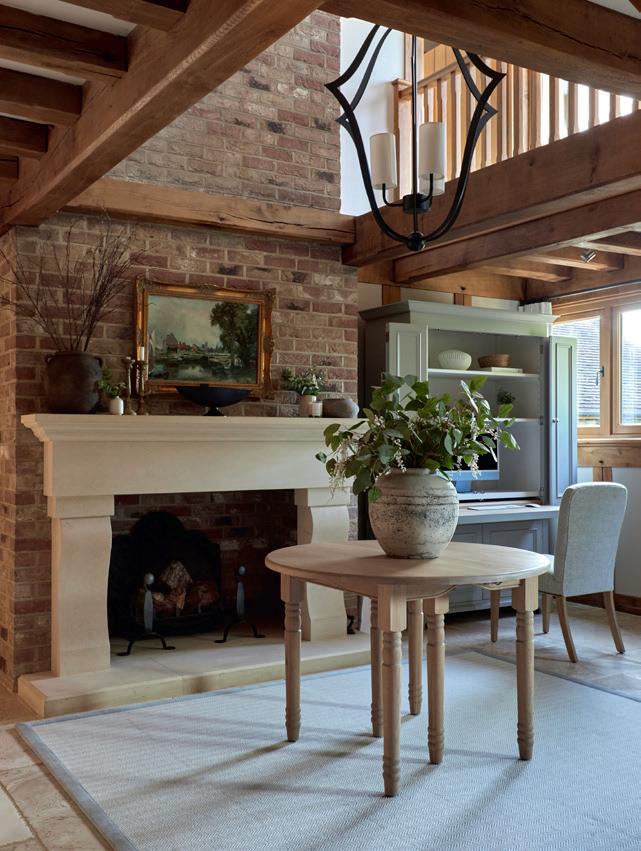

One of our favourite interior design trends for 2025 will see many textured materials such as linen, wool, and jute, with layering being key to creating a cosy sanctuary in your home. For those looking for a budget-friendly way to bring texture into their space, consider wood or stone-effect tiles. These options allow you to achieve a luxurious, textured aesthetic without the cost of solid materials. The key here is to mix and match different textures to create a space that feels both snug and homely. Stanley LVT Flooring – Mid Brown from www.directtilewarehouse.com combines style and functionality, making it an ideal choice for any domestic interior. The warm, mid-brown hue adds a touch of elegance to your space, complementing both modern and traditional decor.
Quiet luxury interiors are minimalistic, wellcrafted, and designed to stand the test of time. It’s no wonder this sophisticated style remains one of the top interior trends as we approach 2025. Amthal Karim, Head of Design at FurnitureAndChoice.co.uk, comments: “Quiet luxury is a popular trend that started in the fashion world but has quickly gained a big following in the home space too.
“As homeowners gravitate towards all things classic and a desire for better quality products, Quiet Luxury has become an aspirational look in interior design. To achieve this discreet yet luxurious vibe in your home, muted colours, bespoke furniture, and timeless décor are key features.” ■





Transform your living space with the power of a dehumidifier! By removing excess moisture from the air, it not only prevents annoying condensation and dampness but also creates a healthier, more comfortable environment. Say goodbye to mould and mildew, and hello to fresher air and lasting protection for your home and contents.

Say goodbye to mould and mildew, and hello to fresher air


• Purify air by reducing dampness, mould, and odours.
• Better moisture control for easier breathing.



Dehumidifiers work their magic by drawing in humid air and passing it over cold coils. As the warm air meets these cool surfaces, moisture transforms into water droplets, which are collected in a tank. The now drier air is (gently) released back into your space, leaving your room feeling fresh and comfortable!

Added benefits.. Dehumidifiers o er an e icient way to dry clothes year-round, perfect for those without outdoor space, during rainy days, or to save on tumble dryer costs. Drying clothes on radiators is not ideal; it not only blocks valuable heat, but also releases moisture back into your home.







Starting with the compact 0.7L, perfect for small rooms or tight spaces. Being an absorption dehumidifier, this unit warms up the air slightly and extracts moisture e ectively in temperatures below 15°C, unlike condensation or compressor dehumidifiers, which perform better in temperatures above 15°C. For mid to larger sized rooms, the 10L and 16L are top choices, featuring intuitive touch controls and easy-to-remove water tanks for hassle-free operation.














Step up to smart control with the higher range models! Manage your dehumidifier e ortlessly via the Princess Home app or even voice control. Schedule, set timers, and monitor humidity levels right from your phone. The 20L Smart comes with a generous 3.7L tank, perfect for extreme dampness control or less frequent emptying.
The powerful 30L Smart is designed for maximum water extraction in a day, with a 4L tank to keep your home fresh and dry.
AVAILABLE FROM ARGOS AND OTHER LEADING RETAILERS OR VISIT
PRINCESSHOME.EU






























































Leaks and flooding can be destructive to both property and health. What are the best ways to stave o damp, mould and water damage?
The fabric of a building can be damaged by all sorts of factors, many of them related to the British weather – we’re getting used to increasingly cold and wet winters and boiling hot summers, as climate change has its way.
If not dealt with promptly, issues such as condensation and leaks can lead to destructive conditions such as mould, which can a ect both the health of a building and that of the people who live in it.
Worse, catastrophic events such as floods and storms can cause major damage overnight, and without planning, can take months or years to repair.
So how can we take care of the health of our buildings as well as we do our own? The answers start with the basic design of structures.
There are many di erent possible sources of water leaks in a building; anything from
exterior water mains to central heating or underfloor heating, hot or cold water systems, ground source heat pumps, and lo water tanks to swimming pools or spas.
In cases where water damage is caused by leakage, leak detection systems can prevent extreme damage in the first place, or can locate sources of leaks to minimise damage a er the event.
Specialist leak detection equipment can detect leaks through all types of internal floors or external hard surfaces including concrete and tarmac, outdoors in fields or open spaces, under landscaped gardens and even under buildings.
The essential aspect of leak management is to detect and deal with the leak as soon as possible. Undetected leaks can cause huge amounts of damage before they are spotted. For instance, if your central heating stops working or your boiler is losing pressure, it is highly likely
that you have a leak on the hot feed or in the central heating system.
In sealed systems such as heating circuits and heating systems, tiny invisible leaks known as Micro Leaks can result in a slow and constant loss of pressure in the system with no obvious cause. Micro Leaks tend to occur more o en in heating circuits and hot water pipes, and as the water is hotter, it evaporates far more quickly leaving little or no trace. The constant loss of pressure will eventually lead to a boiler breakdown. Finding, diagnosing and repairing these leaks will ensure that your heating system won’t fail you when you need it the most.
Specialist leak detections services can use a wide variety of technologies such as acoustic listening devices, tracer gasses, dampmeters and endoscope ‘snake’ cameras to find the source of a problem without knocking holes in your walls and floors. »
Another problem which can lead in the long term to health problems for both people and properties is humidity, the amount of water vapour present in the air. Excess humidity can lead to growth of mould and mildew, and even structural damage, particularly to wood. Mould can even grow in carpets and can be hard to eliminate. On the other hand, excessively dry indoor air can lead to warping or cracking of wood furniture and building materials.
The recommended humidity level for dwellings is 40-59 per cent. The most important percentage to remember is 60 percent relative humidity - at this point your home becomes a veritable incubator for bacteria and virus growth.
In the winter you can lower humidity by raising air temperature or running fans to improve air circulation. Ventilator fans
in the kitchen and bathroom can be left running for 15 minutes or longer to clear out lingering moisture. You should also ensure proper ventilation of appliances such as clothes dryers to the outside. Try not to dry wet washing indoors - it’s hard in the winter, but you should do your best to peg things up outdoors when you have the weather.
For better control of indoor humidity, dehumidifiers can control humidity levels in the home, workplace and other indoor areas such as swimming pools, garages and boats.
The six signs that you need a humidifier in your home are:
1. Condensation on windows and glass doors
2. Mould spots on walls
3. Rot on wooden floors and furniture
4. Musty smells
5. Allergy symptoms such as sneezing and
watering eyes
6. Visible water damage to ceilings and walls
Dehumidifiers can prevent mould growth and stop the moisture from reducing the lifespan of window frames or bathroom ceilings and walls, and have a range of other health benefits too. Air at a controlled lower humidity is easier for people suffering from asthma to breathe, and also reduces the number of asthma triggers such as dust mites. Many humidifiers are fitted with filters to capture fine impurities in the air and to disrupt microbe reproduction.
Dehumidifiers can also reduce energy costs; due to the reduction in water particles in the air, lower humidity levels allow for significantly cheaper heating during winter months as you can run the heating less and at a lower temperature. ■




Are you aware that in the UK, Insurers pay out around £1.8 million per day on claims for water damage. In fact, around 30% of all claims are for escape of water with the average payout being around £6,000.
Most leaks are caused by burst pipes, faulty connections, or damaged equipment such as ball valves or dishwasher valves. Left unchecked or if the property is unoccupied, a large volume of water can escape causing devastating damage to the property, not to mention destruction to personal items with high sentimental value. Thankfully, there are ways to mitigate the amount of damage caused by leaks! For many years, water leak detection has been used in the commercial world and it is from this that we find the solution. Two types of systems have developed, one based on sensors, where if water comes into contact with them, they trigger an alarm. The other is based on how much water continuously flows into a building.
Both methods to detect water leaks are now incorporated to provide a robust solution for the domestic/ residential market.
The Imrita, a smart home leak detector employs a combination of both flow monitoring and sensors for leak detection. In fitting an Imrita on the mains cold water

pipe that feeds the property, it is possible to monitor how much water is being used and in doing so protect the entire house or flat. Setting the flow of water against thresholds as a maximum in volume and time will allow for normal water usage in the property but significantly reduce the escape of water if there were a leak. Add to this the option of having wireless sensor probes positioned in the most vulnerable areas and the property will have the best coverage against water leaks possible.
More homeowners and landlords are fitting the Imrita smart home leak detector and benefiting from the peace of mind that their properties are continuously protected 365 days of the year. Many have reported that they liked the easyto-use settings and have remarked on the following benefits:
It will alert them that there has been a leak even if it is not immediately obvious or the property is empty.
It offers peace of mind that the property is protected.
It has the potential to greatly reduce the need for expensive repairs following a leak.
It can be used to turn the mains water off and on simply be using a phone app or the handy key fob provided.
It can detect small leaks down to only 5L of flow per hour.
It can also detect large leaks such as burst [pipes and quickly turn the water off.
The phone app can be used to see if there is a leak, turn the water on and off and to easily adjust the threshold settings.
So, the lesson to learn is to fit before there is a catastrophic leak and avoid the stress and inconvenience of having to repair the damage and replace those precious personal items that may have been lost.
Every home has an interior design ‘superpower’ – so what’s yours? Some superpowers are obvious, others don’t jump out at you and need to be encouraged.

Every home can have a superpower which adds to its appeal and resale value. Cathy Dean, Founder and CEO of Studio Dean (studiodean.com) says: “The key is to not think about your house like everyone else would. It’s surprising how many assumptions we can make about certain builds and how this can affect our interior design and architecture choices. Just because you have a terraced house, doesn’t mean it needs to act like every one on the street..”
“Symmetry is the key to beauty, and beauty is power, so if your home has it, use it! Georgian houses have beautiful symmetry, but sometimes it doesn’t suit how we live now. You should always try to keep the proportions and regularity in place
and keep everything symmetrical, so please don’t turn windows into doors as it will make the house look lopsided.”
“Prioritise function over form and understand that you need to flow easily between your spaces. This doesn’t always mix well with leaving symmetrical architecture alone. “
“If your house is of a certain age, it was built with its own inherent superpowers. These give it character and tell a story of its age and origin which you can’t replace or fake. Original fireplaces, coving, window frames, doors and flooring are all treasures.”
“Our mantra is “what’s old is old and what’s new is new” so we will never try
to make period features modern, or put period features in modern homes (yuck!). Celebrate homes for what they are. Keep all the history and features that you can, and use colour and decor to frame, spotlight and personalise them.”
“Did you know that features were only glossed white in the past because it was cheaper? There’s no reason why you can’t paint skirting boards, doorframes etc. in bold colours.”
“Pick windows, doors and fireplaces out with bold colours. Draw attention to key windows to frame superpower views.”
“The way the light hits and enters your house through the day can be a real superpower if you harness it well. Observe how light falls at different times of the day
and year, then make the most of it. It might be useful to speak to an architectural interior designer at this point.
“Super spatial planning will take your interior architecture and make it perfect for your lifestyle. Maybe you don’t need three ensuites that you never use! Maybe one larger family bathroom would work best for you, and then you can have a cheeky yoga space or upstairs laundry room. To maximise function, we love to add butler’s kitchens, pantries, boot rooms, mud rooms and even dog-washing and drying rooms – all superpowers!”
“Optimising the way you flow through your home immediately elevates the whole space, and makes your life easier. There are several ways to power up your flow. Architecturally, you can move, remove or add stud walls to improve function and flow. Add, remove or disguise doors to direct flow to and away from public and private spaces.”
“To make your whole home flow, keep your flooring consistent all the way through, making your interior design cohesive.”
“Sometimes it’s what’s outside your home that is your superpower. If you have a gorgeous view to one side of your house, redesign your interior architecture to harness it throughout.
Move all the rooms that you spend quality time in to the ‘view side’ so you are waking up, eating and relaxing with the view. Open up sightlines by removing walls through the house so you can see the view throughout. Put lesser used rooms the furthest from the view – such as bathrooms, boot rooms and snugs that are usually used when it’s dark.”
“Don’t fake period features. Bring in modern architectural features that make an impact. Adding modern wood panelling or other features to ceilings adds character and won’t look out of place.”
“Use consistent materials, colour and texture to create a cohesive superpower. Use interesting wood all the way through to feel purposeful.
Don’t be tempted to add in period features such as a Victorian sash window to a new build, it is a pastiche.” ■
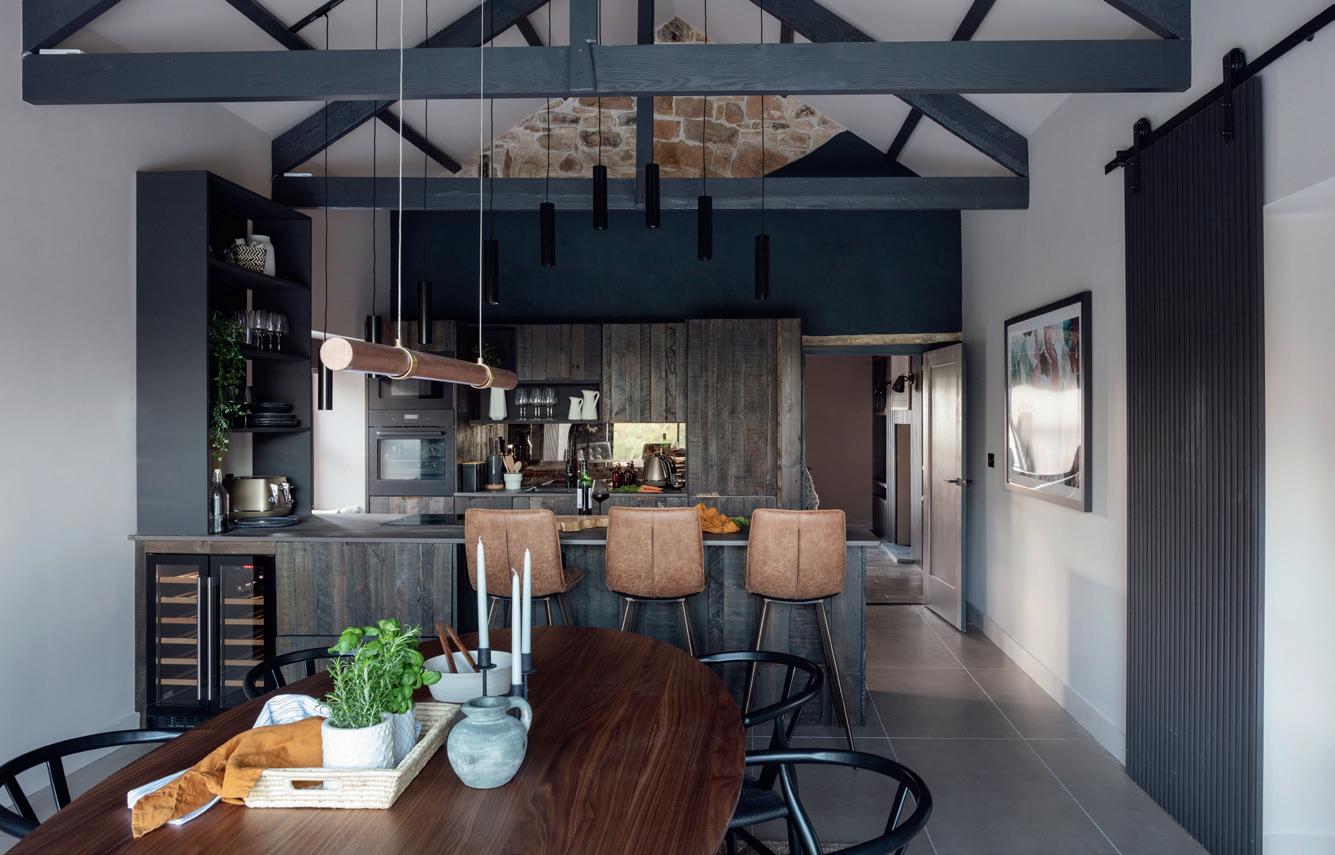











Wondering why FOCO 100% Pure Coconut Water is the best tasting coconut water in the world?
Because the most delicious and refreshing coconut water comes from young green coconuts grown in Southeast Asia.
Today, many brands source coconuts from all over the world, blending and mixing coconuts from various countries, compromising the quality and taste and distorting the natural flavour. But FOCO 100% Pure Coconut Water is harvested exclusively from dedicated plantations that enable us to keep the taste, quality and supply consistent.
Dedicated Coconut Plantations.
Dedicated Production Facilities.
Dedicated to Great Taste!
At FOCO, we control the product from picking, processing and packaging. Every batch undergoes a careful Ultra High Temperature (UHT) process to ensure freshness and shelf stability.
We also pack our coconut water in a dedicated production facility (currently, FOCO is the only brand produced in its own dedicated facility), and we never overstock (so every batch retains maximum freshness). All this means you’ll enjoy the same delicious flavour every time you drink FOCO 100% Pure Coconut Water.
For generations locals have enjoyed this sweet, refreshing heavenly water – and benefited from its all-natural goodness. Now everyone who loves coconut water can get the very best tasting coconut water in the world – FOCO 100% Pure Coconut Water. Superior taste. Low in calories. Nutrient rich with 5 essential electrolytes. Awesome hydration. Drink FOCO and live life to the fullest!
FOCO 100%
Pure Coconut Water is available in 330ml and 1 litre cartons
Available in Sainsburys and Morrisons stores and leading Oriental Supermarkets.

They’re not exactly the clunky mechanical men of science fiction, but domestic robots are making their way into many households

Robots are no longer confined to science fiction or factory floors; they are now an integral part of our everyday lives. From vacuum cleaners that navigate around furniture to lawnmowers that maintain a perfect garden, robotic technology is transforming household chores. These devices offer convenience, efficiency, and an exciting glimpse into the future of home automation.
In the 1950s, it was common for manufacturers of household appliances to talk airily about a future in which the household would be entirely automated, and a domestic robot, usually in humanoid form, would carry out menial tasks such as cleaning and cooking; the fact that they didn’t have a clue how such technologies might work didn’t stop the speculation.
Nowadays, with miniaturised electronics, sensor technology, wireless communication and artificial intelligence all going for us, it seems that the way towards robotic domestic ‘servants’ is becoming clearer.
The idea of a domestic robot would be to save time, reduce physical effort, and integrate seamlessly into modern lifestyles.
So far, among the most popular robotic devices for home use are robot vacuum cleaners and robot lawnmowers. Both cater to everyday cleaning and maintenance, offering a hands-free alternative to labour-intensive chores
Robot vacuum cleaners employ sensors and cameras to map spaces, navigate obstacles, and clean efficiently. Equipped
with brushes, suction systems, and filters, they tackle dirt, dust, and debris with ease. Once programmed, these vacuums operate autonomously, freeing users to focus on other tasks. Compact and agile, they reach under furniture and into tight corners, and integration with apps and smart home systems allows users to schedule cleaning remotely, monitor performance, and customise settings.
Many models are designed to clean specific areas without wasting energy on unnecessary coverage.
While robot vacuums are highly effective, they aren’t perfect. They may struggle with thick carpets, tangled cords, or high-pile rugs. Additionally, maintenance, such as emptying the dustbin and cleaning the brushes, is required to ensure optimal performance.
Robot lawnmowers operate similarly to robot vacuums but are built much more sturdily for outdoor use. They use sensors, boundary wires, or GPS mapping to navigate gardens, trimming grass to a preset height. Most robot lawnmowers run on rechargeable batteries, emitting no greenhouse gases during operation, and since they are electric, are significantly quieter than petrol lawnmowers. Many models include sensors that stop the blades if lifted or tipped, reducing the risk of accidents.
The initial cost of a robot lawnmower can be high, and setup, particularly if laying boundary wires, can be time-intensive. Additionally, they may struggle with uneven terrain, steep slopes, or areas with dense vegetation.
Robotic technology in the home aligns with growing demands for convenience and sustainability. Devices like robot vacuums and lawnmowers are energy-efficient and require less human intervention, reducing the physical strain of household chores.
Robots are increasingly designed to integrate into smart home ecosystems. Using voice commands or apps, homeowners can synchronize their robots with other devices, creating a fully automated living experience. For instance, a robot vacuum can be programmed to start cleaning after everyone has left the house.
Domestic robots make home maintenance more accessible for individuals with physical limitations, disabilities, or demanding schedules. Their autonomous functionality ensures homes stay clean and well-maintained with minimal human input.
In a recent study by researchers from the University of Oxford, artificial intelligence experts predicted that up to 40% of household chores - primarily housework like cooking, cleaning, and doing laundry - will be automated within the next 10 years.
While challenges remain, advancements in AI, connectivity, and sustainable design


are steadily improving their performance and accessibility. For homeowners seeking convenience, efficiency, and cuttingedge technology, domestic robots offer a glimpse into the future of living.
In the past two years, there has been a wave of prototype general-purpose, humanoid robots such as those from Agility, Boston Dynamics, Figure, Prosper, Sanctuary, and Tesla. Prosper claims that it is making a robot called Alfie, a robotic helper for home or office. Alfie could clean, organize your things, and take care of small chores, such as watering plants.
Do we see a future where there are general-purpose robots for a broad range of tasks, powered by multiple artificially
intelligent learning systems? Carnegie Mellon University robotics researchers have already enabled robots to learn household chores by watching videos of people performing everyday tasks in their homes.
DeepMind, Google’s AI lab, describes how the use of artificially intelligent learning systems covering automation, reaction times, and motion tracking allowed their robots to learn about and understand complex tasks. To show the potential of these findings, they even produced models of robots opening and closing drawers, removing drinks cans from countertops, and moving items around. How long will it be before the robotic vacuum cleaner evolves into a real household servant? ■



The kitchen is more than just a place to cook—it’s the heart of family life. How could you make better use of your kitchen?
The kitchen shouldn’t be just for cooking - this multifunctional space can bring everyone together, from shared cooking adventures to evening games and warm conversations. Let’s look at some ideas for making the most of your family kitchen, creating memories, promoting wellness, and encouraging togetherness along the way.
1. MAKE FAMILY COOKING A TRADITION
Cooking together is one of the most meaningful ways to bond, and it allows each family member to contribute, learn new skills, and explore food cultures from
around the world. Set up a family cooking night weekly or monthly, where everyone participates in preparing a chosen meal. For young children, you can assign simpler tasks like stirring or setting ingredients in order, while older children can help with cutting, peeling, or more hands-on cooking. Try exploring a theme, like Italian pasta night or Mexican taco fiesta, to make the evening even more fun and engaging.
h Choose recipes suited to your family’s taste and skill level
h Consider planning meals that introduce new flavours and cooking techniques
h Encourage everyone to contribute ideas for dishes they’d like to try
2. DESIGNATE A FAMILY BREAKFAST BAR
If mornings are often rushed, a breakfast bar can simplify the routine. Designate a small area or counter space where everyone can quickly grab a healthy breakfast before heading out. Stock it with nutritious, grab-and-go items like fresh fruits, yogurt, granola, and smoothie ingredients. A quick and easy breakfast bar can be a helpful way to ensure everyone starts their day right, even when time is tight.
h Pre-made smoothie packs with frozen fruits and vegetables
h A selection of nuts, seeds, and granola for a yogurt parfait station
h Fresh fruit baskets and wholegrain muffins
For families with school-aged children, the kitchen can serve as a productive spot for homework or study time. Place a small desk or clear a section of the counter for school supplies, and ensure good lighting for reading and writing. Having a designated homework spot in the kitchen lets parents assist with questions while preparing dinner, creating an ideal setup for multitasking.
h A small basket with pencils, erasers, rulers, and paper
h USB ports or outlets for charging devices
h A comfortable chair or stool at the counter for focused work
Baking is an excellent way to enjoy the kitchen, especially during holidays or special occasions. Kids love getting their hands messy with cookie dough, and you can easily turn baking into a family event. Choose a simple recipe, like cookies or cupcakes, and let everyone contribute to different parts of the process.
Beyond treats, baking can also be educational. Kids learn about measurements, timing, and kitchen safety in a fun environment. Once you’re done, enjoy the results together as a family or package some of your baked goods to give to friends or neighbours.
h Holiday-themed cookies or gingerbread houses
h Cupcakes with DIY frosting and decorating stations
h Healthy baked snacks like granola bars or oat muffins
Game nights in the kitchen bring everyone together without the distractions of the living room. Choose board games, card games, or even cooking-based games to keep things engaging. A kitchen island or a cleared table works perfectly as a gaming spot, and you can combine it with snacks, mocktails, or finger foods to keep everyone entertained.
Some favourite kitchen-friendly games include classic card games, trivia, or even baking and decorating challenges. Game night in the kitchen can become a cherished family ritual, building lasting
bonds and tons of laughter.
h Family board games like Scrabble or Monopoly
h Interactive games like charades or Pictionary
h Cooking challenges, such as creating “mystery ingredient” snacks
Gardening doesn’t have to be limited to outdoors. Many families enjoy growing herbs like basil, mint, and thyme on their kitchen windowsills. Not only does this add freshness to your cooking, but it also teaches children about plant care and the importance of fresh ingredients. You can make it a weekly activity to water, trim, and harvest the herbs together.
For families without a lot of natural light, there are small hydroponic systems that can thrive in any kitchen. Besides herbs, you can also try growing microgreens or small vegetables like cherry tomatoes and peppers.
h Choose herbs that are easy to grow indoors, such as parsley, mint, and basil
h Invest in small pots or a mini hydroponic system for an easy-care option
h Use the herbs together in recipes, making it a learning experience for kids »

If your family loves cooking together, consider making your own family recipe book. Gather favourite recipes, whether they’re from grandparents, cultural dishes, or favourite meals you’ve made together. Get everyone involved by having each person contribute their own recipe, and even decorate the pages together.
Once the recipe book is created, it becomes a keepsake that can be passed down through generations. It’s a fun, creative way to preserve family traditions and remember the unique meals that bring your family joy.
h Use a binder or notebook to store the recipes
h Photos of each family member cooking or enjoying their favourite dishes
h Personal stories or memories associated with each recipe
Meal prepping as a family is a great way to make weekday meals easier and encourage healthier eating. Set aside time each week to plan, prep, and store meals together. Not
only does it lighten the cooking load for the week, but it also empowers everyone to make healthier food choices. You can prep ingredients, batch-cook certain dishes, and pack them into containers for easy graband-go options during the week.
h Assign different meal-prep tasks to each family member to simplify the process
h Choose dishes that can be easily reheated or enjoyed cold
h Make it fun with a “build your own” salad or taco station
Your kitchen doesn’t just have to be for eating - make it a wellness space, too.
Smoothie stations, fruit-infused water setups, and weekly “wellness shots” with ginger or lemon are easy to set up and encourage the family to adopt healthy habits. Kids can help choose ingredients for smoothies or juice blends, introducing them to the benefits of eating a rainbow of fruits and vegetables.
h Create a smoothie station with ingredients like frozen berries, spinach, and yogurt.
h Have a selection of herbal teas to help
with relaxation or digestion.
h Make fun, fruit-infused water combinations like cucumber-mint or lemon-berry.
When holidays roll around, the kitchen can be the centre of the festivities. Decorate it with seasonal colours, themed napkins, and festive decorations. Have each family member pitch in by decorating a cookie, making a holiday snack, or setting up a hot chocolate station during winter.
Whether it’s carving pumpkins for Halloween or setting up a mini chocolate fountain for Valentine’s Day, the kitchen is a versatile space where you can bring seasonal cheer and make each holiday extra special.
h Create a hot cocoa or cider bar for winter holidays
h Decorate the space with pumpkins, flowers, or twinkling lights for different occasions
h Bake seasonal treats, like heartshaped cookies or spooky Halloween cupcakes ■

Did you know that you can sell your kitchen and also nd the kitchen of your dreams at a fraction of the cost of buying new? Make money and help the environment at the same time. What’s not to love.
Please contact Love My Kitchen today, they will take care of the rest for you.


Love My Kitchen is a friendly, passionate team of kitchen reselling experts who have been helping clients buy and sell beautiful pre-loved & ex-display kitchens since 2015.
The RSPB’s annual Big Garden Birdwatch is coming back on 24th-26th January 2025. Sit back, relax and watch your garden birds for an hour. Whether you’re a newcomer or a regular, it all counts, and the charity would love to know your sightings. You may even get some surprises. Register in mid-December to take part in the world’s largest garden wildlife survey. In 2024, over 600,000 people took part.
On the day of the Big Garden Birdwatch itself, taking part couldn’t be simpler! You just spend an hour watching the birds in your garden, from your balcony or in your local park, and tell the charity what you have seen. If you see very few birds or none at all, that’s also really useful information, so let them know.
The Birdwatch began in 1979, when children’s TV programme Blue Peter asked viewers to post in their sightings. Much has changed since the 70s. In 2024, 9.7 million birds were counted.
So what are the UK’s top five birds? Celebrating its 21st year at the top of the Big Garden Birdwatch charts is the House Sparrow. These chirpy little characters were the most commonly sighted birds, with 1,442,300 counted over the Birdwatch weekend.
1. House Sparrow - 1,442,300
2. Blue Tit - 1,094,401
3. Starling - 879,006
4. Woodpigeon - 835,408
5. Blackbird - 708,004
Find out more from the video at www.rspb.org.uk/ whats-happening/big-garden-birdwatch.
From garden birdwatching to advice on avoiding flooding, all the latest ideas and trends in the garden market

2024 has been a special year for the National Garden Scheme with its show garden at the world-renowned RHS Chelsea Flower Show dominating the calendar in May.
Project Giving Back were the generous funders of a fabulous garden designed by Tom Stuart-Smith and brought to life by Crocus. Awarded a Gold Medal, the garden drew the attention of the crowds and significantly strengthened the NGS’s profile and reach with impactful national and global media coverage and e ective digital and social engagement connecting with a wide range of new audiences and rekindling conversations with old friends.

“To understand the wider impact of the garden we have brought together many of the facts and stats from the show and associated events in this Chelsea specific Impact Report,” says Chief Executive George Plumptre. “While this snapshot provides a glimpse of the impact that having a garden at Chelsea generates, we are confident that the legacy of the garden and the many new connections it generated, will continue to reap rewards for the National Garden Scheme and its beneficiaries in the years to come.”
A few key stats:
♦ 428% increase in media mentions compared to May 2023
♦ 700+ visits per minute to the NGS website on Saturday 25 May
♦ 1.4 million views to the ‘Find a Garden’ section during May
♦ 1362% rise in funds generated through merchandise sales
You can read the full report here: https://bit.ly/RHSChelseaImpactReport24
Homeowners are being urged to flood-proof their gardens as the wet weather sets in. Experts from Gardening Express have suggested eight ways to make sure that your garden doesn’t turn into a swamp over the winter.
♦ Elevated planting in raised beds helps keep plants above ground level, improving soil drainage and preventing waterlogging
♦ Artificial grass in the garden could pose a problem as it doesn’t allow water to permeate into the ground as well as natural grass which could result in pooling
♦ Hard landscaping can create great features in your garden but they can also help with water diversion.
♦ Inclining patios or decking will allow you to control and manage excess water flow.
♦ For flood-prone gardens, it’s worth considering adding flood-tolerant plants, including carex, acorus, daylilies, marsh marigolds, lady smock and New England aster.
♦ A simple yet effective strategy to protect your garden from flooding is creating space for the water. Use hard
landscaping to guide water to a centralised area, creating a functional yet attractive feature in your garden.
♦ A water butt will capture and store excess rainwater from your pre-existing drainage system, preventing overflow and pooling.
♦ Planting trees in your garden will improve soil drainage and allow water to get caught in the leaves, then evaporating without pooling in your garden. The willow tree, river birch and red maple are great choices for flood-prone gardens as they thrive in wet conditions. Rain gardens - shallow, dug-out basins filled with plants which can withstand up to 48 hours of water logginghelp water to drain into the surrounding soil, absorbing up to 30 percent more water than lawn, according to Groundwater Foundation.
Chris Bonnett from GardeningExpress.co.uk said: “Flood proofing your garden is crucial for its longevity and can reduce maintenance costs in the future. Taking the time to get your garden ready for wet weather will ensure its health and appearance all year round.”


Brunswick Wild Sardines are a small fish with huge nutritional benefits. We like to think of them as the original superfood of the sea. Packed with Omega-3, protein, and calcium, who knew sardines were such a nutritional powerhouse! https://gracefoods.co.uk




Gardening in the winter is no easy feat. Look into why this is and how best you can take on the challenge.
As the months grow colder and winter takes over, the air turns crisp and chilly. Frost settles itself in the soil, and over the leaves of only the most stubborn of shrubs and vegetable crops that don’t let the cold get to them. For many garden crops in the winter, the biting cold is an inescapable threat. With the current climate crisis however, the winters are expected to only get warmer and wetter - as evident in the past few decades where the UK Met Office found that the average of 12 winter snow days in 1971-2000 has dropped to 9.5 in 1991-2020. Regardless, this lack of snow and combination of low temperatures and rising humidity isn’t any more ideal for our back gardens in the winter.
It’s basic gardening knowledge that your plants will need sunlight and water to live. There’s certainly no denying the considerable lack of the former when the winter season makes its annual show of face, its grey clouds and early nights hanging about a bit longer. So it’s no wonder that we struggle to get our spinach to flower like it used to in the spring, or keep our lettuce as green as it was just a month ago. But winters have always come and gone, and for every one, we’ve pushed through, many managing to perfect the art of vegetable-growing in the cold.
It comes down to something quite simple, really - identifying the possible problems, and either working around them or facing them head on. With the current access we have to a considerable range of expert advice, this is made all the more easy for DIY gardeners.
When growing annual vegetables, even ones suited to the cold, such as lettuce and spinach, and biennial vegetables such as onions and carrots, a common problem faced is bolting. This refers to vegetable crops producing a flowering stem before their expected harvest time. This renders them unusable and is often caused by cold spells or changes in day-length.
There are a handful of ways to go about

solving this typical wintry dilemma. For plants that are particularly sensitive to cold spells, you can opt to sow them at a more convenient but delayed time, when the temperatures have settled. There are also early crop types of vegetables that can be grown in a greenhouse first, in seed trays, and then carefully transferred to the garden when temperatures become more tolerable.
Bolt-resistant, specially bred cultivars exist as well, such as the Boltardy Beetroot, and can be grown to avoid the problem altogether. Additionally, dryness is also known to cause bolting, and carefully watering your soil is always a good habit to take up and avoid this.
In winter times, one of the most common vegetable garden pests is the cabbage caterpillar. Found typically on cabbage and other brassicas, they eat holes into the outer leaves, causing significant damage. The solutions here are two-fold; either involving pesticides or not. The Royal Horticultural Society (RHS) does not recommend the former, as it can just as likely negatively impact and reduce biodiversity. It is therefore considered a last-resort solution and should be taken up only in more severe cases.
Along the non-pesticides route, there are horticultural fleeces or nettings which
crops can be grown under. This way, the butterflies and moths are unable to lay eggs on them. Be mindful to keep the netting from touching the plants, as eggs can be laid through them. Another straightforward, yet slightly more tedious solution could be to regularly check in on your crops. Pick off the caterpillars yourself, as well as any yellow butterfly eggs, or white moth eggs.
One of the best pieces of advice for any winter gardener is to use the natural elements to your advantage, listen to the change in seasons and prepare, prepare, prepare! Adaptation is key. For example, frost hardy vegetables such as broccoli, Brussels sprouts, leeks and cabbages, are best to withstand the cold. However, they take several months to mature and should therefore be sown in late spring or early summer if you’re looking to harvest throughout winter. Leeks and brassicas can be sown both in indoor seed trays, as well as outside seedbeds.
For late summer and autumn, leafy crops such as land cress, rocket and corn salad are a good choice. Throughout autumn and winter, they can be cut and eaten, and will eventually grow back for another time. These crops must be sown into the ground in shallow, pre-watered holes, and covering fleeces or cloches are always recommended. ■








Looking for a gift for the gardener in your life? This assortment of goodies would be welcome for Christmas, birthdays or anniversaries – or just to show you care
Whether you have a windowbox or a sculptured landscape, gardening is a passion which consumes millions of us. Planting, cultivating and tending plants and vegetables is an absorbing and calming pastime which adds to our lives and enhances our surroundings. Plus, a neatly tended garden adds to the value of your property! So pick some of these ideal gifts for the gardener in your life, and you’ll make their day, as well as making it easier for them to follow their garden dreams.
This large Linen Storage Pot with strong webbing handles allows you to get control of your garden things and to be super organised! The waterproof lining means that it’s good for displaying herbs or plants attractively in any room in your home, but it’s also brilliant for hanging up and filling with tea towels in the kitchen, face cloths in the bathroom or gloves, hats and scarves in the hallway. It’s £28 from www.helenround.com
Packed flat in an attractive envelope, a laser-cut stainless steel sheet greeting card unfolds into a stylized house facade. With just a few simple steps, it transforms into a clever feeding station for suet balls. A bent spiral serves as a holder for a standard suet ball, designed to be eco-friendly for those without plastic nets. For those who like things a little more kittenish, there is a version with cut-out leaves. From €12.50 at www.opossum-design.com
Container planting is a great way to successfully grow delicious vegetables during the winter months. Varieties such as kale, spinach, and winter lettuce thrive in cooler temperatures, offering a bountiful harvest of fresh greens throughout the winter. With the right care and protection, these hardy vegetables can withstand frosty nights and still deliver exceptional flavour and nutrients. Haddonstone’s extensive range of traditional cast stone planters and troughs are perfect for beginner and seasoned gardeners alike. From around £100 at www.haddonstone.com
The hand drawn and woven tapestry blankets, cushions and patches from Arcana will look gorgeous in any home setting, with fresh, nature-inspired colours celebrating the UK’s rich garden ecosystems. Every piece comes with a printed Nature Connection Guide for gardeners to learn how to protect each species depicted, ideal for garden and nature lovers. From £15£290 from www.arcanaliving.com
If you have a log-burning stove or a woodburning barbecue, you’ll need somewhere to store the logs to protect them from the elements. Forest Garden’s Compact Pent Log Store, costing £129.99, has a small footprint, meaning it is perfect for tucking into tiny spaces. The Large Apex Wall Log Store, which commands attention with its barn-inspired overhanging roof, is big enough to store enough wood to see homeowners through the winter months, and the Log and Tool Store comes
with a hinged door behind which small garden essentials can be stored. From www.forestgarden.co.uk
The interest in greenhouses from customers living in cities reflects urban gardening trends, especially those involving maximising the smallest of garden areas. Container gardening is also a key trend for the same reason. The Patio Glasshouse, at just 735mm wide, 1270mm long and 1384mm high, is a space-saving marvel that can neatly fit on roof gardens, terraces and even balconies. Hartley Botanic’s Patio Glasshouse list price is £2,050, which includes delivery and installation on a flat surface. From www.hartley-botanic.co.uk
When it comes to autumn gatherings, the table is the focal point. It draws people together and dictates the mood and setting. Adding candles, foliage and napkins in earthy tones will instantly add some warmth, and feel inviting. Finish by weaving strands of festoon lights through trees or hanging tealights from branches. The Chedworth 240 x 100cm Ceramic Top Rectangle Table and 8 High-Back Armchairs in Sandstone costs £4299 from www.bramblecrest.com
This 150mm garden chainsaw from Mac Allister is designed for pruning and branch cutting. Featuring light weight and low kickback, it’s suitable for one-handed use and has a cutting diameter of up to 11cm. It’s available at around £99 from outlets including B&Q. »


9. BISCUITS


A beautifully designed tin with an illustration of gardening tools and vegetables, filled to the brim with yummy cookies, this is great for storing gardening bits and bobs - or biscuits... and is sure to take pride of place in the potting shed! Dimensions are 7.1 height cm 19.5 cm length 15.4 cm width, price is £17.95 from www.annabeljames.co.uk
10.
This luminous cotton bed linen set, with a soothing palette of dusky pinks and misty greys, evokes a wildflower meadow at close of day. A contemporary classic, it is instantly recognisable as a Clarissa Hulse design, with delicate botanical details illuminated by a pearlescent ombré sky. The design was inspired by one of Clarissa’s favourite haunts – a magical garden belonging to her friend and renowned garden designer Tania Compton. The sets contain pillowcases (1 pillowcase in single sets, 2 pillowcases in double, king and super king sets). Pillowcases can also be purchased separately. Prices start at £65 from clarissahulse.com
11. BENCHES
This Repton Grey Two Seater Garden Bench comfortably seats two people and features an attractive slatted design, finished in a cool grey tone. It is crafted from FSC certified eucalyptus hardwood, a sturdy and durable material designed to last. There’s also ample space for a plaque or inscription at the top of the backrest; a perfect gift or memory for special occasions. It’s £199.99 from www.gardenesque.com
This Indian wooden printing block set by iconic print designer Cath Kidston Padgham is in collaboration with The Indian Block Print Co. Fill the greenhouse with pots of geraniums, make a simple placement print or repeat pattern, or go the whole way and create an English garden scene. The eight blocks in the kit include trees, potted geraniums, and Cath gardening alongside her whippet Gracie, each hand-carved by artisans in India using sustainably forested sheesham wood. The set is £80 from www.theindianblockprintco.com.
A cordless hedge trimmer suitable for regular garden use, the Titan 45cm 18V features dual-action blades for smooth cutting and quick-stop blade brake. It includes a blade tip protector, which protects the blade from wear and tear when working with hard surfaces, and is ergonomically designed with a soft grip for comfort and safety. Price is £79.99 from www.screwfix.com
The British Botanical Collection featuring Edera, Fiorita Stripe and Meadowlane, is a collection of wallpaper designs from British design house Deus ex Gardenia, featuring floral designs that will please any gardener. Founded in 2022 by luxury textile designer Katya Nappolini, known for her work with Liberty of London and Etro, Deus ex Gardenia merges her unique aesthetic with the wonders of the natural world, creating glamorous wallcoverings. From £180 a roll, from deusexgardenia.com
The Grillo Chefs Anvil Short Barbecue/ Firepit is immensely versatile, with its large cooking surface and high potential heat output making it equally suited to entertaining a few friends or catering for a crowd. It can also double as a fire pit, ideal for chatting around at a cocktail party. A cover and a range of Chef’s Anvil Accessories including scrapers and a churrasco skewer are supplied with it. Price is £1,950 from www.grilloliving.com



The perfect accessory for a quirky garden, this gorgeous wooden birdhouse is shaped like a vintage caravan, complete with gingham curtains. This wooden birdhouse is adorned in butterflies and flowers from Rex London’s pretty Butterfly Garden print. Total height including metal wire is 30cm, price is £19.99 from www.rexlondon.com ■


Why





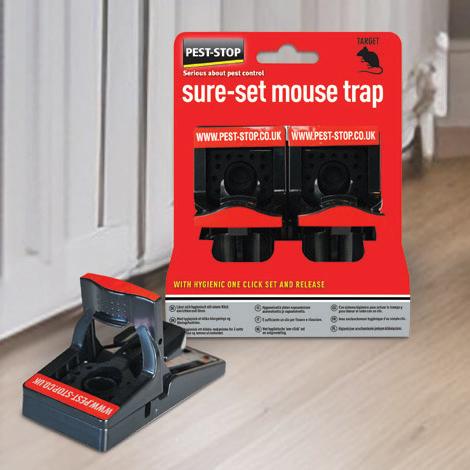

































Pest-Stop is the brand of choice for DIY pest control. Our range has delivered simple and effective pest management solutions for the home and garden for over 100 years. Our comprehensive range of quality products includes traditional pest control methods, live catch, and deterrents. Our products are tried-and-tested by both DIY’ers and professionals.

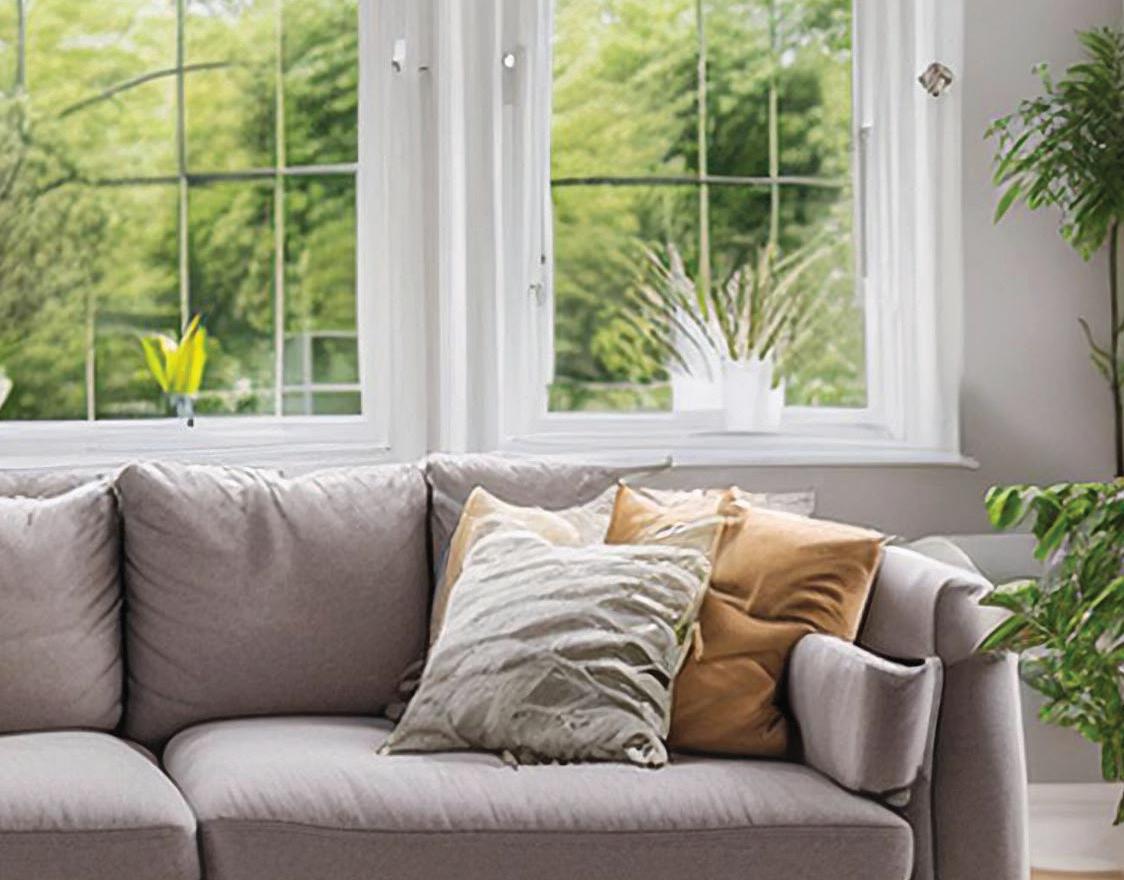





































You can’t always choose who visits you in the holiday season, but the last thing you want is an invasion of pests
Rodents can be a problem at any time of year, but their activity peaks between October and February as the weather gets colder and they seek warmth, shelter, and food sources. They can reproduce very quickly, so you can go from a pair to a fullblown infestation very quickly.
The problem is that from early autumn, rodents start seeking entry points into homes and buildings, and by halfway through the season, they are well established and ranging out to look for food such as le overs, crumbs, and birdseed in gardens. Once settled they will start breeding by late winter.
O en the only practical solution is to use a rodenticide, ideally placed in tamperproof bait stations. These should be placed securely in areas with rodent activities like basements, attics, or anywhere signs of
infestation are visible, such as droppings, tail marks, and pathways.
There are di erent forms of bait available to suit various environments; for instance weather-resistant block baits are ideal for larger infestations, both indoors and outdoors environments. These will deliver a lethal dose of rodenticide in two or three feeds. O en blocks like this have a hole running through the middle, allowing them to be safely secured onto a baiting rod and contained inside a tamper-resistant bait station.
Also for use in a secure bait station, chewthrough sachets can provide faster results.
For hard-to-reach spots, paste bait provides a flexible solution. This could even be used safely in environments where children and pets may sometimes
be present, so long as it is secured in a bait station.
Other more high-tech solutions to pest control are undeniably ingenious; for instance USB-rechargeable electrical rat and mouse killers housing sensing plates which deliver a lethal high voltage shock that kills a pest in a matter of seconds. Usefully, there’s a safety protection switch, in order to prevent shocks to people or pets.
If you are more squeamish, also available are electronic repellers which emit ultrasonic or electromagnetic waves to make pests uncomfortable enough to want to move house; these can work for a range of pests from mice to moths, mosquitoes and fleas.
It’s worth remembering that blocking entry points for rodents using sealants can cut down on the necessity for laying traps in the first place!



















































A garden room can add value and utility to your property. How are they constructed and how could you use them?

Agarden room – which is basically a much more substantial and permanent structure than a shed – can have all sorts of applications, from a gym or studio to a reading room or hobby shop. The main point is that they can add value and utility to your home without the disruption of building an extension or a conversion.
In most cases, no planning permission is needed for a garden room as it would come under permitted development regulations, though your supplier will be able to advise you on exceptions such as listed buildings or conservation ground.
The great thing about garden rooms is that they can be used for any purpose, you just decide what sort of facilities they need – for instance power and lighting
would usually be essential, but for a teenage den or guest bedroom you could also opt for heating underfloor or from radiators, air conditioning, and even water and waste disposal for bathroom/kitchen facilities - the choice is yours.
While most garden rooms would be waterproofed as a matter of course, you may also opt to have them soundproofed, if perhaps you want to run a music studio, party room or home cinema setup.
It’s also perfectly possible to run a business such as a nail or beauty salon or therapy suite from a garden room, and of course they are increasingly popular as office spaces since home working has become a trend.
There are various construction options
- a concrete base is not always required and it’s even possible to install a garden room on sloping ground. If you need extra protection from rain or sunlight, a ‘flyover’ roof is a popular option.
PVC is a common construction material for garden rooms, so maintenance requirements are low. A garden room may cost you something like £20,000 to install, certainly a competitive option measured against the cost of a property extension or a loft conversion, and in some cases you will be able to disassemble it and take it with you when you move!
Bear in mind that you can rent out a garden room, or offer it through services like Airbnb, but it will have to meet more stringent planning requirements, building regulations and health and safety standards. ■





Back in 2020, Booths Garden Studios sought expert advice and took great care to design annexes to meet the legal definition of a caravan. A caravan can be sited within the garden of a dwelling and used for purposes incidental to the house without planning permission.
Since 2020, Booths have installed hundreds of annexes all over England, plus Scotland, Wales and Ireland.
The Caravan Sites Act allows for; “A structure designed or adapted for human habitation which:
a) Is composed of not more than two sections separately constructed and designed to be assembled on a site by means of bolts, clamps or other devices; and
b) Is, when assembled, physically capable of being moved by road from one place to another (whether by being towed, or by being transported on a motor vehicle or trailer).”
The Booths Annexes are designed to fit this criteria.
Booths annexes do not need extensive foundations or connections to the ground and are capable of being moved when assembled. They are often used by a customer for several years but then sold on to a new customer. This means the original customer can recover some of the original costs of purchase. There is not another supplier in the UK that offers this flexibility and service. On top of that, the Annexes come with a 25 year guarantee which is the longest guarantee in the UK. Booths are able to offer this length of guarantee because of the modern materials used during manufacture.
The exterior of the annexes are truly zero maintenance so there is no timber to have to paint or stain.

This time, Martin’s plans to rope in his son on some building work turn into a practical idea for starting up a business
Last weekend I asked my 17-year-old son to come and help me put up a garden fence. He decided to ask three of his mates to come along, and the four of them, with my guidance, spent three hilarious hours digging holes, concreting in posts and screwing in fence panels.
I taught them lots of tricks that I’ve learned over the years and showed them how to do the first couple. But after that they were off and running, and I think if I’d left them, the Great wall of Midsomer Norton would be currently still under
construction, snaking down and across the Mendips.
Seriously, they loved it and actually said ‘This is great, because we would have only been on our devices’ (phones, tablets, computers etc)’. I told them that to get somebody in to do the work would probably have cost me many hundreds or thousands of pounds, so not only was doing it ourselves very fulfilling, there was also a massive cost saving advantage. Their minds started whirring, and soon the conversation between them turned to setting up a fencing company.
The following day, I put a post out on my Twitter account, just explaining the scenario and how I felt that it really highlighted the fact that providing practical apprenticeships can have such a positive impact on young people. Clearly, this is a subject very close to many people’s hearts, as that modest post has currently had 380k views, 13k likes, 618 reposts and 338 comments - virtually all of which are agreeing with me that teaching youngsters practical skills like this is such a good thing on so many different levels.
As you may know, I’m currently renovating and refurbishing a pub and hotel in the Rhondda Valley, and one of the most significant parts of that project for me has been that we’ve given disengaged 1517 year old local kids the chance to come in and get practical construction experience - ending with them being awarded a recognised practical construction industry qualification that is respected by employers and allows them to work on building sites.
There are apprenticeships for many aspects of the construction industryfrom roofing to electrics, carpentry to plumbing - and various industry bodies do promote these. But unfortunately, they’re often limited to those aged 16 or in some cases 18. So, if you’re younger - such as the kids working in my pub - your only option is to stick it out at school full time until you can go to college (where there’s the possibility of day release), which might not be everyone’s cup of tea.
Given my practical experience of the huge benefits that providing an alternative
educational route brings - one not routed in algebra or text-books - I feel there’s a huge gap in offering opportunities to kids much more suited to learning practical skills and want to do everything I can to try and formalise this process.
You only have to look to our Scandinavian neighbours to see a successful model in operation. Here children as young as 15 are able to follow an alternative pathway which combines traditional studies (on a part time basis) with practical apprenticeship type courses.
The reality is that some people need to be given the opportunity to come out of the traditional educational system sooner and start getting practical experience younger, while still carrying on with their studies in English and Maths - which everyone accepts has to be a basis for education.
The reality is these children are probably not very motivated being shoehorned into the traditional system. Their self-esteem will have taken a
complete battering, they may be in the lowest sets and made to feel like they are losers or inferior to their peers. That’s not the case! They just haven’t found their calling because they are much more practical than academic.
Clearly, you would have to ensure that these kids are suitably supervised, and all the necessary safeguards are in place to ensure they had a fulfilling and safe experience - but at least if there was an option, the children for whom it is undoubtedly the right choice, would have another option than to attend school full time.
From my own experience with the kids at the pub, ironically, many of them who worked with us have actually gone back into education with an improved mindset, self-belief, and understanding of the benefits!
Let’s see who we can engage with to try and make this adjustment. I’m sure there are a multitude of hurdles, but every project has to start with the foundations! ■

£5-10k fine if properties are below EPC E. Mandatory increase to EPC C by 2030 under current government plans.











• Fully remote property assessment using cutting edge technology: 2.3 bn data points with 95%+ accurate EPC predictions.
• Understand your options – cost and benefits of upgrades.
• Full on-site inspection - well beyond EPC survey.
• Confirmed scope of works – detailed recommendations and ready order costs.
• Identify any eligible grants
management throughout the works.
and efficiently manage the timeline and budget.
to specification.
